Issue 35 November 2013
Worcestershire Record | 35 (November 2013) page: 20 | Worcestershire Biological Records Centre & Worcestershire Recorders
Dragonflies in Worcestershire 2013
Mike Averill
It seemed like a very long cold winter this year (2012-2013) and the lateness of any dragonfly records reflected this. Following a cold start in January and February, March was one of the coldest months since the 1960’s. Relentlessly the cold weather continued into April and then finally temperatures began struggle in to double figures in the third week of that month. Just as some species were beginning to appear it turned cooler again for a couple of weeks in mid May, only perking up at the end of the month. In terms of dragonfly emergences, this had a dramatic effect delaying all species by between one and six weeks compared to the earliest times in 2008-2012 (Table 1), except for the Small Red-eyed Damselfly which emerges later in the year anyway.
In terms of individual species, all the regular species were seen plus an occasional uncommon one: the Red-veined Darter which was seen at Grimley but not at its usual location at Pirton. The Club-tailed Dragonfly was 17 days late to emerge and the numbers counted were somewhat lower so perhaps some individuals will have delayed their emergence until next year. This can happen with a species that has a synchronised emergence because it is important for all the males and females to emerge together. This is particularly vital for a species like this that disperses widely after emergence. The Beautiful Demoiselle seems to expand its range each year appearing in more locations on the River Severn and even at Yardley near the River Cole. Croome Court had less Small-red Eyed Damselflies than last year but the same species was also seen at Lower Smite Farm. The fact that this species wasn’t late emerging compared to other years may be explained by the fact that it normally emerges later in the summer and so would have had time to recover from the early cold spell. The Four-spotted Chaser tends to pop up in more locations than it used to so it was nice to have proven breeding reports from Penny Hill, near Martley.
The unexpected arrival of the Scarce Chaser at Hillditch Pool, Hartlebury in 2012 gave rise to the possibility of a breeding colony there and so it was with excitement that the first larval cases were found in June this year. Whether such a small group will be self sustaining will make an interesting case study.
Dragonflies attracted to moth traps are not all that common and certainly not as common as in the United States where warm evenings and crepuscular activity often leads to dragonflies being drawn to light. In Worcestershire we had two instances via Val Weston this year: a Brown Hawker in Acocks Green and a Common Darter at Monkwood. This is nothing to do with feeding of course, merely the response to light in the way that birds and other day flying insects are attracted to lighthouses or ships lights.
For those who are eagerly awaiting the new national Dragonfly Atlas, the launch date will be May 2014 and a pre publication offer can be found at: http://www.field-studies-council.org/publications/pubs/atlas-of-dragonflies-in-britain-and-ireland.aspx
| Common Name | Scientific Name | Earliest sighting 2008-12 | Earliest sighting 2013 | Days later than 2008-12 |
| Large Red Damselfly | Pyrrhosoma nymphula | 09/04/2011 | 04/05/2013 | 25 |
| Beautiful Demoiselle | Calopteryx virgo | 23/04/2011 | 22/05/2013 | 29 |
| Blue-tailed Damselfly | Ischnura elegans | 23/04/2011 | 22/05/2013 | 29 |
| Common Blue Damselfly | Enallagma cyathigerum | 23/04/2011 | 13/05/2013 | 20 |
| Azure Damselfly | Coenagrion puella | 24/04/2009 | 25/05/2013 | 31 |
| Banded Demoiselle | Calopteryx splendens | 26/04/2011 | 25/05/2013 | 29 |
| Red-eyed Damselfly | Erythromma najas | 26/04/2011 | 22/05/2013 | 26 |
| Broad-bodied Chaser | Libellula depressa | 26/04/2011 | 01/06/2013 | 36 |
| Four-spotted Chaser | Libellula quadrimaculata | 02/05/2011 | 31/05/2013 | 29 |
| Common Club-tail | Gomphus vulgatissimus | 03/05/2011 | 20/05/2013 | 17 |
| Hairy Dragonfly | Brachytron pratense | 05/05/2011 | Not Seen | |
| White-legged Damselfly | Platycnemis pennipes | 08/05/2009 | 03/06/2013 | 26 |
| Black-tailed Skimmer | Orthetrum cancellatum | 08/05/2011 | 04/06/2013 | 26 |
| Southern Hawker | Aeshna cyanea | 14/05/2012 | 29/06/2013 | 46 |
| Scarce Chaser | Libellula fulva | 22/05/2011 | 09/06/2013 | 18 |
| Brown Hawker | Aeshna grandis | 24/05/2009 | 30/06/2013 | 34 |
| Emperor Dragonfly | Anax imperator | 30/05/2008 | 08/06/2013 | 8 |
| Common Darter | Sympetrum striolatum | 30/05/2008 | 30/06/2013 | 30 |
| Red-veined Darter | Sympetrum fonscolombii | 31/05/2009 | 17/06/2013 | Migrant |
| Golden-ringed Dragonfly | Cordulegaster boltonii | 09/06/2012 | 12/07/2013 | 1 record |
| Emerald Damselfly | Lestes sponsa | 15/06/2011 | 29/06/2013 | 14 |
| Ruddy Darter | Sympetrum sanguineum | 16/06/2010 | 09/07/2013 | 23 |
| Common Hawker | Aeshna juncea | 26/06/2010 | Not Seen | |
| Lesser Emperor | Anax parthenope | 07/07/2011 | Not Seen | |
| Small Red-eyed Damselfly | Erythromma viridulum | 11/07/2011 | 14/07/2013 | 3 |
| Migrant Hawker | Aeshna mixta | 22/07/2009 | 07/08/2013 | 16 |
| Black Darter | Sympetrum danae | 12/09/2009 | Not Seen |
Table 1. Dragonfly emergence dates. 2008-2012 compared with 2013.
Worcestershire Record | 35 (November 2013) page: 20 | Worcestershire Biological Records Centre & Worcestershire Recorders
Worcestershire Record | 35 (November 2013) page: 6-8 | Worcestershire Biological Records Centre & Worcestershire Recorders
Introduction to the Noble Chafer Gnorimus nobilis (Linnaeus, 1758) Leverhulme research project
Adam Bates1, Max Blake2, Deborah Harvey3, Laura Bower4, Lauren Alexander4, Lloyd Jenkins1, Jon Sadler1*, Niall McKeown2, Paul Shaw2, Alan Gange3 and Harry Green5
1 The University of Birmingham, * Project lead, 2 Aberystwyth University, 3Royal Holloway, University of London, 4 People’s Trust for Endangered Species (PTES), and 5 Worcestershire Biological Records Centre (WBRC).
Worcestershire’s natural heritage is the product of centuries of interaction between the natural environment and human land use. The last 50 years have been characterised by a decline in traditional farming methods, posing a threat to landscape and cultural heritage, and to the habitats and diversity of species that have developed in tandem over many centuries. This issue is well illustrated in the production of orchard fruits, for which changing markets have led to traditional orchards being grubbed out and replaced by more economically profitable crops and more commercially viable fruit stock. This decline in traditional orchards is of concern both because of the loss of irreplaceable cultural resources, and the loss of an important habitat akin to wood pasture. One species of conservation concern, and a local Worcestershire speciality, is the Noble Chafer beetle Gnorimus nobilis(Linnaeus, 1758) (01), believed to have declined in abundance and distribution due to its orchard habitat deterioration, habitat loss and, perhaps, fragmentation of habitat.
The Leverhulme Trust funded project entitled ‘Integrating ecology and social science in conservation: Orchards, beetles, and agroecology’ started in October 2012, and focuses on the ecology of the Noble Chafer and the management of the traditional orchards with which it is associated. The project partners are the University of Birmingham, Aberystwyth University, Royal Holloway University of London, and the People’s Trust for Endangered Species (PTES), but it has benefited from close collaboration with the Worcestershire Biological Records Centre (WBRC), Worcestershire Wildlife Trust and Vale Landscape Heritage Trust amongst various other groups. As the project title suggests, the project encompasses ecological and social science approaches to the study of the Noble Chafer and traditional orchard management. The simultaneous study of one insect species and its habitat by so many people of varying disciplines is unusual, and a golden opportunity for better understanding the ecology of the Noble Chafer alongside the wider cultural and biological significance of orchards.
As with many species in the Worcestershire landscape, the fate of the Noble Chafer is strongly dependent on the management decisions taken by people. So an understanding of the motivation behind, and techniques used for, orchard management across the wide-ranging stakeholders (e.g. conservationists, cider producers, county councils) is essential if such species are to be conserved in the working landscape. Through informal semi-structured interviews in the county, we will explore the range of attitudes and approaches in orchard management, to better understand why some stakeholders see the conservation of species such as the Noble Chafer as an associated or more important goal than simple productivity maximisation.
Much about the ecology of Noble Chafer larvae and adults in and around their main orchard habitat remains relatively poorly known. Thanks to distinctive larval frass (droppings), the recent presence of Noble Chafer in rot holes and other deadwood features can be determined, and this has facilitated the gathering of good knowledge of Noble Chafer distribution in many areas, and can be used to investigate tree and orchard habitat features associated with Noble Chafer occupancy. However, frass could potentially be present in deadwood for some time after Noble Chafer have stopped using the tree, and the presence of frass gives little information about the abundance of larvae in a tree. We are therefore using techniques to identify larval pheromones that will help to monitor larvae without disrupting the deadwood habitat or larvae.
Noble Chafer adults are relatively easy to spot when the observer is in the right place at the right time, and can be tagged relatively easily to differentiate individuals. This has allowed us to gather data on the weather conditions and time of day when adults are able to feed and fly. Controls on dispersal and feeding may influence population fitness by determining migration ability and perhaps the fecundity of adults. Being in the right place at the right time tends to require considerable observer effort, and observers cannot be in multiple places at once. Therefore we are developing methods to capture adults using pheromone attractants. This will allow the identification of orchards currently occupied by Noble Chafer and the estimation of the size of populations using capture, mark, release methods. Such detection methods are likely to be particularly useful for Noble Chafer monitoring where populations are patchily distributed and the flight season is quite short.
This smaller scale work will be complemented by investigation of the landscape scale variables influencing Noble Chafer distribution using biological records and orchard survey records collected over many years. These records will be incorporated into a geographical information system (GIS) of the region to create data on the amount of coverage of built areas, woodland, and other orchards at a variety of spatial scales. The current distribution of Noble Chafer is very likely to be influenced by the historical distribution of orchards in the region, perhaps representing a kind of ghost of landscapes past. So historical data will be included in the GIS (e.g. 02.) and its influence on current distributions investigated. This historical component also provides a direct link to the strand of the project using molecular genetics approaches.
Direct knowledge of the pre-historic distribution and habitat of Noble Chafer before widespread human landscape change is lost. However, following human alteration of the landscape, and before the wide-spread planting of orchards, it seems likely that Noble Chafer (based on the ecology of other Eurasian populations, and sub-fossil beetles found in bog Oaks) used open wood pasture as its primary habitat in the UK. At some point in time the primary habitat choice of this species switched to orchards, which for a relatively brief period (in evolutionary terms) covered large areas of the Worcestershire landscape. The recent loss of orchards has perhaps isolated Noble Chafer habitat to such an extent that adults are now unable to easily disperse between habitat patches. This is likely to have led to the genetic character of different populations becoming distinct, and perhaps even to genetic biodiversity loss resulting from inbreeding. We plan to use modern genetic methods (DNA “fingerprinting”) to reconstruct the species’ past and present ecology and population dynamics. If evidence suggests that between-habitat dispersal is rare, conservation efforts should aim to preserve habitat connectivity in the Worcestershire landscape. If the evidence suggests frequent long-distance dispersal between habitats, then conservation efforts can focus more closely on improving habitat conditions in orchard reserves.
Large-scale removal of Noble Chafer individuals for DNA analysis could reduce the fitness of local populations, which would be unacceptable given the conservation importance of this species. So at the start of the project our objective was to develop new methods to obtain Noble Chafer genetic material non-invasively from its distinctive larval frass (droppings), i.e. avoiding mass sampling of living individuals. Remarkably, we found that frass often yields enough DNA to test how genetic diversity of Noble Chafer varies between populations separated by varying distance across the country. However, for some important methods frass-derived DNA is too degraded to use, and so we need to source DNA from adult tissue. Lethal sampling of insects can be controversial, but this project is aiming to be completely ‘no-kill’: small numbers of adults can be taken into captivity from strong populations, used to establish breeding colonies and then removed for genetic analysis only when they die. This procedure will let us study the adults and resulting larvae in captivity to learn more about species biology and ecology, as well as providing stock populations from which reintroductions to the wild can be made if necessary.
How people can help
Investigation of the habitat and landscape variables influencing the distribution of Noble Chafer is only possible thanks to the work of the many people over many years who have gathered records of Noble Chafer frass, larvae and adults, and documented associated habitat characteristics. Such records are, of course, never complete, and there is always scope for people to add to the body of knowledge of the distribution of Noble Chafer and traditional orchards. In particular, there are two ways to help: 1. send records of Noble Chafer frass and adults to the WBRC; and 2. volunteering to survey orchards as part of the PTES traditional orchards survey.
1. Recording Noble Chafer
The easiest way to detect the presence of Noble Chafer in an orchard is by the discovery of its distinctive frass. Described as being a little like coffee granules, the hard frass of Noble Chafer gathers in rot holes and other crevices of trees that are occupied by the beetle larvae (3.), and can be sampled from the surface of wood mulch using a long-handled spoon. Samples can be sent to the WBRC for confirmation and some samples are passed on to Aberystwyth University for genetic analysis. Some stages of the Noble Chafer life-cycle, particularly the eggs and pupae, can be damaged by exploration of wood mulch, so gathering larval records is discouraged. Adults are most easily spotted feeding on Common Hogweed Heracleum sphondylium L., Elder Sambucus nigra L., and Meadowsweet Filipendula ulmaria (L.) Maxim. in June, July and early August. Preliminary results from the study suggest that the weather does not have to be warm for this (particularly when close to the host orchard), and that the morning and early afternoon are the best times to see them. Adults can be reliably sexed in the field using two main characteristics: the shape of the meta-tibia (middle leg) (04 & 05) and the presence or absence of a notch on the pygidium (end of abdomen) (06 & 07). The easiest way to remember which is which is to remember that the male is on top during copulation, and uses its characteristic middle legs to help lock onto the back of the female, which fits snugly into the males’ bowed middle legs (08).
2. PTES orchard surveys
Using a combination of recent and old maps, and aerial photographs, the PTES have created a map of the location and shape of all the likely traditional orchards for the whole of England and Wales. Through lots of volunteer effort, many of these orchards have been ground-truthed and surveyed for habitat character and signs of Noble Chafer. However, many orchards in Worcestershire still need surveying, so every new volunteer is important. People who are interested in volunteering can contact Lauren Alexander at the PTES (www.ptes.org/orchards, lauren.alexander@ptes.org, 020 74984533).
Goals of the project
The aim of the project is to use the knowledge gained of the ecology, distribution and management of Noble Chafer to better inform future conservation of this species. We hope to be able to answer questions such as:
What motivations do multiple stakeholders share for management practises that favour Noble Chafer conservation, and how can these motivations be encouraged?
What orchard management practises create the most favourable Noble Chafer habitat?
How do suitable orchard habitats need to be distributed in the Worcestershire landscape to ensure the continued success of this species?
How might different future scenarios of landscape change affect Noble Chafer populations in Worcestershire?
Acknowledgements
The authors would like to thank Worcestershire Wildlife Trust, Vale Landscape Heritage Trust, Natural England, Wyre Forest Study Group, and Cedric and Thelma Qualye for helping to track down and/or providing access to intensive study sites; and the Leverhulme Trust for funding this research. We would also like to thank all the people that have given up their time to provide samples for the study (in particular Jenny Schenke), and participate in semi-structured interviews. This work will hopefully build upon the large body of information gathered on Noble Chafer and orchard ecology by a number of volunteers and investigators over many years.
Images
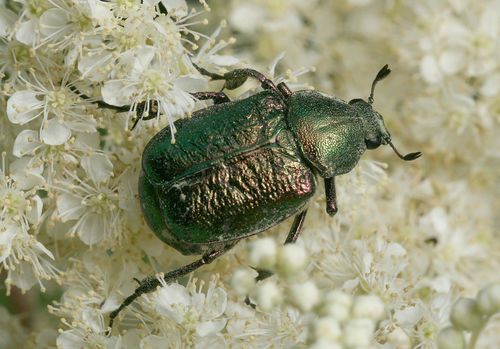 01. Male Noble Chafer feeding on Meadowsweet Filipendula ulmaria (L.) Maxim., illustrating the distinctive male meta-tibia and lack of notched pygidium, photograph by David Shute.
01. Male Noble Chafer feeding on Meadowsweet Filipendula ulmaria (L.) Maxim., illustrating the distinctive male meta-tibia and lack of notched pygidium, photograph by David Shute.
 02. Example distribution map of top fruit orchard cover in 1932.
02. Example distribution map of top fruit orchard cover in 1932.
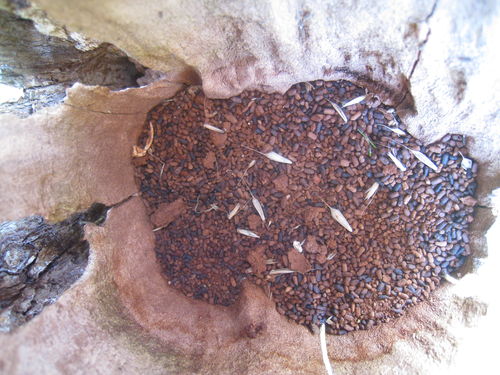 03. Frass of Noble Chafer larvae in a hollow plum trunk, photograph Adam Bates. Beware, frass is not always as easy as this to find, often there is far less frass than this.
03. Frass of Noble Chafer larvae in a hollow plum trunk, photograph Adam Bates. Beware, frass is not always as easy as this to find, often there is far less frass than this.
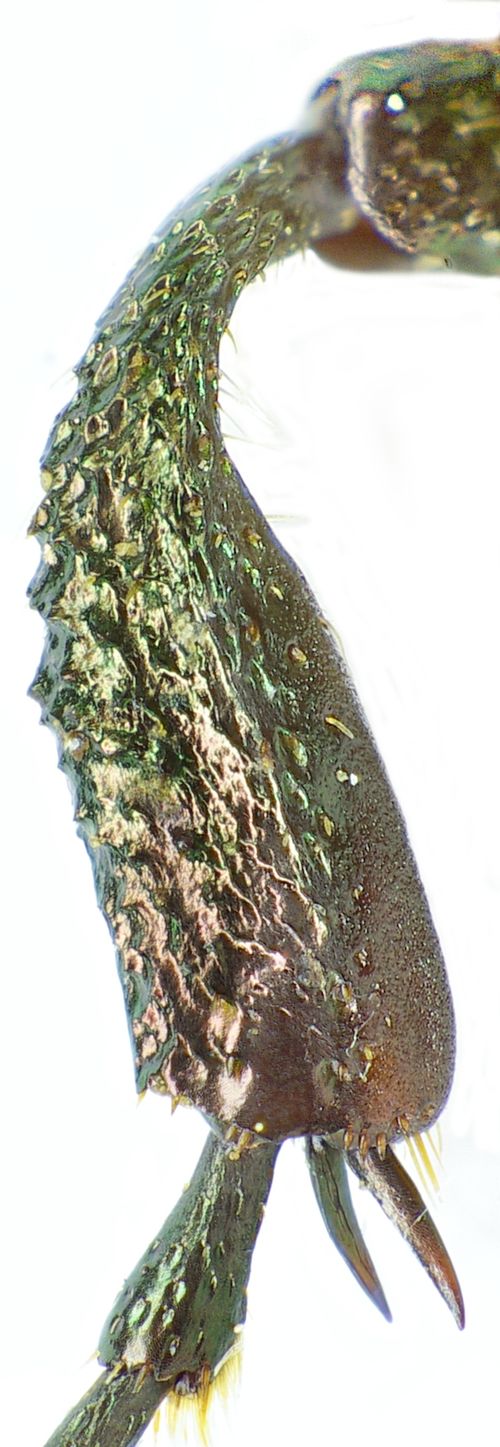 04. Gnorimus nobilis male mesotibia (middle section of middle leg). By Siga
04. Gnorimus nobilis male mesotibia (middle section of middle leg). By Siga
 05 Gnorimus nobilis female mesotibia (middle section of middle leg). By Siga
05 Gnorimus nobilis female mesotibia (middle section of middle leg). By Siga
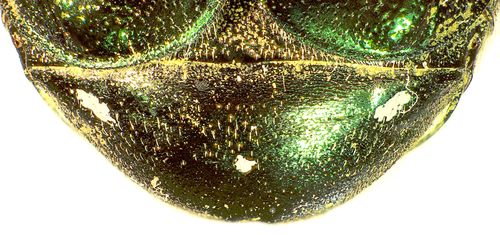 06. Gnorimus nobilis male pygidium (upper surface of the tip of the abdomen). By Siga
06. Gnorimus nobilis male pygidium (upper surface of the tip of the abdomen). By Siga
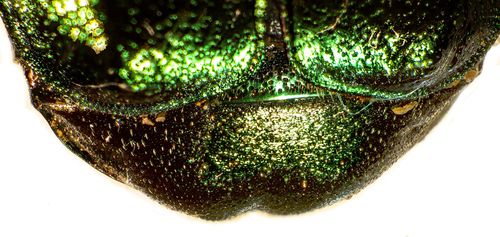 07. Gnorimus nobilis female pygidium (upper surface of the tip of the abdomen). By Siga
07. Gnorimus nobilis female pygidium (upper surface of the tip of the abdomen). By Siga
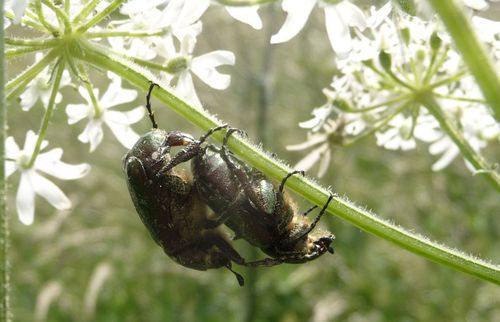 08 Gnorimus nobilis copulating pair underneath a Hogweed flower head. Harry Green.
08 Gnorimus nobilis copulating pair underneath a Hogweed flower head. Harry Green.
Worcestershire Record | 35 (November 2013) page: 28 | Worcestershire Biological Records Centre & Worcestershire Recorders
Pediopsis tiliae (Germar, 1831) Lime Leafhopper in Worcestershire.
John Bingham & Denise Bingham
Family: Cicadellidae.Homoptera leafhopper (Lime leafhopper). Nationally Notable B.
This small leafhopper (length 5-6 mm) (01) was swept up by Denise Bingham on 27 July 2013 at Shrawley Wood, Worcestershire. The site was a woodland ride with tall herbage under a canopy of small-leaved lime Tilia cordata.
According to Auchenorrhyncha Recording Scheme this appears to be the second record for Worcestershire with a previous record from SO94, somewhere near Pershore. Widely distributed but scarce in southern Britain, including the south-east Midlands and associated with lime trees Tilia, particularly small-leaved lime (British Bugs web site). The leafhopper is National Scarce B. This record is towards the limit of the currently known distribution (02) although Dr Alan Stewart has recently recorded it at Preston Montford, Shropshire (SJ41).
The species is quite striking with the bright yellow and brown markings. Although according to British Bugs web site some species of Macropsis or Oncopsis can look superficially similar, the combination of the plain yellow face and brown wings is distinctive.
With so much Tilia in Worcestershire this leafhopper may turn out to be a fairly common species, but clearly it’s not recorded often. It is adult from June to September.
Acknowledgements.
Many thanks to Dr Joe Botting at British Bugs who confirmed our identification and Dr Alan Stewart (Auchenorrhyncha recording scheme) for information on the distribution.
References and information
British Bugs at http://www.britishbugs.org.uk/
Auchenorrhyncha Recording Scheme http://www.ledra.co.uk/index.html
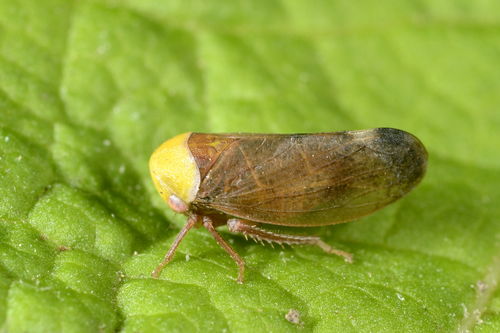 01.Pediopsis tiliae Shrawley Wood. John Bingham
01.Pediopsis tiliae Shrawley Wood. John Bingham
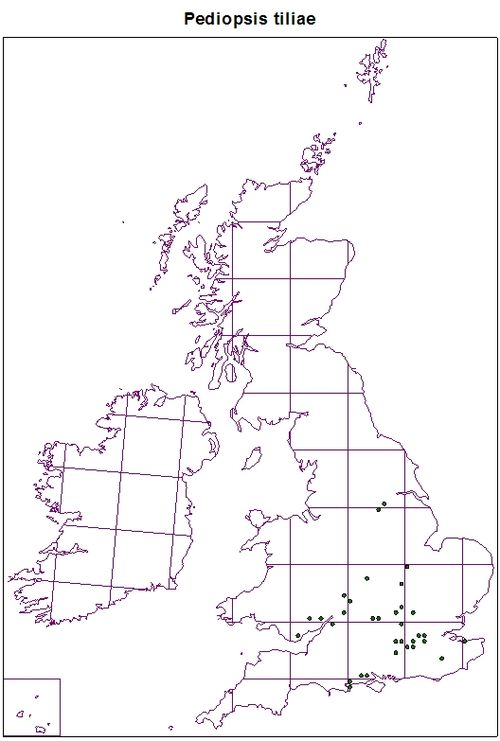 02. Pediopsis tiliae national distribution
02. Pediopsis tiliae national distribution
Worcestershire Record | 35 (November 2013) page: 18 | Worcestershire Biological Records Centre & Worcestershire Recorders
Hoof Fungus Fomes fomentarius an update
John Bingham
In the Worcestershire Record of November 2011 (Bingham 2011) I reported on Alan Brown’s discovery of Fomes fomentarius (Hoof Fungus) on the Devil’s Spittleful Nature Reserve near Kidderminster. The fungus was discovered to be present on quite a few mature birch Betula pendula trees scattered around the Devil’s Spittleful rock. Thankfully many of the old trees were retained during the heathland restoration works and the fungus has so far survived at the site. At the time I wondered if this predominantly northern species was overlooked in Worcestershire with possibly more sites occurring on the sandy soils around the Kidderminster area.
During a fungus foray to Kingsford County Park north of Kidderminster on the very border with Staffordshire on the 10 September 2013 I chanced on another group of Fomes fomentarius growing on suitable old and over mature birch trees, including some fallen birch trunks. The area was mature secondary woodland and no doubt it would have been heathland in the not too distant past. Again, the site was on sandy soil and free draining. So if anyone is visiting secondary woodland on the sandstones of Kidderminster keep a look out for Fomes, it might well be quite a common species but restricted to growing over mature birch trees.
Reference
Bingham, J. 2011. Hoof Fungus Fomes fomentarius at the Devil’s Spittleful Nature Reserve. Worcestershire Record 31:26.
Worcestershire Record | 35 (November 2013) page: 18 | Worcestershire Biological Records Centre & Worcestershire Recorders
Worcestershire Record | 35 (November 2013) page: 36-37 | Worcestershire Biological Records Centre & Worcestershire Recorders
Notes on some invertebrates found in Worcestershire in 2013
John Bingham and Denise Bingham
The cold dull spring of 2013 was a disappointing time for finding invertebrates and although the summer weather improved species seemed to remain elusive.
Silpha tristis, Illiger, 1798. Silphidae: Coeloptera. Local (01).
Found at Shrawley Wood on 7 May 2013 under tree canopy on woodland herbage. Silpha tristis is very similar to the more common Silpha atrata, however S. tristis is slightly larger and has more even puncturation on the pronutum and elytra. Although rare it appears to have been recorded quite a few times in Worcestershire. Alan Brown reported good numbers from Springfield Park, Kidderminster (Brown 2012). Rosemary Winnall reported one from Ismere, near Kidderminster and another from Longdon Wood, Wyre Forest,(Shropshire) both taken in May 2010 (Pers.comm.). Brett Westwood also reported a sighting near Kidderminster. (Pers. comm). It might be worthwhile collating all the records as this species may be locally common.
Paederus fuscipes, Curt,1840. Staphylinidae:Coleoptera National Scarce (02).
This colourful beetle was found on 16 July 2013 on bare mud at Wilden Marsh Nature Reserve, Kidderminster. Good numbers were seen scurrying over the wet mud and diving into the opening crevices. Thanks to Paul Whitehead for providing the identification, Paul’s comment on the species was “although Nationally Scarce is relatively frequently encountered in the county’s major river valleys and also at a number of ‘artificial’ wetlands across the region”.
This Genus of beetle apparently can cause a dermatitis or skin irritation resulting from contact with the beetle. Information from Wikipedia was quite interesting although I have no idea how correct this is or if it applies to our Paederus beetles in the UK.
Quote: Once pederin is on the skin from the initial beetle contact, it may also be spread elsewhere on the skin. Washing the hands and skin with soap and water is strongly recommended if contact with a rove beetle has occurred. Initial skin contact with pederin shows no immediate result. Within 12–36 hours, however, a reddish rash appears, which develops into blisters. Irritation, including crusting and scaling, may last from two to three weeks’. (Wikipedia). It appear to be more problematic in places like Iran where the beetles are common in some locations and may be the cause or source of one of the Biblical plagues! So take care if you find any Paederus beetles.
Arytaina genistae, Latreille,1804. Family: Psyllidae Broom Psyllid (03).
Collected by Denise Bingham on 3 August on the recording day at Devil’s Spittleful, Kidderminster. Beaten off broom Cytisus scopularia. According to British Bugs the dark streaks in the wing cells are a diagnostic feature. Length 3.5 mm. Found abundantly on broom and overwinters on conifers. Widespread and common in the UK. Our thanks to Dr Joe Botting for confirming the identification.
Athysanus argentarius, Metcalf, 1955 Family: Cicadellidae. Leafhopper (04).
This leafhopper was found by Denise Bingham on 3 August on the recording day at Devil’s Spittleful, Kidderminster beaten off broom Cytisus scopularia. A large pale straw-coloured species, length 6.5-8 mm, with a dark line parallel to the front of the vertex, continuing across the eyes. There is a narrow longitudinal line along the scutellum and posterior half of the pronotum, with intermittent lateral lines parallel to that. (British Bugs).
According to the British Bugs web page this species was considered scarce and confined to coastal areas in the south-east but now become established inland across parts of central and southern England and can be found in a variety of grassland habitats. Our thanks to Dr Joe Botting for confirming the identification..
Scymnus frontalis, Fabricius , 1787. Coccinellidae:Coleoptera: Ladybird (05).
This ladybird was swept up from long grass by Denise Bingham on 3 August on the recording day at Devil’s Spittleful, Kidderminster but not checked until after the meeting. Gary Farmer also independently found this species at the same meeting. So two records were obtained of this uncommon ladybird.
References and information
British Bugs. http://www.britishbugs.org.uk/
Auchenorrhyncha Recording Scheme. http://www.ledra.co.uk/index.html
Wikipedia information – http://en.wikipedia.org/wiki/Paederus_dermatitis
Brown, A. 2012 Coleoptera of note in the Kidderminster area, Winter 2011-2012. Worcestershire Record 33:13-19.
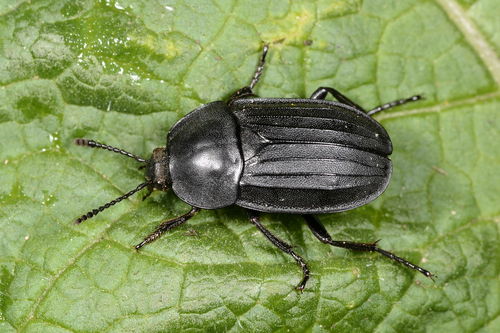 01. Silpha tristis. John Bingham
01. Silpha tristis. John Bingham
 02. Paederus fuscipes. John Bingham
02. Paederus fuscipes. John Bingham
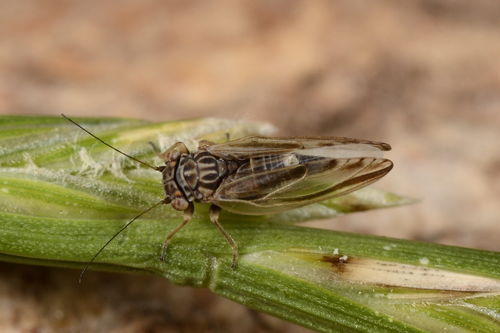 03. Arytaina genistae. John Bingham
03. Arytaina genistae. John Bingham
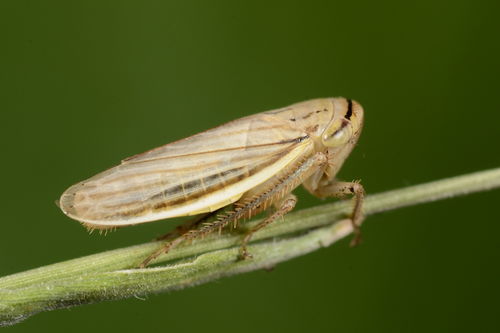 04. Athysanus argentarius. John Bingham
04. Athysanus argentarius. John Bingham
 05. Scymnus frontalis. John Bingham.
05. Scymnus frontalis. John Bingham.
Worcestershire Record | 35 (November 2013) page: 25-27 | Worcestershire Biological Records Centre & Worcestershire Recorders
Some interesting behaviour of two species of Carabus Ground Beetles
Alan Brown
While night-hunting for Ground Beetles down at the Devils Spittleful in Kidderminster I was given a really unique insight into some unusual behaviour by our two native Violet Ground Beetles, namely Carabus violaceus and Carabus problematicus.
Both species are adaptable to open as well as woodland habitats, but what I didn’t realise was that both species are partially arboreal, spending quite a bit of their time in trees. It may have been a rather naïve assumption by myself at the time, but I had always had the impression that these two large, flightless Ground Beetle species were strictly ground specialists, hence the name ground of the beetle group. But I got a surprise when I went looking for them at night with a headband torch. I soon began to realise that both these species are adept at climbing trees. Tree Slugs Limax marginatus seemed to be the preferred food item, the beetle having to hold its prey high in the air in order to make its way laboriously back down to ground level. But they are generalist predators and I also saw them with caterpillars, sawfly larvae, moths and even snake millipedes on occasion. They also tolerate each other’s presence on the same tree. I would sometimes find up to four individual beetles together investigating the same small patch of decaying wood, or find two feeding on the same food item, but never have I seen any aggression shown towards each other, which surprised me as well.
However, the most curious behaviour I observed happened in July and August when the sap-runs on the older oak trees came into their own. These sap-runs attract a number of insect species: moths, sap beetles and Lesser Stag Beetles Dorcas parallelipipedus. To my surprise I would regularly see Violet Ground Beetles gorging themselves on these same sap-runs until their abdomens became totally distended. They showed no interest in the moths or other insects feeding alongside them except to jostle for position with them for access. It was also noted that none of the other ground beetle species, especially the more arboreal Dromius or Spilotus types, took an interest in these same sap-runs. I met with the same scenario every time I went down there and observed this behaviour with both Carabus violaceus and Carabus problematicus and this wasn’t the only type of “nectar” source they used. I have also seen them tucking into over-ripe blackberries on the ground and chewing on developing leaf buds as well. Four oak sap-runs were kept under observation, each about five or six feet from the ground. Three of them were in the wooded area that surrounds the heath and the forth on an isolated oak on the heath itself. In both habitats Carabus problematicus was the most numerous Carabusspecies seen, with both Carabus violaceus and Cychrus caraboides being present in low numbers. In the spring large numbers of Carabus nemoraliscan also be found on the grassland areas of the heath, but sightings of this species usually tail off by July when the sap-runs come into their own.
Although the vast majority of Violet Ground Beetles sightings throughout the year at the site were made on the ground, I continued to find individuals scaling the trees, sometimes up to twenty feet from the ground, looking for prey. What I did notice was that their sharp tarsal claws are especially suited for gripping onto the bark of trees and it is not easy to dislodge them once they have a good grip. This activity probably does make them particularly vulnerable to owls, as they are to some extent exposed.
Of course I am only commenting on woodland behaviour and these two species of Violet Ground Beetle. They can survive just as well in gardens without sap-runs and without trees, which just goes to show how adaptable they are. At least in part sap-runs do seem to provide an extra food resource at the Devils Spittleful and also provide a unique insight into the behaviour of these two species. Although one photograph (1) shows Carabus problematicus jostling for position on a small sap seepage on an oak with a Lesser Stag Beetle, it is important to stress that no biting occurred even though this jostling went on for some time. A bite from a Lesser Stag Beetle is well capable of piercing the ground beetles armour however, so perhaps the ground beetle was putting itself in some danger here? Two other photographs (2 & 3) show a Carabus problematicus and Carabus violaceus at sap-runs about six feet from the ground. It usually took about half-an-hour for each one to ingest enough sap before its abdomen was totally distended and it decided that it had had enough. The last photograph (4) shows a Carabus problematicus on its way down a birch tree with a snake millipede (species unknown), extracted from the fissure shown on the left, six feet from the ground.
Images
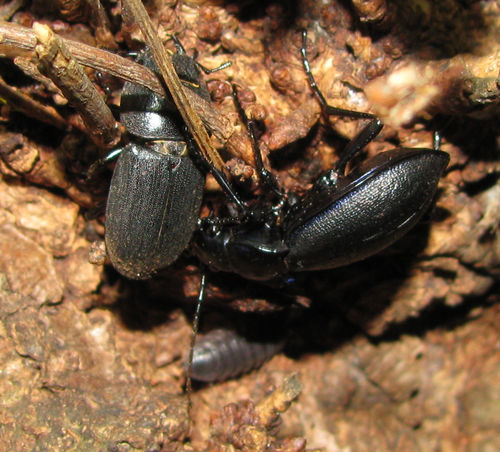
1 Carabus problematicus and Lesser Stag Beetle Dorcas parallelipipedus 1 Carabus problematicus and Lesser Stag Beetle Dorcas parallelipipedus jostling at sap-run. A. Brown

2 Carabus problematicus on sap run. A. Brown

3 Carabus violaceus on Oak sap-run. A. Brown
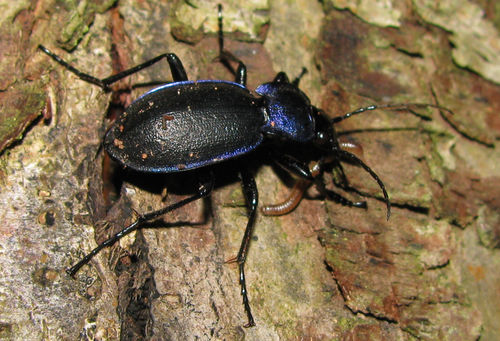
4 Carabus problematicus with snake millipede. A. Brown
Worcestershire Record | 35 (November 2013) page: 21-25 | Worcestershire Biological Records Centre & Worcestershire Recorders
Coleoptera of note found in the Kidderminster area 2010-2013
Alan Brown
In truth, for various reasons I was unable to conduct a proper survey in 2013 for notable beetle species and the time I did spend looking was mainly to try and find additional sites for the ant-associate hister beetle Haeterius ferrugineus. However, I did have enough material put by of species which for one reason or another didn’t appear in my previous articles. Some of these species are really good finds, whilst others are more widespread and some are county first records.
All these species were found at night with a headband torch and, unless stated, most were found to be active after dark on the surface of bark or on the ground. The smaller species are generally easier to spot when they are moving and much information regarding behaviour was also observed, making this ongoing survey a real bonus.
Curculio betulae: Curculionidae: Notable B: 6.8.2012. One of the catkin weevils this species is supposed to be a specialist of Birch catkins, but despite a thorough search I was unable to find it on this so I switched my search to Alder seed cones and found two almost immediately on trees at Puxton Marsh.
Platycis minutus: Lycidae: Notable B: 1.10.2012. A net-winged beetle. This is a diurnal species which seems to be spreading rapidly. Recently found at the Wyre Forest. This one was found inactive on a log in a very shaded area of wet-woodland at the Spennells Valley Nature Reserve (NR).
Tetratoma desmarestii: Tetratomidae: Notable B: 4.11.2012. A nocturnal fungus beetle and another winter active species. I found these on decaying oak branches infested with the Crust Fungus, Peniophora quercina in woodland at Springfield Park.
Melasis buprestoides: Eucnemidae: Notable B: 4.6.2012. A false click-beetle. I would usually find these literally boring their way into decaying Oak branches at the Devils Spittleful Nature Reserve, and on decaying Birch boughs at Hurcott Wood.
Epiphanus cornutus: Eucnemidae: local. A False Click-beetle and an accidental introduction which is rapidly increasing its range. Found on various decaying wood. I found this one on a decaying Beech log at Hurcott Wood.
Melandrya caraboides: Melandryidae: Notable B: 30.5.2012. A Darkling Beetle which is a diurnal species that develops in decaying wood. I found this one inactive at night on a decaying log infested with fungus in an open area of Springfield Park.
Arhopalus ferus: Cerambycidae: local: 28.6.2012. The Burnt Pine Longhorn. An introduced species which is nocturnal and extremely scarce in the Midlands. I was lucky to find this one investigating a dead-standing Pine tree in Hurcott Wood.
Poecilium alni: Cerambycidae: Notable B: 26.5.2012. The White-banded Longhorn. A rapidly spreading Longhorn beetle linked to decaying wood. I found this usually diurnal species on a large Oak stump at the Devils Spittleful NR. Length 6mm.
Saperda populnea: Cerambycidae: local: 15.5.2011. Small Poplar Borer. A local Longhorn beetle. I found this species on small Aspen saplings growing on grassland at the Devils Spittleful NR. Length:15mm.
Anaglyptus mysticus: Cerambycidae: Notable B: 19.5.2011. The Rufous-shouldered Longhorn beetle. I found this species hiding in a fissure on a Sycamore bough and also on a decaying Hawthorn trunk at Springfield Park. Length:10mm.
Phymatodes testaceus: Cerambycidae: local: 2.6.2011. Tanbark Borer. A nocturnal species, this is the orange colour variation for this species. I usually found this species investigating decaying Oak trunks and on a log-pile at Springfield Park . Length:18mm.
Platyrhinus resinosus: Anthribidae: Notable B: 2.6.2011. A fungus weevil. I came across a number of these linked to cramp-ball fungus on decaying beech logs, but also on a decaying ash stump with Dryads Saddle fungus in open parkland at Springfield Park.
Notaris scirpii: Curculionidae: Notable B: 6.4.2010. A herb-feeding weevil. I found a number of this Marshland species on Reed Sweet-grass and various other plants alongside Puxton Marsh.
Thanatophilus sinuatus: Silphidae: local : 1.10.2011. A seldom seen carrion beetle. I found a single specimen active at night on a dead pigeon alongside the Devils Spittleful NR.
Aphodius distinctus: Scarabaeidae: Notable B: 18.4.2011. A local dung beetle that seems to be doing well in my area. Linked to rabbit dung, I found this one on sandy heathland at the Devils Spittleful NR, but also on sandy, arable fields.
Aphodius zenkeri: Scarabaeidae: Notable B: 21.6.2011. A scarce dung beetle linked to deer dung. This species may be benefitting from the spread of the Muntjac Deer. I found this one on a pathway in Hurcott Wood and also saw another on the Devils Spittleful NR.
Aphodius ictericus: Scarabaeidae: Local: 22.4.2011. A local dung beetle. I found this one close to horse dung on open heathland at the Devils Spittleful NR.
Plegaderus vulneratus: Histeridae: scarce: 22.4.2010. A small hister beetle. A naturalised introduction, this species is thought to be predatory. Up to now it has been restricted to the east and south-east of the country. I found this species investigating beetle galleries on Pine. Species identified by Paul Whitehead. Length: 2mm
Plegaderus dissectus: Histeridae: Notable B: 28.6.2011. A small hister beetle usually linked to decaying deciduous trees. I found this species usually on damp, decaying birch stumps at the Devils Spittleful NR and at Hurcott Wood. Length: 2mm
Philonthus scitus: Staphylionidae: Notable B: 22.5.2012. A rove beetle linked to decaying wood situations. Found this predatory species on a decaying Oak tree at Springfield Park, but I’ve also seen it on a hollow Birch trunk at the Devils Spittleful NR.
Deleaster dichrous: Staphylionidae: Notable B: 12.8.2010. A predatory rove beetle found during my ground beetle survey. I found these alongside the River Severn in Bewdley on damp clay or sandy river margins, usually under grasses.
Orchesia micans: Melandryidae: local: 1.10.2012. A false darkling beetle that is usually in shaded woodland localities. I found a number of these active on a dead-standing Alder tree with fungus at the Spennells Valley NR in wet-woodland.
Orchesia minor: Melandryidae: Notable B: 6.7.2013. An uncommon false darkling beetle. I found this species in shaded woodland investigating a decaying Beech log with fungus at Hurcott Wood. Identification confirmed by Paul Whitehead. (No picture).
Hylastes ater: Scolytidae: local: 28.4.2013. A bark beetle linked to pine trees. I found a number of these actively investigating a decaying pine high-stump in a section of pine woodland at Hurcott Wood. Identification confirmed by Paul Whitehead. (No picture)
Hylastes opacus: Scolytidae: local : 28.4.2013. A bark beetle linked to various decaying wood situations. I found this one investigating some decaying bark on a Beech trunk near a section of pine woodland at Hurcott Wood. Identification confirmed by Paul Whitehead.
Variimorda villosa: Mordellidae: Notable B: 9.7.2012. A tumbling flower beetle. The adults feed on pollen but the larvae are predatory, feeding on bark beetle larvae in decaying wood. I found this adult on a decaying Sycamore tree, inactive at night. Hurcott Wood.
Ischnomera cyanea: Oedemeridae: Notable B: 27.5.2012. A handsome beetle usually found on flowers but like this one can also be found on bark beetle galleries laying its eggs. The larvae are predatory feeding on various bark beetle larvae. Found on a decaying Holly trunk. Spennells Valley NR.
Margarinotus purpurescens: Histeriidae: local: 15.5.2012. A hister beetle that is linked to mammal dung and decaying vegetable matter. It also seems to like dry, sandy areas around Kidderminster. I found this one on a sandy roadside verge.
HEMIPTERA
Empicoris vagabundus: Reduviidae : local: 1.10.2012. A Thread-legged Assassin bug. This is the most widespread and largest species, but surprisingly difficult to find. I have seen three of this predatory species to date, all were found in patches of woodland, two on Birch trunks and one on a Sycamore tree. Length: 7mm
Images
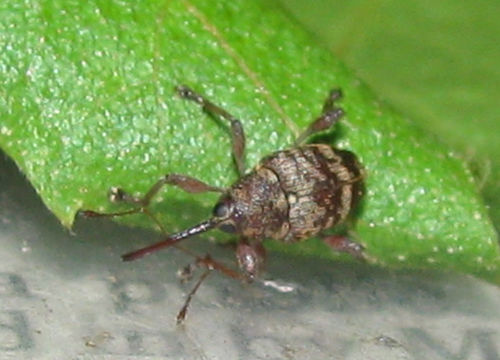
01 Curculio betulae: Curculionidae: Notable B: 6.8.2012.

02 Platycis minutus: Lycidae: Notable B: 1.10.2012
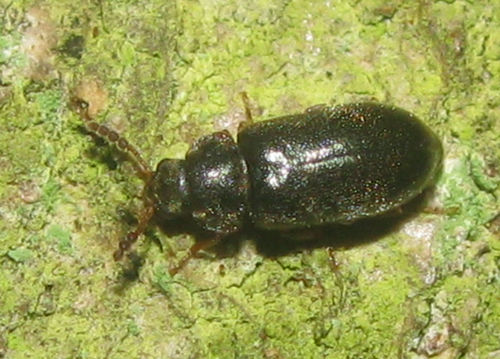
03 Tetratoma desmarestii: Tetratomidae: Notable B: 4.11.2012

04 Melasis buprestoides: Eucnemidae: Notable B: 4.6.2012.
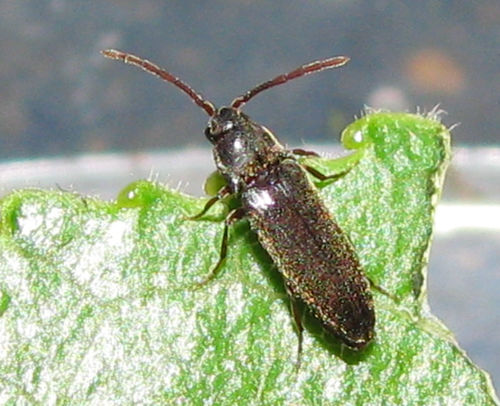
05 Epiphanus cornutus: Eucnemidae: local
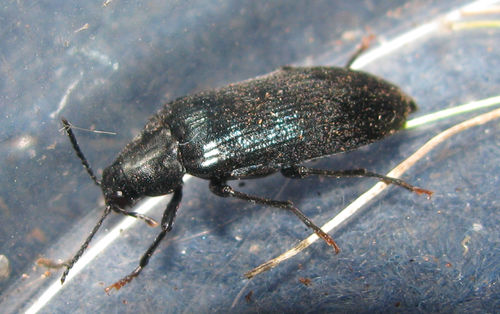
06 Melandrya caraboides: Melandryidae: Notable B: 30.5.2012.
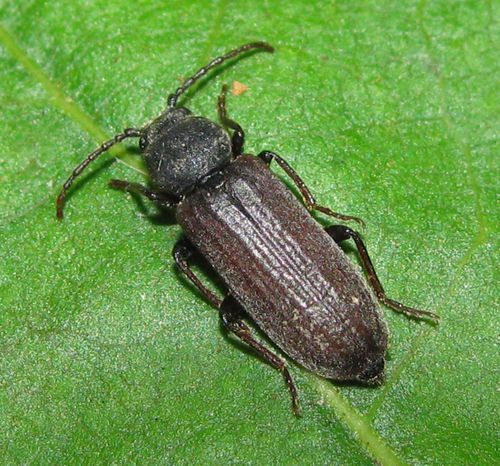
07 Arhopalus ferus: Cerambycidae: local: 28.6.2012

08 Poecilium alni: Cerambycidae: Notable B: 26.5.2012
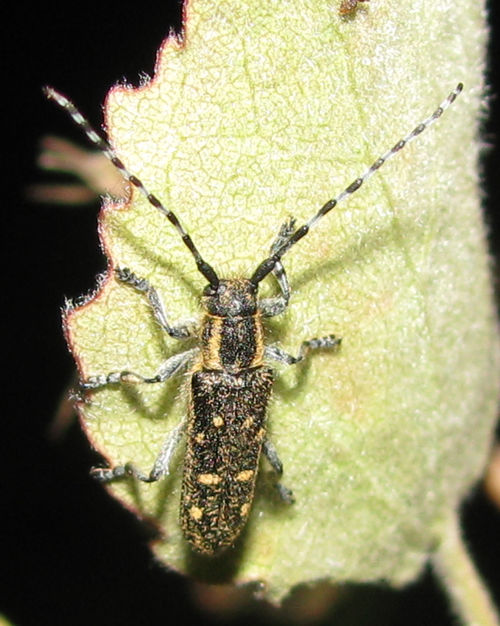
09 Saperda populnea: Cerambycidae: local: 15.5.2011
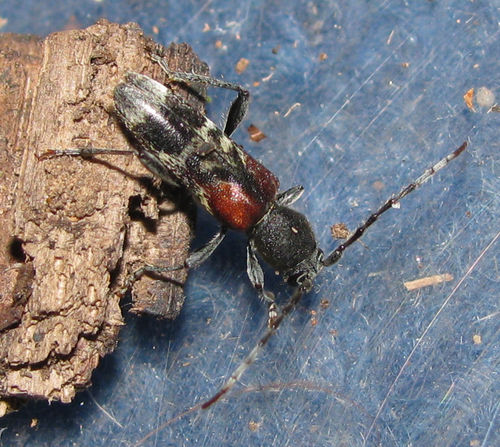
10 Anaglyptus mysticus: Cerambycidae: Notable B: 19.5.2011
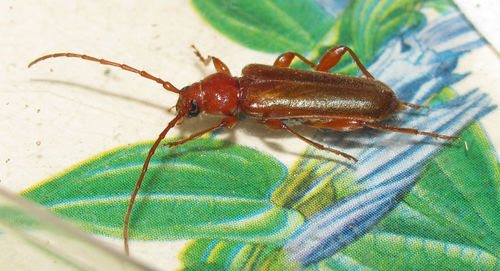
11 Phymatodes testaceus: Cerambycidae: local: 2.6.2011

12 Platyrhinus resinosus: Anthribidae: Notable B: 2.6.2011
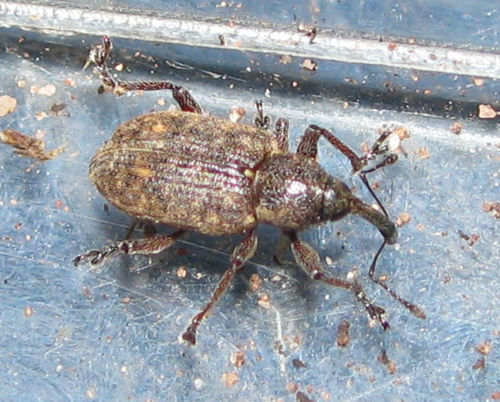
13 Notaris scirpii: Curculionidae: Notable B: 6.4.2010
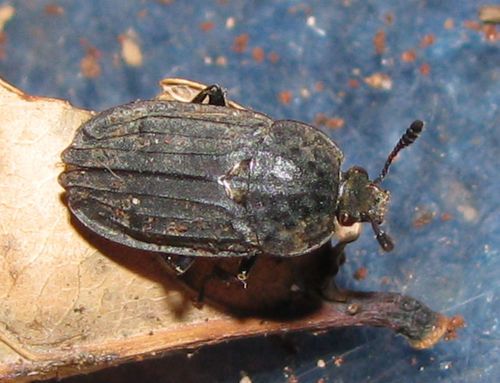
14 Thanatophilus sinuatus: Silphidae: local: 1.10.2011
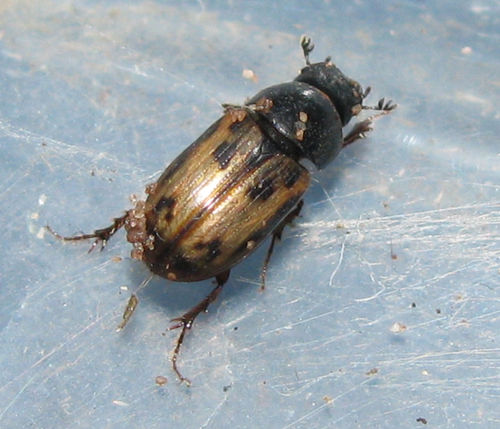
15 Aphodius distinctus: Scarabaeidae: Notable B: 18.4.2011
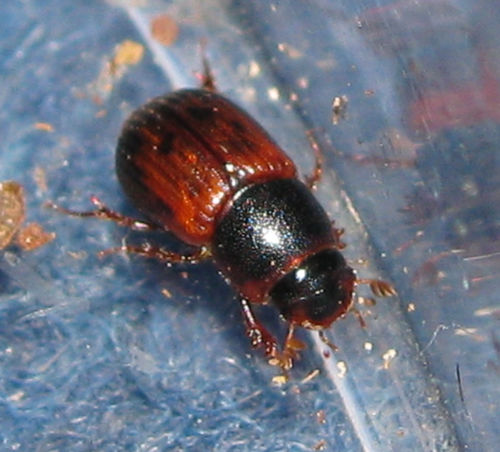
16 Aphodius zenkeri: Scarabaeidae: Notable B: 21.6.2011
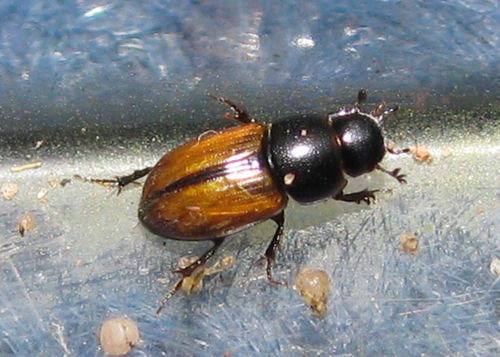
17 Aphodius ictericus: Scarabaeidae: Local: 22.4.2011

18 Plegaderus vulneratus: Histeridae: scarce: 22.4.2010
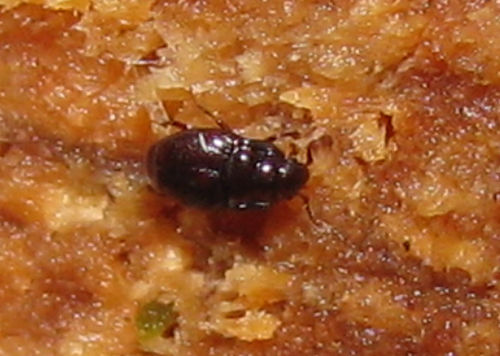
19 Plegaderus dissectus: Histeridae: Notable B: 28.6.2011
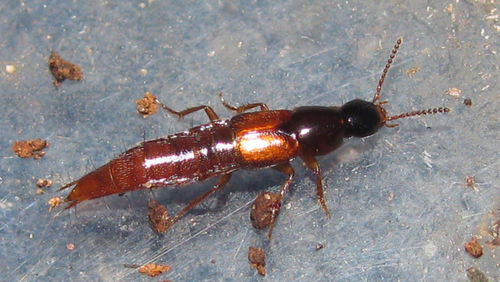
20 Philonthus scitus: Staphylionidae: Notable B: 22.5.2012

21 Deleaster dichrous: Staphylionidae: Notable B: 12.8.2010
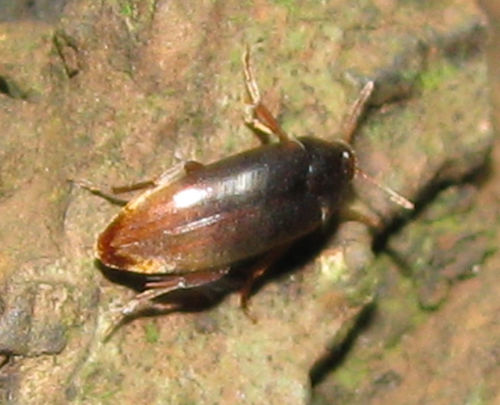
22 Orchesia micans: Melandryidae: local: 1.10.2012
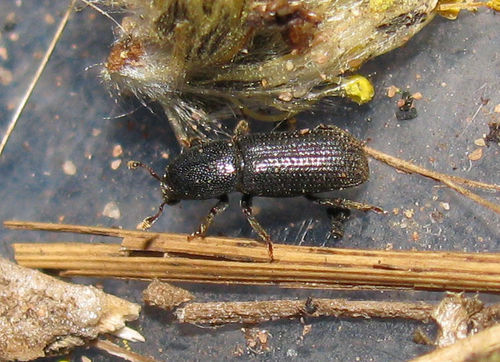
23 Hylastes opacus: Scolytidae: local: 28.4.2013
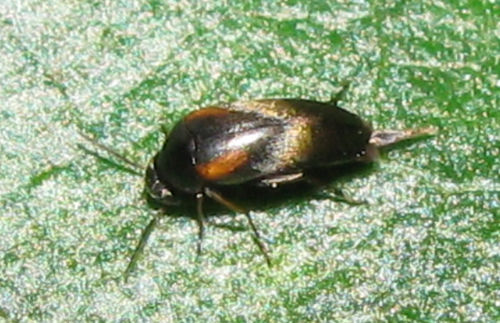
24 Variimorda villosa: Mordellidae: Notable B: 9.7.2012
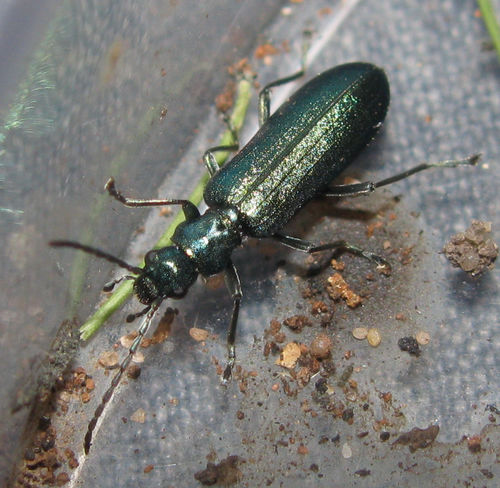
25 Ischnomera cyanea: Oedemeridae: Notable B: 27.5.2012.

26 Margarinotus purpurescens: Histeriidae: local: 15.5.2012
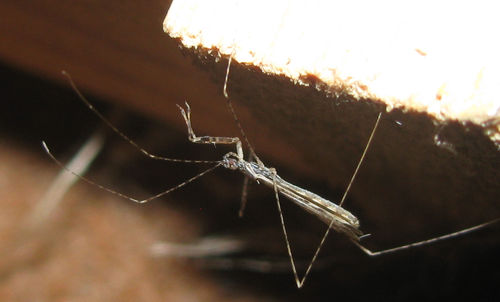
27 Empicoris vagabundus: Reduviidae local: 1.10.2012
Worcestershire Record | 35 (November 2013) page: 43 | Worcestershire Biological Records Centre & Worcestershire Recorders
Jackals fly in for a feast
Gary Farmer and Nicki Farmer
On 21st June we were walking adjacent to the river Avon near Evesham Country Park, enjoying the abundant Banded Demoiselles, marvelling at an agile Hobby chasing Swallows along the river, listening to a Turtle Dove calling, and the sun was shining; it couldn’t get any better? But then we noticed a Honeybee struggling to escape from the jaws of a large spider Misumina vatia. And then we noticed a group of small flies homing in on the spider and its prey. They landed on the bee and even on the spider itself and started feeding on the bee’s body (01& 02). Presumably they were able to take advantage of the free meal because the spider was unwilling to release such a large pray item to try to feed on these small interlopers.
We had never seen anything like this gruesome scene before so I contacted Mick Blythe to see if he knew anything about the flies and their behaviour. He commented that “the little acalyptrates don’t show enough detail to identify them, but judging by their behaviour they are likely to be Jackal Flies (Milichiidae). These have the habit of lurking about large predators such as spiders, predaceous bugs or mantids, and when the predator makes a kill they join in to share the prey. They have been shown to mop up fluids from the dead or dying insect. We have about 18 species of Milichiidae in this country, though probably not all of them behave as Jackal Flies”.
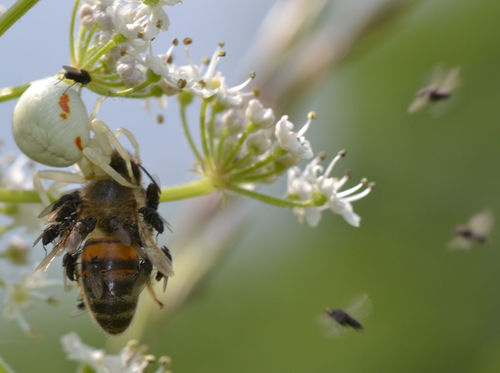
01. Jackal flies feasting. Gary Farmer
Worcestershire Record | 35 (November 2013) page: 10-11 | Worcestershire Biological Records Centre & Worcestershire Recorders
Orthoptera atlas update November 2013
Gary Farmer
The conundrum of determining old records
Apparent decline of some species
Dot maps for the Orthoptera show a good coverage of the county for most species. There are blank areas, some of which can be explained by the larger conurbations leaving little space for suitable habitat; some areas have simply not been surveyed for this group and there is the ever present element of the maps showing recorder effort rather than species distribution. All of these factors can be taken into account and explained. It is when the records are viewed in more detail that the interesting questions arise, especially when recorded dates are examined. For example, two maps for Common Green Grasshopper Omocestus viridulus are reproduced here from data held at Worcestershire Biological Records Centre (WBRC). The map with black dots (01) shows all records for this species to the end of 2012 mapped as 1×1 km squares (monads) and there is lots of white space but a good spread of records. However, the coloured map (02) shows the records split between pre-2000 and 2000-onwards painting a picture of a species in serious decline. On the coloured map the green dots indicate 2x2km squares (tetrads) which have records before 2000 but none since. Records since 2000 are shown by red dots and these replace green if there was an earlier record.
In fact the details of the records show that of the 134 records held at WBRC 71 are pre-2000 and 41 of these are pre-1951. Many of you will not be surprised to learn that 36 of the pre-1951 records are those collected by Fred Fincher.
So why so many early records with no corresponding post 2000 records?
Much of this can be accounted for by the attraction of honey-pot areas; recorders are drawn to areas where there are things to record (nature reserves etc.) rather than searching in the wider countryside. Take for example a cluster of records in SO96 and SO97. In 1947 Fred Fincher took a walk along the canal tow-path between Stoke Prior and Hanbury, recording Orthoptera as he went; no one has done this since so the species is shown on the maps as being present pre-2000 and not since. In 1953 Fred Fincher produced a short paper Orthoptera – Some notes on Orthoptera and Dermaptera in the West Midlands which notes the Common Green Grasshopper to be “common in north Worcestershire between Bromsgrove and Kidderminster”. Is this still the case?
Some intriguing records
In the case of the commoner species it is possible to review the old records and be confident that they are accurate especially when accompanied by more detailed information such as Fincher’s 1953 paper. They are extremely useful to inform follow up surveys which will give some conclusions about the fate of these species in areas where they were previously common. There are a few species on the Worcestershire maps though which require more research into factors affecting their national distribution and possible confusion species.
A Shrawley paradox
Of records worth researching the Wood Cricket Nemobius sylvestris is most intriguing. Fred Fincher reported that he took an immature cricket in Shrawley Woods in April 1948. The specimen was submitted to national experts who agreed that it was “possibly” a Wood Cricket but they were unable to confirm this due to immaturity. He concludes “As no further specimen has yet been secured it cannot be fully admitted to the list”. This species has a biennial life cycle, over-wintering as a half grown nymph. It becomes fully active again in April which fits well with the time of year that the Shrawley specimen was taken but would have measured only approximately 5mm long at that time of year. Interestingly Ragge (1965) notes that the Wood Cricket is only known to occur for certain in south coast counties and south Wiltshire. He does however note that there are “… doubtful records for…Worcestershire and even Derbyshire”. This is a wingless species requiring old hedgerows and open woodlands in warm locations so it is highly unlikely that it will occur in this county, but was it here in the past?
A Malvern enigma
The second species is more likely to still be present. This is the Stripe-winged Grasshopper Stenobothrus lineatus and has been recorded at two locations on the southern Malvern Hills (Ragged Stone Hill in 1995 and the reservoir dam wall in 1999). Ragge describes it as a species with a “..preference for dry localities, especially where the local rock is limestone. Away from limestone [it] is usually found on sandy soils.” I have searched various parts of the Malverns for this species, including the dam area without success but I have not yet been to Ragged Stone Hill. A recent exchange of emails with Peter Garner (the recorder for both records) suggests that Peter found Stripe-winged Grasshoppers at the dam wall and this was confirmed by Don Goddard. It appears that Don Goddard had then commented that he had found this species at Ragged Stone Hill and so this was recorded. Further searches along the Malverns may well prove fruitful but this is a secretive grasshopper and is very similar to the Common Green Grasshopper which is abundant on the hills.
A Bredon Hill mystery
The third species is the Bog Bush-cricket Metrioptera brachyptera which has been recorded for Bredon Hill (2006). This is a flightless species of wet heathland and moors and Ragge notes that “the occurrence of Cross-leaved Heath is often an indicator of its presence”. Haes and Harding (1997) concur with this and add that Purple Moor-grass is also usually present where this bush-cricket is found. It is widespread but local nationally being found at scattered localities across England and Wales and has been found in Scotland. It has been found at sites fairly close to Worcestershire including locations in Shropshire and on Cannock Chase but it has never been found in the heaths of north Worcestershire despite searches. Further searches in the south of the county will be required.
Ephemeral pioneers?
The last species on this list is the Great Green Bushcricket Tettigonia viridissima. This is a large, loud bush-cricket which should be unmistakable so why should I question any records for species? WBRC hold 11 records for Great Green Bushcricket between 1947 and 1981, eight of which are from Fred Fincher from four sites (Randan Wood 1947, 1950, 1951; Drayton Pool 1947, 1948; The Slings 1947, 1948; Upton Warren 1948). Despite the significance of these records there is no mention of this species in either Fred Fincher’s 1953 paper or a follow up article from 1970s. The possibility of confusion with Oak Bushcricket did cause some doubt but WBRC have records for the latter species from the same period for the same recorder. Are there any records from adjacent counties during the 1940s, or do these records match a run of hot summers? Further digging required.
Of the remaining three records for Great Green Bushcricket, one is from an anonymous recorder so can not be verified. The other two are both for Nafford from Peggie Pittkin 1980 and M.P. 1981 (these two recorders are considered to be the same person). Great Green Bush-cricket has certainly been expanding its range from the south through Gloucestershire in recent years so could these have been from an unsuccessful range expansion over 30 years ago? Doubt arises as this is the only species of Orthoptera reported by this recorder so could they have been the result of encounters with Oak Bush-crickets on a couple of occasions?
If anyone can shed any light on these records or has any other old records of Orthoptera please let me know so we can ensure that the proposed atlas is as accurate as possible.
Any photos of new or old sightings can still be emailed to me at vc37hopper@gmx.com.
Also check the website for news and identification help worcestershireorthoptera.weebly.com
References
Fincher, F. 1953. Orthoptera – Some notes on Orthoptera and Dermaptera in the West Midlands. Entomologist’s Record 65:151-154.
Haes, E.C.M. and Harding P.T. 1997 Atlas of Grasshoppers, Crickets and Allied Insects in Britain and Ireland. London: The Stationery Office.
Ragge, D.R. 1965. Grasshoppers, Crickets and Cockroaches of the British Isles. London: Frederick Warne & Co Ltd.
Marshall, J.A. and Haes, E.C.M. 1988. Grasshoppers and Allied Insects of Great Britain and Ireland. Colchester, Essex: Harley Books (B.H & A. Harley Ltd.).
Images

01. Omocestus viridulus all records.
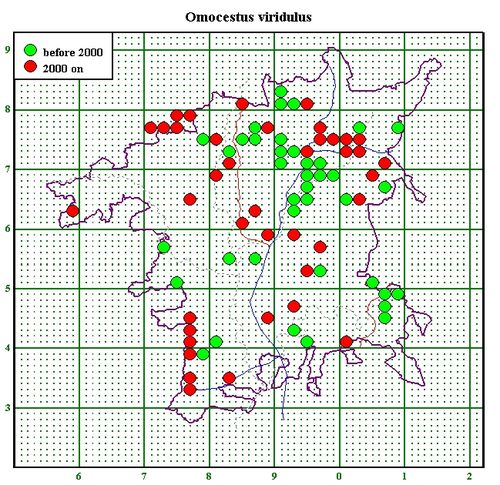
02. Omocestus viridulus records before & after 2000
Worcestershire Record | 35 (November 2013) page: 45-46 | Worcestershire Biological Records Centre & Worcestershire Recorders
A few attractive beetles encountered in Worcestershire in 2013
Gary Farmer
The summer of 2013 was memorable for late emergence times, shortened periods of activity and an abundance of many species during that brief hot spell. Whilst using a sweep net along hedgerows during the summer I noticed many more small beetles than usual, so I decided to attempt to identify some of the more colourful ones from photographs; hoping this would be possible. As with all groups of insects, finding information when starting out is not easy. Two references are given below and it is these that I have taken the life history information.
Four species are covered here; the first is a common species in the county and appeared in very good numbers in 2013. A bright, metallic green/blue beetle with a large red patch at the tip of each elytra make this one readily identifiable. The adults of the Common Malachite or Malachius bipustulatus(Linnaeus, 1758) feed mostly on pollen but have also been seen to feed on the beetle Dasytes aerosus.
Larvae are usually found under bark and in decaying wood. Partly predatory, they also feed on excreta and skins of wood-boring beetle larvae. With so many of these beetles around it was possible to interactions. The two in the photo (01) were sparring on a buttercup flower in Tiddesley Wood 03 June 2013, locking jaws and pushing and pulling each other. Occasionally a third beetle joined in but was quickly repelled by the other two. This went on for a few minutes and when I left them there was still no clear winner. There was certainly no shortage of buttercups in the summer so what was so special about this particular one?
The second species is another member of the malachite family; a small but striking red malachite measuring 4-5mm, Anthocomus rufus (Herbst, 1784) (02). I found several of these at Coney Meadows 13 August 2013 sitting openly on vegetation on the edge of a reed bed. Harde 1998 states that this is a species of marshy areas which feeds on late-flowering sedges. The larvae are predacious feeding on the larvae of wood-boring beetles.
The third species is another small beetle about 4mm long, this time a soldier beetle from the family Cantharidae. A slender beetle with a yellow spot at the tip of the elytra, Malthodes minimus (Linnaeus, 1758) (03 & 04). I swept this species from Elder flowers at Windmill Hill 30 June 2013, Dogwood at Hollybed Farm 06 July 2013 and from shrubby vegetation in Monkwood 20 July 2013. Adults are known to feed from various flowers. The larger soldier beetles have larvae which are ground predators, feeding mainly on slugs and snails but I have been unable to find much information about this species. Alexander (2002) suspects that they probably develop in decaying branch wood or heart wood (feeding on other beetle larvae?).
I encountered a single specimen of the fourth species at Monk Wood whilst sweeping Melilot. I photographed it, presuming it to be a deformed Malthodes as the tips of the elytra appear damaged. However the individual was identified as another malachite Axinotarsus ruficollis (Olivier, 1790), rather than a soldier beetle, and it is a rather uncommon species with a cluster of records in north Worcestershire (John Bingham pers. comm.). The larvae of this species is thought to develop in dead twigs.
Acknowledgement.
My thanks to John Bingham for his help with identification of Axinotarsus ruficollis.
References
Harde, K. W. 1998. A Field Guide to Beetles, Blitz Editions, Bookmart Ltd. Leicester.
Alexander, K. N. A. 2002. The Invertebrates of living & decaying timber in Britain & Ireland – A Provisional Annotated Checklist. English Nature Research Reports No. 467. English Nature (Natural England), Peterborough.
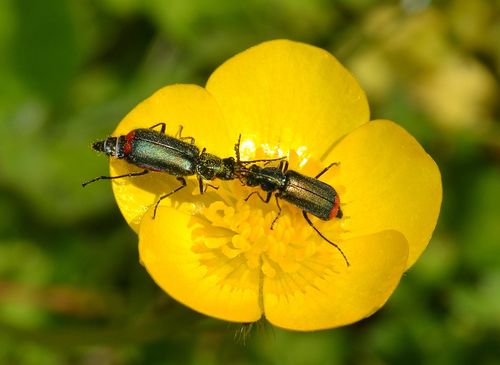
01. Malachius bipustulatus Gary Farmer
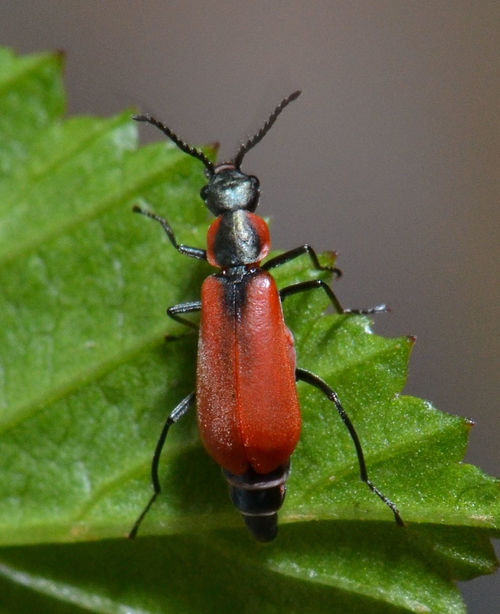
02. Anthocomus rufus. Gary Farmer.
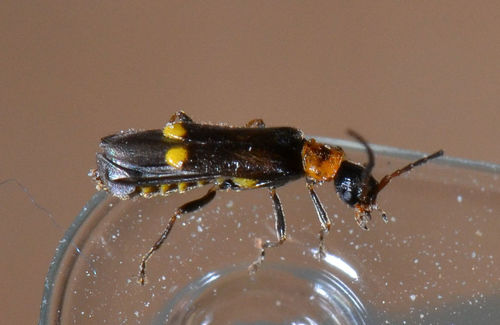
03. Malthodes minimus. Gary Farmer
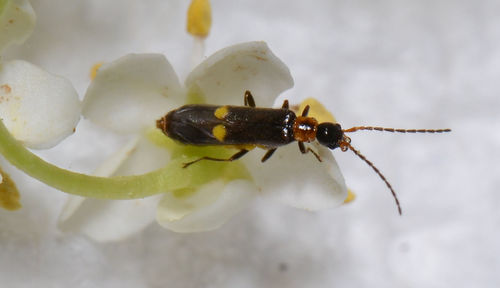
04. Malthodes minimus. Gary Farmer
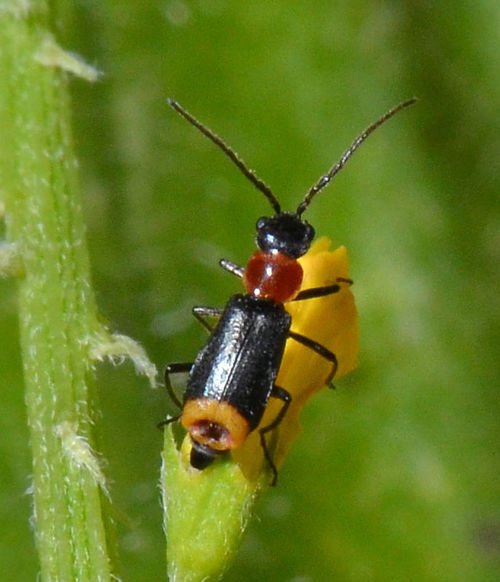
05. Axinotarsus ruficollis. Gary Farmer
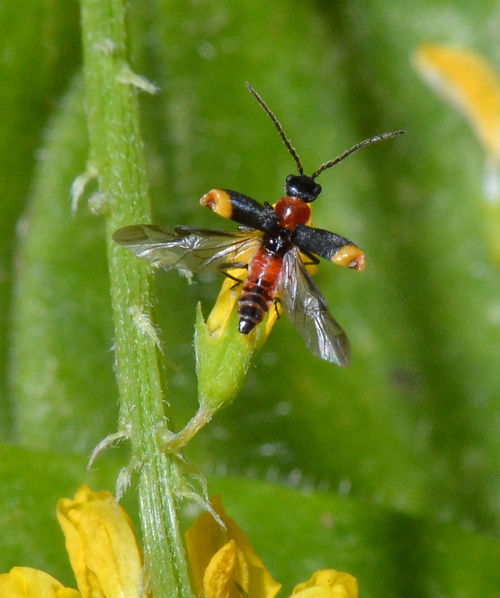
06. Axinotarsus ruficollis. Gary Farmer
Worcestershire Record | 35 (November 2013) page: 35-36 | Worcestershire Biological Records Centre & Worcestershire Recorders
A wolf in raft spider’s clothing, a cautionary tale for the rarity hunter
Gary Farmer
Whilst writing about spiders it reminded me of an embarrassing mistake in 2012.
Croome Park is known as a good spot for dragonflies and other invertebrates but in June 2012 I discovered something that I thought would trump anything previously found at the site. Whilst crouching at the side of the lake looking for dragonflies I noticed a spider walking on the lake. It moved with ease and came close to the bank but stayed on top of the water. It was dark brown with pale lines along the sides of its body; it had to be a juvenile Raft Spider Dolomedes. I managed to get a couple of reference photographs and on returning home I emailed these to John Partridge with a comment about what I thought I had found. As soon as I had sent the pictures I checked through my books again and in Stephen Dalton’s Spiders, The Ultimate Predators I found a picture of ‘my’ spider: not a Raft Spider at all but a Pirate Wolf Spider Pirata piraticus. A second email was sent to John Partridge in a hurry, but too late, he had already spotted my error. The similarity between juvenile Dolomedes and this species of Pirata is remarkable and presumably the result of convergent evolution (that’s my excuse anyway).
Two pictures show the Croome spider Wolf Spider Pirata piraticus (01 & 02) and two show the Raft Spider Dolomedes (03 & 04).
Images
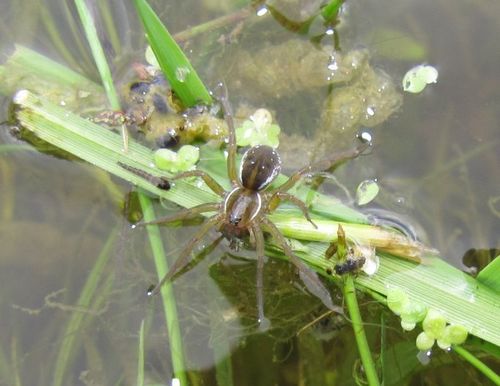
01. Croome spider Wolf Spider Pirata piraticus. Gary Farmer
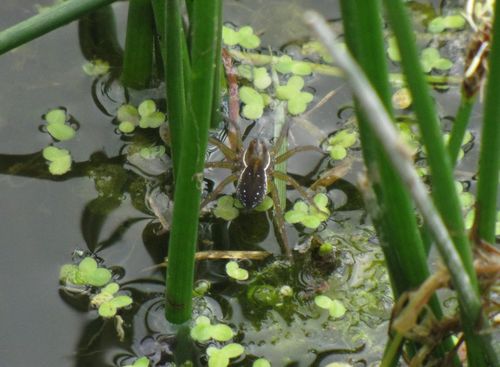
02. Croome spider Wolf Spider Pirata piraticus. Gary Farmer

03. Raft Spider Dolomedes. Gary Farmer
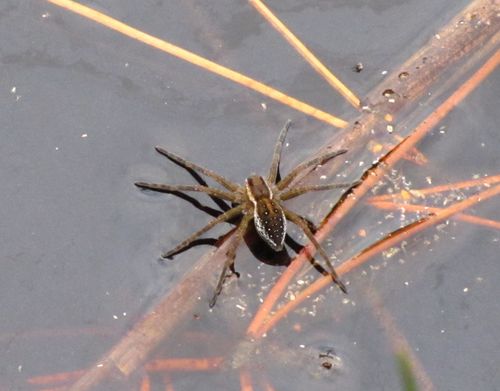
04. Raft Spider Dolomedes. Gary Farmer
Worcestershire Record | 35 (November 2013) page: 34-35 | Worcestershire Biological Records Centre & Worcestershire Recorders
Flowers that bite
Gary Farmer
It appeared that 2013 was a very good year for Flower Spiders Misumena vatia. No kind of flying insect appeared to be safe from this species. Their ability to change colour to camouflage against white or yellow flowers (01) seemed particularly successful. In Grafton Wood I witnessed a Heineken Fly Rhingia campestris apparently feeding from a Dandelion, but closer inspection revealed the fly to be in the jaws of a perfectly hidden Misumena (02). Empid flies (03) other species of hoverflies, and various other Diptera fell victim to ambush on Hogweed. Just outside the county in Oversley Wood (Warwickshire), bumblebees and flies (04) were being targeted at the flowers of Marsh Orchids.. In Trench Wood I photographed a Peacock butterfly feeding at a Common Spotted Orchid and noticed that this (05) and a bumblebee (06) were victims of flowers that bites. Not all of the successful spiders had changed to match the colour of the flower (a white spider was observed catching hoverflies on pink Ragged Robin), so it might be that the camouflage is more about protecting the spider from predators rather than disguising it from its prey? (or that insects see colours differently to the human eye? Ed.).
Images
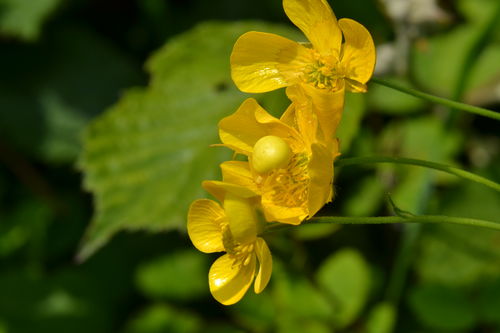
01. Misumena on buttercup. Gary Farmer
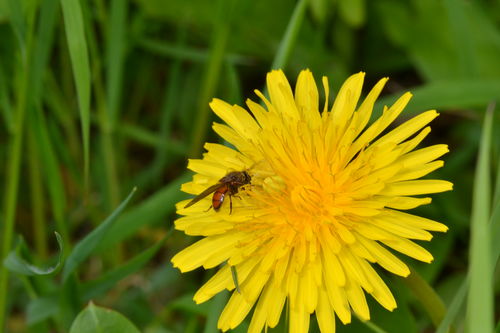
02. Misumena with Rhingia campestris. Gary Farmer
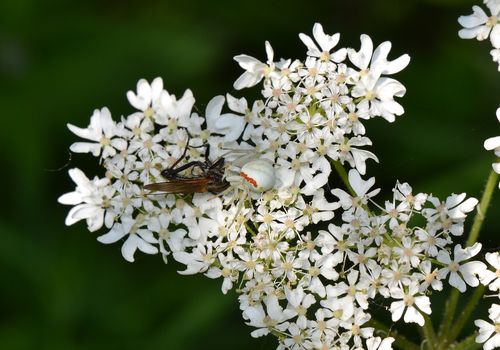
03. Misumena with empid. Gary Farmer
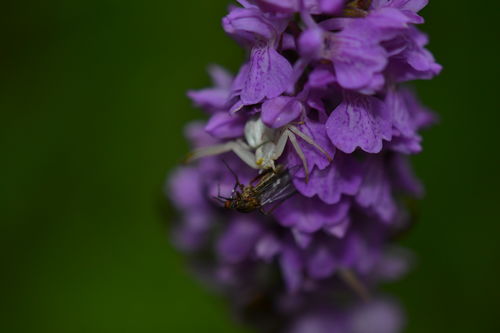
04. Misumena with a fly on southern marsh orchid. Gary Farmer
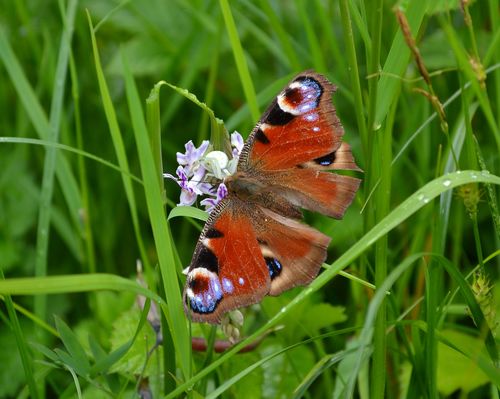
05. Misumena with peacock. Gary Farmer
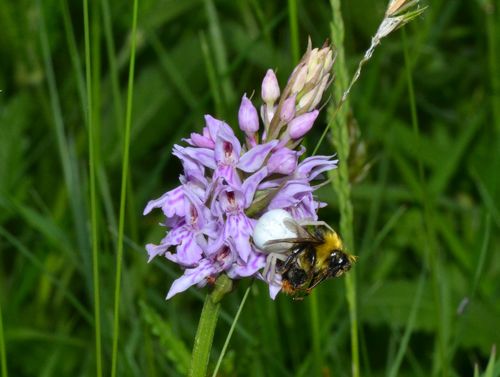
06. Misumena with bumblebee. Gary Farmer
Worcestershire Record | 35 (November 2013) page: 59-61 | Worcestershire Biological Records Centre & Worcestershire Recorders
Field recording days 2013
Harry Green
Three special field recording days were arranged for the summer of 2013:
These were organised by Worcestershire Recorders and supported by Worcestershire Biological Records Centre, the latter managing the records on their database.
Saturday 1st June 2013. Lower Kites Wood, near Kington, Flyford Flavell– small ancient woodland privately owned by John Tilt and Dave Ward. We are most grateful to them for allowing us to visit their wood which has few biological records to date.
Saturday 6th July 2013. Hollybed Farm, Castlemorton. A newly established 40 acre Worcestershire Wildlife Trust reserve. Mainly grassland including Starling Bank SSSI. Also a stream valley, marshy patches, alder wood, scrub, good hedges, old trees, and a remnant of an old orchard. Very few biological records to date.
Saturday 3rd August 2013 Devil’s Spittleful heathland reserve owned by Worcestershire Wildlife Trust.. The recording day was planned to follow on from a great deal of practical conservation work that has been done there recently. Many trees have been removed, areas fenced, and grazing introduced. We were particularly interested in recording Hymenoptera to follow on from previous surveys.
We are grateful to Worcestershire Wildlife Trust for permission to run recording days on two reserves.
Unlike the cold and wet weather encountered during the 2012 recording days all 2013 recording days were reasonably warm and sunny so more insects were recorded that in 2012.
Lower Kites Wood is a small ancient woodland situated within the Forest of Feckenham area and near to Grafton Wood. There has been little woodland management for many years. The new owners have started coppice plots and opening up tracks to introduce more sunny patches in the wood. The recording day coincides with the start of this new work.
Hollybed Farm lies within farmed land situated between two important Malvern Commons – Hollybed Common and Castlemorton Common. Starling Bank SSSI, an important floristically rich grassland at the north-western end of the farm, has soils varying from lime-rich at the top of the bank to more neutral and damper ones at the base. Many of the other fields on the farm are partly improved agriculturally and the aim is to gradually convert them to herb-rich grasslands. One field contains a few ancient pear and apple trees and the grassland beneath is floristically quite rich. At the south-eastern end is Round Hill Bank, a rough grassland with an interesting flora and rich in bumblebees. The south-west of the farm is bordered by a small stream running in a steep-sided valley containing scrub and marshy areas. The big soldierfly, the Banded General Stratiomys potamida (10), whose larvae live in wet places was an interesting find in this area. Most of the field boundary hedges are species-rich with trees.
The Devel’s Spittlefull and adjacent Rifle Range reserves at Kidderminster are one of the few remaining heathlands in Worcestershire. Conservationists have battled against encroaching scrub and woodland for many years in an effort to maintain and restore heathland. In recent years extensive scrub and tree clearance is being followed up by cattle grazing. Cattle grazing should reduce and supress scrub regeneration allowing heathland to redevelop. One aim of the recording day visit was to help accumulated baseline species records soon after the initial clearance work. Shortly before the visit part of the Rifle Range Reserve immediately adjacent to the Spittleful has been burned. This zone contained many Mottled Grasshoppers Myrmeleotettix maculatus, some almost coal black in colour. Mottled Grasshoppers Myrmeleotettix maculate show a bewildering range of colour forms and a preponderance of nearly black forms are often noticed on burnt heath. This may be due to heavy predation of colour forms that do not match the background or colour forms may move to a matching background. The range of forms was particularly noticeable on the recording day with numerous nealy black forms on the burnt heath. See pictures 15 & 16. Picture 16 was on black burned heath.
The lists of records from the Field Recording Days include a good range of invertebrates. Noteworthy are many Diptera records determined by Mick Blythe and the shortage of beetle records compared with most recording days over the last ten years. We are missing beetle-man John Meiklejohn whose age and less good health have kept him away. However, several recorders are now identifying true bugs so improving the number of records for that group.
The aim of the field recording days is to obtain as many records of as many groups of plants and animals as possible to give a ‘snapshot’ for the day. Whether we succeed in this aim or not depends on who can attend on the day and the weather conditions.
The separate lists of Vascular Plants were compiled by Bert Reid.
Reference
Benton, T. 2012. Grasshoppers and crickets. HarperCollins, London, New Naturalist series volume 120
Images
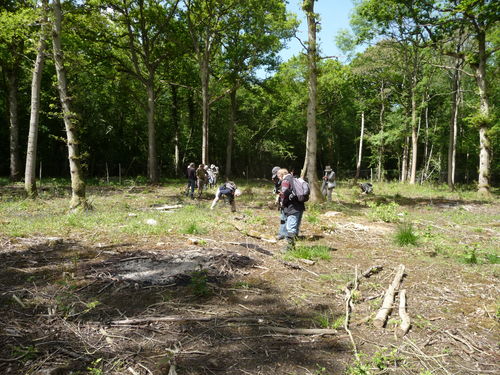
01. Recorders in coppice plot Lower Kites Wood
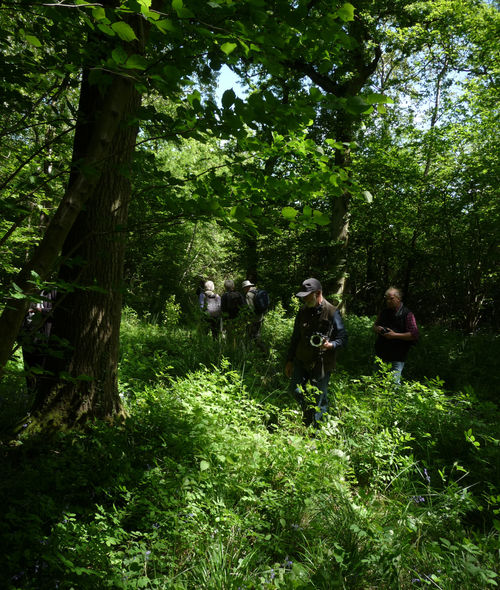
02. Recorders in Lower Kites wood
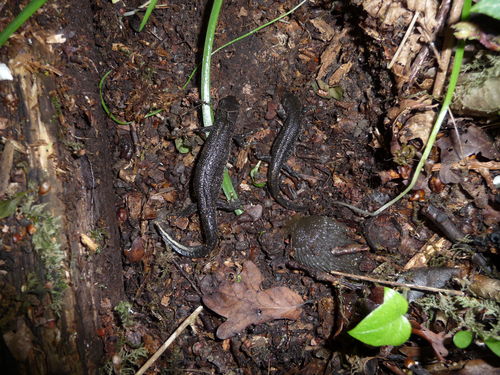
03. Lower Kites Wood Great-crested Newts Triturus cristatus
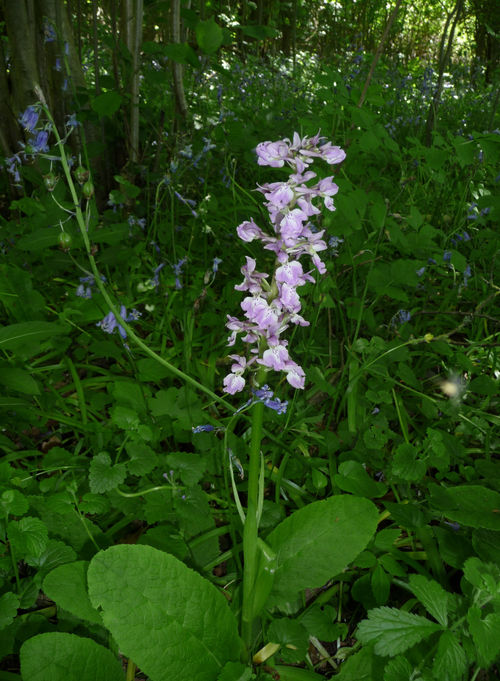
04. Lower Kites Wood pale Early Purple Orchid
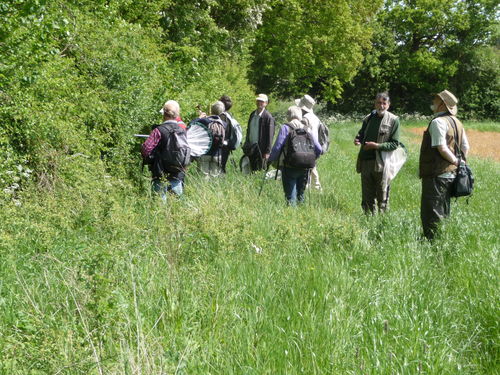
05. Recorders at edge Lower Kites Wood.
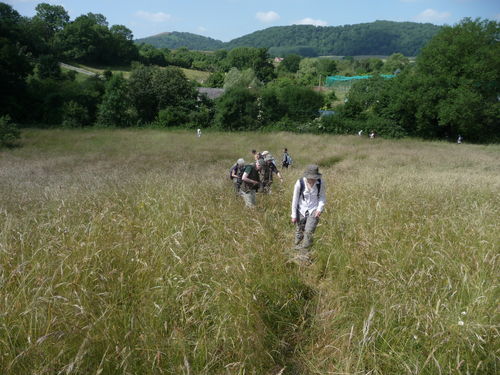
06. Starling Bank SSSI Hollybed Farm
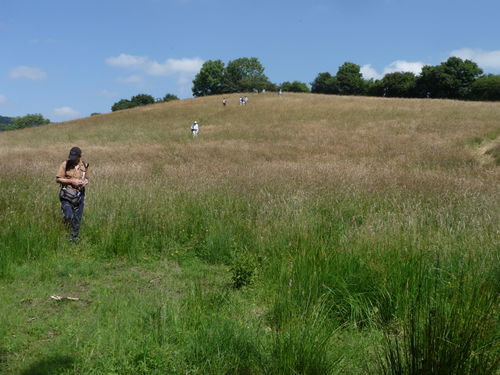
07. Starling Bank SSSI Hollybed Farm

08. Round Hill Bank Hollybed Farm
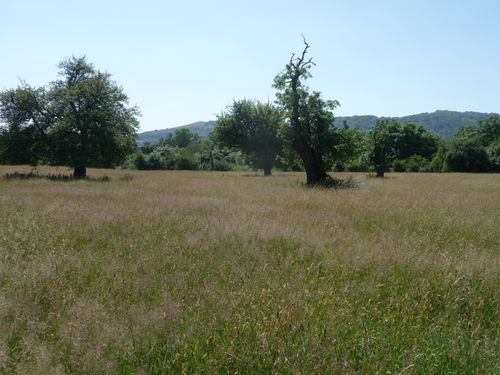
09. Old orchard Hollybed Farm

10. Stratiomys potamida Hollybed Farm. Gary Farmer
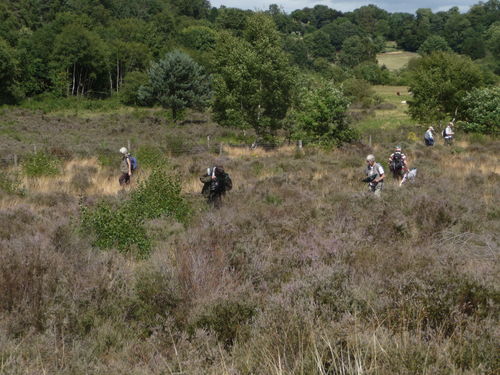
11. Devil’s Spittleful recorders amongst heather

12. Devil’s Spittleful heather and passing train.
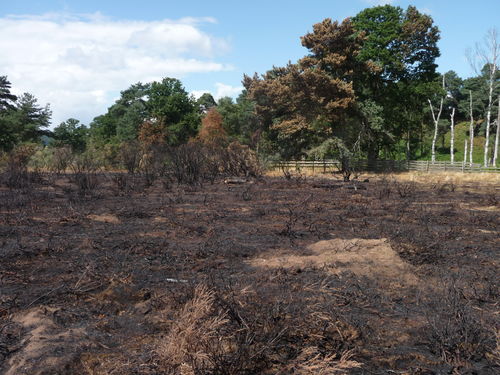
13. Burnt heath on Rifle Range
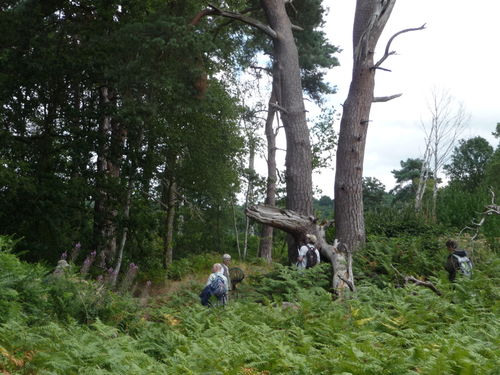
14. Devil’s Spittleful old Scots Pine

15. Devil’s Spittleful Mottled Grasshopper Myrmeleotettix maculates dark form
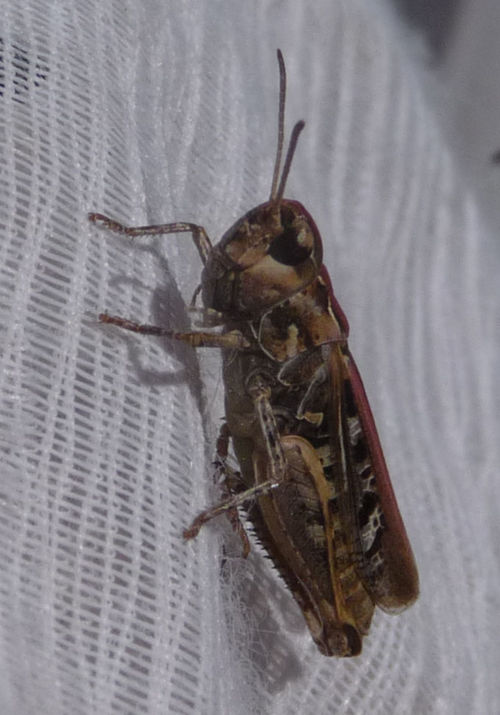
16. Devil’s Spittleful Mottled Grasshopper Myrmeleotettix maculatus
Worcestershire Record | 35 (November 2013) page: 12-14 | Worcestershire Biological Records Centre & Worcestershire Recorders
Planting the 2013 Whitty Pear
Harry Green
On the 14th March 2013 Hermione Gerry planted a sapling Sorbus domestica, a Whitty Pear, in the Wyre Forest arboretum near to another originally planted 30th March 1916 (01). The 1916 tree had been planted at the site of the original Whitty Pear first seen by Pitt in 1677, documented in 1678, and burnt down in 1862. Seeds or cuttings from the original tree were propagated at Arley Castle and both the1916 tree and the 2013 tree are descendents of the original tree. For hundreds of years people speculated on the origins of the lone original tree: was it a native or planted? The discovery of Whitty Pear trees growing in South Wales and on the Severn Estuary in the 1980s and 1990s have probably strengthened the view that Sorbus domestica may be a scarce native tree but the true origin of the Wyre Forest tree remains unknown (Hampton 1996 , Hampton & Kay 1995).
The 1916 tree was planted by Mrs Robert (Mary Ann) Woodward in memory of her son killed 9th May 1915 during the First World War. She was Hermione Gerry’s (née Woodward) grandmother (Gerry 2012).
I first met Hermione and Andrew Gerry in late 2010 at Areley Cottage. Hermione was joint owner of Pound Green Common which was for sale and the meeting was to discuss the possible purchase of the Common by Worcestershire Wildlife Trust. In conversation I was astonished to discover that she was part of the Woodward family who once owned Arley Castle and of her connection with the Whitty Pear. On another visit in April 2012 Andrew and Hermione showed me a Whitty Pear planted in their Arley Cottage garden in 1930 by Hermione’s father (02) and also a sapling they recently planted. They also showed me a sturdy sapling raised by them and growing in a pot. Where should it be planted? After various suggestions it occurred to me that in would be interesting for Hermione to plant it in the Wyre Forest Arboretum near the 1916 tree planted by her grandmother nearly 100 years previously. I asked Richard Boles, Area Forester Wyre, if this would be possible and he said it would be. He and Wyre Forest Wildlife Ranger Phil Rudlin were very helpful, leading to a ceremonial planting on 14th April 2013.
Those present at the ceremony included Hermione and Andrew Gerry with family members and friends; representatives of Worcestershire Naturalists’ Club, Worcestershire Wildlife Trust, Wyre Forest Study Group, Wyre Forest Society, and the Forestry Commission. In the photograph (03) there are a few people I have been unable to name so please let me know of you can identify them. Everyone present also gathered by the 98 year old 1916 Whitty Pear planted by Hermione Gerry’s Grandmother (04).
Members of the Worcestershire Naturalists Club (WNC) often visited the original Whitty Pear and many were involved with the 1916 planting. One of their senior members present at the 1916 planting wrote a historical account of the tree (Jeffery 1916). The picture (05) from the Berrow’s Worcester Journal pictorial supplement 8th April 1917 was rediscovered and printed in the Transactions of the Worcestershire Naturalists Club in 1981 together with the caption probably written by the editor Mary Jones. Although there is a list of WNC members present she was only able to identify a few of them in the picture. Any help in naming the people in the picture would be very useful.
Readers may wonder why we did not wait until 30th March 2016; a century after the 1916 tree was planted, before planting the sapling. There were two reasons. First the sapling in the pot was quite large and needed planting-out. Secondly, Hermione had been ill for some time and receiving chemotherapy for cancer. Without a word being said of this it was apparent she wanted to plant the tree as soon as practically possible. Hence, we planned for March 2013 in the 98th year and it was so. Sadly, Hermione died on 19th July 2013 and I very much hope the tree will grow and thrive as a lasting memorial to a remarkable lady.
Lastly, the meeting at Areley Cottage in 2010 concerning Pound Green Common eventually led to the Worcestershire Wildlife Trust becoming the owners of in December 2013.
Acknowledgements
I am very grateful of the help and support given by the Wyre Forest Forestry Commission office, especially Richard Boles (Forester) and Phil Rudlin (Wildlife Ranger) and for Richard’s permission to plant the Whitty Pear in the Wyre Forest Arboretum; also my grateful thanks to Wendy Carter for photographing the event so well.
References
Gerry, Hermione. 2012. Sorbus domestica, the Woodward Family Connection in Worcestershire. Worcestershire Record 33:67-68.
Green, H. 2009. The Old Sorb Tree, Whitty Pear or The True Service Tree, Sorbus domestica L, previously Sorbus pyriformis. Wyre Forest Study Group Review, 10:69-73. Also see http://www.wyreforest.net/wp-content/uploads/2012/04/The-Old-Sorb-Tree.pdf
Hampton, Marc 1996. Sorbus domestica L. – comparative morphology and habitats. BSBI News No 73 pages 32-37.
Hampton, M. & Kay, Q. O. N. 1995. Sorbus domestica L., new to Wales and the British Isles. Watsonia. 20:379-384.
Jeffery, F.R. 1916 The Wyre Forest Sorb Tree Worcestershire Naturalists’ Club Transactions Volume VI part III pages 250-257.
Jones, M. M. 1981. [Editor’s caption to the picture of the 1916 planting]. Transactions of the Worcestershire Naturalists’ Club. New series, volume 1, part 2, pages 96-97.
Pitt, Edmund. 1678. Extract of a Letter from Mr. Edmund Pitt, Alderman of Worcester, a Very Knowing Botanist; Concerning the Sorbus Pyriformis. Philosophical Transactions (1665-1678) Vol. 12, 1677 – 1678, No. 139 April, May & June 1678, pages 978-979.
Images
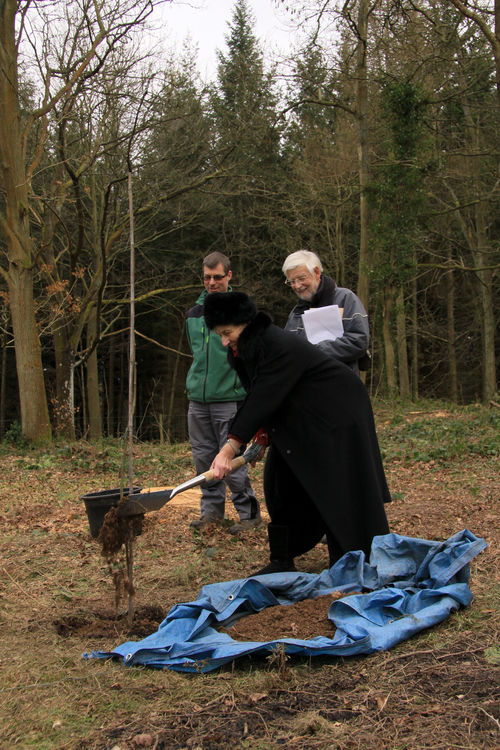
01. Hermione Gerry planting Whitty Pear. Wendy Carter
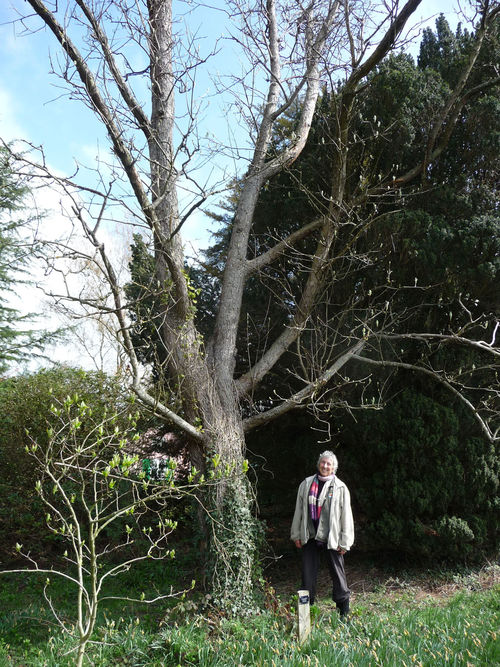
02. Hermione Gerry by Whitty Pear at Areley Cottage. Harry Green
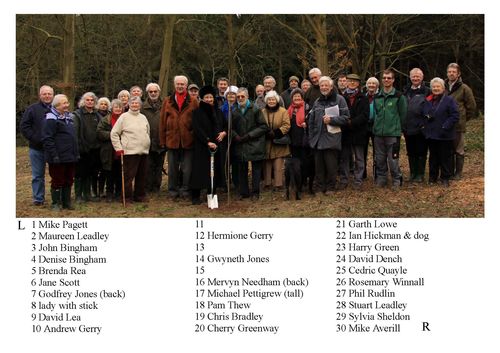
03. People at the Whitty Pear planting 14March2013. Wendy Carter
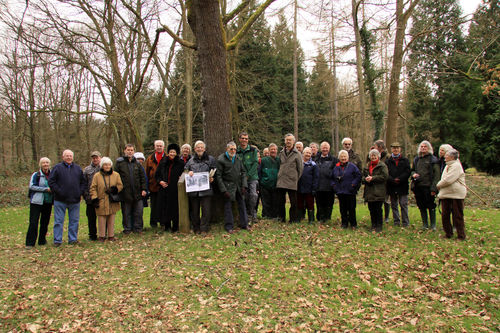
04. People by the 1916 Whitty Pear 14 March 2013. Wendy Carter
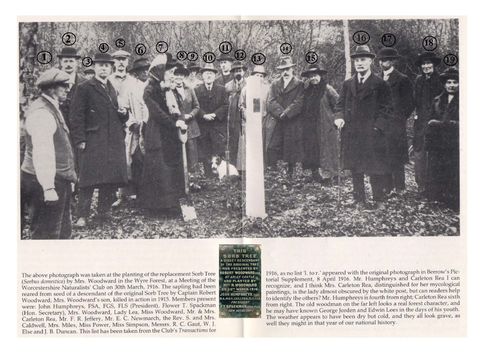
05. People at the planting of the 1916 tree
Worcestershire Record | 35 (November 2013) page: 37-38 | Worcestershire Biological Records Centre & Worcestershire Recorders
Pine sawfly Diprion pini first record for Worcestershire
Harry Green (compiler)
Martin Smith sent by email a picture of a sawfly (01) to Worcestershire Wildlife Trust at the end of August 2013. It had been taken on 26th August 2013 at Deerfold Wood, near Wadborough, a mainly coniferous woodland. The sawfly was found low down on a blade of grass just outside the wood. It appeared to be of Diprion pini (Pine sawfly). There no records in the Worcestershire Biological Records Centre (WBRC) database and few on the NBN Gateway. Internet searches were not helpful but revealed that the species could be a pest that defoliated conifers. To gain further information Geoff Trevis send the picture to sawfly expert Guy Knight, Head of Zoology & Curator of Invertebrates, National Museums Liverpool and I sent it to
Forestry Commission, Forest Research, Alice Holt Lodge, Farnham.
Guy Knight replied “Diprion pini is not a common insect at all and I have only see it occasionally. Even working in Caledonian pine forest over the past few years it was quite difficult to find! It is an adventive species, having years of super-abundance at a site followed by years when it is hard to find. Similarly, it is difficult to predict where it will turn up – this year I was surprised to see thousands of larvae stripping ornamental dwarf pines in a park right in the centre of Liverpool; it will do the same thing in plantations, where it can be a pest”.
Christine Tilbury, Advisory Entomologist at Forest Research replied “We do have a number of records for Diprion pini but none from Worcestershire” and sent scans of two informative documents. First, Forestry Commission Leaflet no. 35 “Pine Sawflies” (1955) and, second, a page entitled Neodiprion sertifer and Diprion pini from Bevan 1987.
Leaflet No. 35 gives a good description of Diprion pini life history as follows:
“Diprion pini. The adult sawflies emerge in May or June from cocoons which have overwintered in the upper soil and litter layers of the forest floor. The females deposit their eggs in slits cut with their saw-like ovipositors in the previous year’s pine needles, a number of eggs commonly being laid in a row in any one needle. The cavity containing each egg is roofed over with a foam-like substance extruded by the female which hardens into a cap of honeycomb appearance. The larvae hatch in two to three weeks and commence feeding upon the needles, at first eating only the outer margins, but later devouring the whole needle down to the needle sheath and sometimes even gnawing off the bark of the shoots. During the whole of this period the caterpillars feed together in a compact colony. If disturbed, all the individuals of each colony suddenly rear themselves into an S-shaped posture, which is believed to be a “threatening attitude” designed to discourage their foes. In July they spin cocoons, either attached to the tree on which they have been feeding or in the soil. Sometimes there may be only one generation per year, but more usually these cocoons give rise to another flight of adults in late July or August. The females of this second generation immediately lay eggs, and the resultant larvae feed as did the first generation. Later, usually in September, they spin cocoons in the soil in which they pass the winter before transforming into pupae in the spring.”
Diprion pini can cause considerable damage to conifers especially young trees that can be completely defoliated so retarding growth. However serious outbreaks are apparently rare in Britain.
References
Bevan, D. 1987. Forest Insects. A guide to insects feeding on trees in Britain. London: HMSO.
Forestry Commission leaflet No. 35 Pine sawflies. 1955 reprinted 1961. HMSO. No author given.
Images
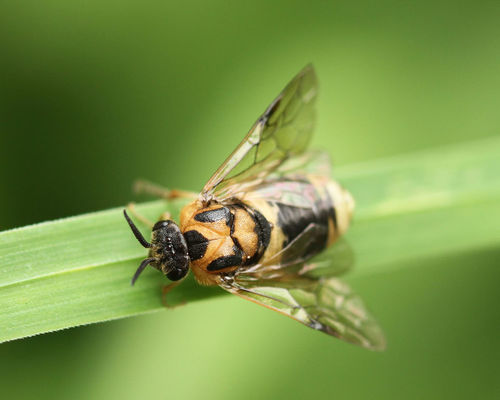
01. Diprion pini Wadborough. Martin Smith
Worcestershire Record | 35 (November 2013) page: 49-50 | Worcestershire Biological Records Centre & Worcestershire Recorders
Unusual centipede found in Worcestershire
Harry Green (compiler)
On 2nd September 2013 Worcestershire Wildlife Trust received the follow enquiry with a picture:
“Please can you help me by identifying this centipede? It was found in my compost heap and is actually paler than in the photo (01), all silver.
Thank you, Reg. Hawkins”.
The picture was passed to me but apart from commenting that it belonged to the group of centipedes living in soil, the Geophilomorpha, I had no idea of its identity. Looking through the identification key (Barber 2008) I thought it looked a bit like Henia vesuviana pictured on page 94. But this is a coastal species! I sent the picture to the author Tony Barber who replied as follows:
“The consensus so far is that it is an immature Henia vesuviana. Adults are more or less transparent greyish with the grey green cells covering the gut and showing through . Also the white longitudinal dorsal vessel. See picture on front of Aidgap Centipede Key. Quite a lot of records from the South Coast and scattered in synanthropic sites also. Most northerly in England is indoors in Lancashire”. He also sent a map (02) of the national distribution and a picture of the centipede (03).
However all was not plain sailing. Tony Barber sent the picture to a colleague who replied
“I have seen plenty of immature H. vesuviana, but this doesn’t look like them – juveniles are distinctly greenish with a pale yellowish dorsal, longitudinal stripe (very like the adults but pale olive green). I don’t know what else it could be……..”
Impasse! The experts disagree. Unfortunately our efforts to contact the finder have so far failed. We hoped he would go foraging in his compost heap and find us a specimen to identify.
On checking the key against the picture it is impossible to confirm the centipede’s identify without a specimen as some distinguishing features can only be seen with a microscope. Easily seen diagnostic features of H. vesuviana are listed in the key and these include both ends of the adult animal being light reddish brown; greenish grey body contents seen through the transparent skin; and a distinct white line along the dorsum which is actually a blood vessel. Reg Hawkins’ centipede shows the last two features but is pale at both ends hence the suggestion that it is a juvenile (the picture on page 94 of the key shows both ends pale). Characteristically H. vesuviana curls up into a ball in soil with the glandular underparts outward. These produce a sticky secretion so the posture is probably defensive.
We cannot be sure of the identity of the is centipede but it is certainly unlike other Geophilomorpha commonly found in gardens and wiidlands. The true habitat of H. vesuviana is coastal with odd records inland usually associated with human habitations and activities (synanthropic). These animals have probably been transported inland by people or goods moved from coastal places.
Reference
Barber, A.D. 2008. Key to the identification of British centipedes. Field Studies Council AIDGAP key.
Images
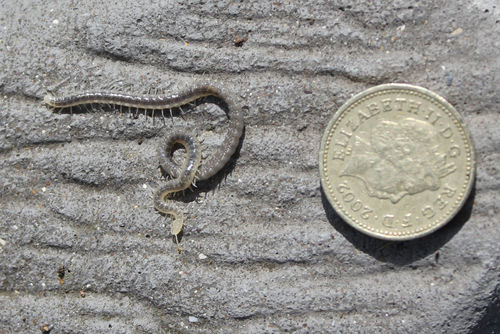
01. Reg Hawkins’ picture of unidentified centipede.
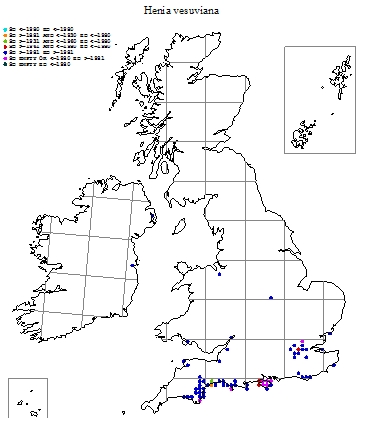
02. Henia vesuviana national distribution map. A D Barber.
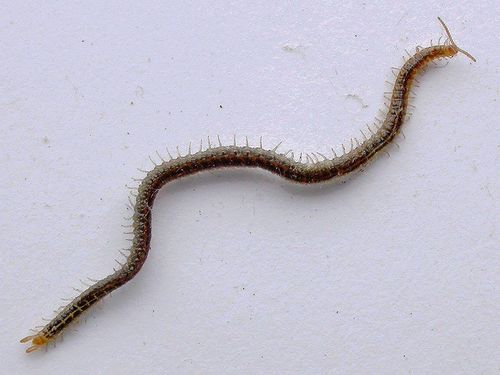
03. Henia vesuviana. A D Barber
Worcestershire Record | 35 (November 2013) page: 18 | Worcestershire Biological Records Centre & Worcestershire Recorders
Hornets stripping Ash bark
Paddy Harrison
On 10 September 2013 I discovered a number of hornets Vespa crabro on young (this year’s) growth of Ash Fraxinus excelsior in the mainly hawthorn hedge opposite my house. They were attacking the bark, stripping it, and as far as I could tell, drinking the sap. I have been able to observe them daily for nearly four weeks.
When I first found the hornets this activity had clearly been going on for some time as the damage to the bark was already extensive. Judging by the speed at which they have since been stripping the bark, I would guess that they had been there for at least three weeks before I found them. The damage was spread over five shoots and now consists of three long (12-15cms) lesions of stripped bark and at least six smaller ones, some only 2cms.
It is impossible to tell for certain whether the hornets themselves initiate the damage or whether they have taken advantage of existing damage, but all strips show a characteristic nibbled edge where they have been at work. There are no signs of cuts or abrasions from other causes and, having watched one of the hornets vigorously having a go at a very small fresh lesion, I feel pretty certain that they are capable of starting one themselves without help.
There have never been any more than seven hornets at any one time, or less than two. They have been there night and day, in all weathers. Individually, their visits to the hedge seem to last quite a long time, departures and arrivals are infrequent. It is odd that I have never seen any debris, that is pieces of bark, dropping from the nibbling insects. It is as if they are consuming what they are stripping. Are they carrying it back to the nest? But for what purpose? Hornet grubs are insectivorous, aren’t they?
Every now and then they stop stripping and appear to be sucking the sap. This (or something else) sometimes seems to make them behave as if they are a little drunk. Unsurprisingly, the sap runs attract other interested creatures, usually various flies, but one night I did find a moth, Angle Shades Phlogophora meticulosa. The hornets are quite tolerant of the flies and only show aggression if they get really close; a lunge is enough to scare off the intruder. I have never seen a wasp try its luck.
This can’t last. Either the farmer will strim the hedge or the first frosts will get them.
Previous report of similar behaviour
Green, H. (compiler). 2011. Hornet stories: Hornets stripping bark and also catching fly; Hornet nest in cordwood near Tiddesley wood and in old nest box. Worcestershire Record. 30:33. http://www.wbrc.org.uk/WORCRECD/issue_30/Green_Harry–Hornets_stories.html
Images
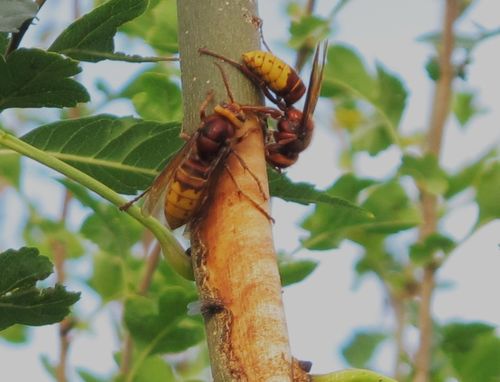
01. Hornets bark stripping on ash. Paddy Harrison
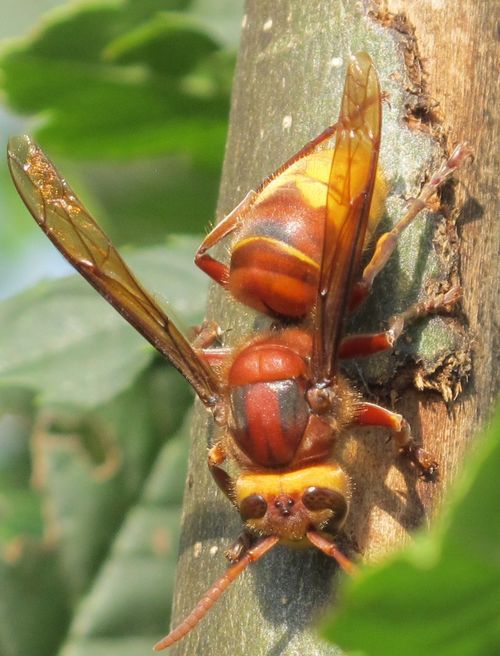
02. Hornet bark stripping on ash. Paddy Harrison
Worcestershire Record | 35 (November 2013) page: 27-28 | Worcestershire Biological Records Centre & Worcestershire Recorders
European rhinoceros beetle Oryctes nasicornis found in Martley
Angie Hill.
Compiled by Harry Green, editor Worcestershire Record
In August 2013 great excitment erupted in the local Worcestershire press and on local radio because Angie Hill found a European Rhinoceros beetle Oryctes nasicornis in Martley. She sent pictures to Danny Arnold of the Teme Valley Wildlife Group and the beetle appeared on their web site www.temevalleywildlife.com. The story was also taken up nationally and the finder mentioned it to Buglife. She emailed Danny as follows:
“Well, I had a phone call from Buglife today and it’s now official! I have the one and only true record of a Rhinoceros beetle in the UK ever! Although archives state that a dead one was found by a builder among old timber in Chelsea in 1836, the true identity wasn’t confirmed at the time. No other records exist. It is fairly common on the continent as far north as Scandinavia, so it is obviously tolerant of cold winters”.
Later in an emails exchange with the editor she wrote:
“I found the female beetle early one morning while checking my moth trap [in my garden]. I noticed it on the leaf of a hardy geranium, near to the trap. I photographed it. I had never seen a beetle as big as that. I initially thought it was a female Stag beetle of some sort. I attended the Rutland Birdfair two weeks later, and while I was on the Buglife stand, I mentioned it to them. They asked me to send a photo, which I duly did. They phoned me back very excited saying it had been identified as a newly emerged female Rhinoceros beetle. They wanted confirmation, so forwarded my photo to two specialists at Oxford University. It was confirmed last week.
“I have never seen one before, and have not seen this individual since. I am hoping that it is not an isolated case, but rather expect that it might well be”.
Your editor had raised the possibility that the beetle had been accidentally imported from Europe hidden amongst garden plants, olive tree stumps, sawdust or similar materials. Angie replied:
“I have a lot of old rotting wood & sawdust in the garden (used as a mulch etc) and various log piles (only from the woodland opposite).mainly of Ash, Willow and Poplar). My garden is not tidy, and is indeed rather wild. Hillend Sawmills is just up the road so it is possible that is where it originated. Martley is a rural-ish village and I doubt anyone round here would have an imported olive stump in their garden. As for bringing it back from a holiday who knows? What I will do is write a short piece for our local Village magazine, asking for people to look out for large beetles like this. I shall also ask around regarding any budding entomologists out there who might have reared one and let it go, accidentally or otherwise.
“Whether this is a one-off due to the beetle having been imported accidentally, or is indeed the beginnings of a small colony here in Worcestershire, who knows? I have to say I find it rather exciting, don’t you?”
In an earlier email your editor had written to Danny Arnold:
“I guess somebody in or near Martley rears exotic beasts and they escape at times or are released or Taylors lorries brought stuff back in the recent past [we have received odd records of reptiles from Martley in the past]. It is very interesting to record these things in case they become established but I very much doubt whether the beetle is a true native”. But who knows? Well worth keeping a look out for very large beetles in or near Martley.
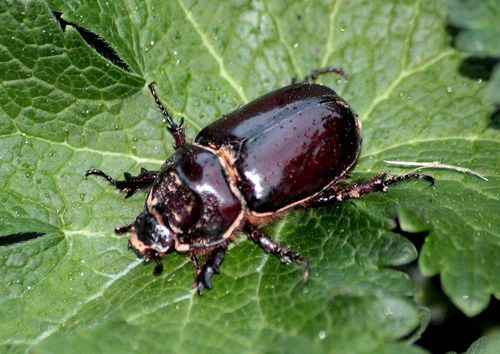
01. European rhinoceros beetle Oryctes nasicornis in Martley. Angie Hill
Worcestershire Record | 35 (November 2013) page: 11 | Worcestershire Biological Records Centre & Worcestershire Recorders
Grey Squirrels and Redwoods
George Hollister
We received the following email from George Hollister dated 2th June 2013:
“I saw the article by about the debarking of redwood trees in 2010 and 2011 by P.F. Whitehead (Worcestershire Record 32 ). I am from the redwood region in California, and grow redwood timber.
The specific debarking in the photo is unusual. Grey squirrels utilize the outer bark of redwood trees for nesting material. And it is possible that a large number of grey squirrels took advantage of the two trees since possibly no other trees were available?
More problematic than the use of the outer bark is when grey squirrels strip the bark down to the cambium to access the sugar. In my experience this happens in May, and often results in the death of the portion of the tree above where the bark is stripped. Redwood trees living alongside grey squirrels that have dead tops is a common occurrence in Mendocino County, California.
George Hollister
Comptche, CA 95427”
Paul Whitehead commented:
“I found George Hollister’s observations interesting; it never occurred to me that a reader in California might have encountered this in the wild. His observations add to the interest of the piece because they illustrate convergent behaviour in different regions occurring independently of each other. There cannot be too many opportunities for Grey Squirrels to coexist with Redwoods in Britain and at the few sites I can recall (e.g. Leighton Hall) the trees haven’t been subjected to this damage.
Elsewhere in Evesham where mature Redwoods still exist there has been no sign of any squirrel debarking and the one Redwood in this parish (Little Comberton) has never been affected.”
Reference
Whitehead, P. F. 2012. Grey squirrels Sciurus carolinensis Gmelin debarking a mature Coast Redwood Sequioa sempervirens Endlicher in Evesham town, Worcestershire during the 2010-2011 winter. Worcestershire Record 32:20.
Worcestershire Record | 35 (November 2013) page: 11 | Worcestershire Biological Records Centre & Worcestershire Recorders
Worcestershire Record | 35 (November 2013) page: 9 | Worcestershire Biological Records Centre & Worcestershire Recorders
Recording in traditional orchards
Becky Lashley
The Worcestershire Biological Records Centre (WBRC) has been awarded a two-year grant from the Heritage Lottery Fund (HLF) to promote and increase recording within traditional orchards. The project aims to increase our knowledge of the distribution of key species associated with orchards – such as Noble Chafer Gnorimus nobilis, Mistletoe Marble Moth Celypha woodiana and Mistletoe Weevil Ixapion variegatum – by encouraging existing recorders to focus effort on old orchards and to recruit and train new volunteers. You may be aware of a new National Inventory for Traditional Orchards published in 2012, which was compiled using predominantly aerial photograph interpretation. The validity of the inventory and the condition and current management of many of the orchards on it still requires ground ‘truthing’ and we would like volunteer support to assist with this.
The HLF grant is funding a part-time project officer position – filled by Becky Lashley, who many of you will already know – to co-ordinate and support recording effort. A considerable number of orchard owner contacts are now being followed up to secure access permissions for survey work. Since the project began in June 2013 it has recorded three new county sites for Noble Chafer and one for Mistletoe Weevil.
There are a number of ways in which we would like support from recorders in Worcestershire. The ‘ground truthing’ of the National Inventory has already been mentioned. In addition to this, if you can help to locate owners and arrange survey permissions for old orchard sites in your local area, please flag these up to WBRC so that we can visit them. If you would like to actively assist us with surveys then do contact Becky on becky@wbrc.org.uk or 01905 759759 who will keep you informed of visits that are organised. There is also a project newsletter that you can subscribe to.
As well as Noble Chafer and Mistletoe insects we are interested in records of mosses and lichens on the trunks of fruit trees and would like to link recording with the OPAL air pollution survey www.opalexplorenature.org/airsurvey. The Field Studies Council has recently published identification guides to the mosses and lichens commonly found in orchards and WBRC has a stock of these and other guides available to recorders willing to use them and return the data.
Finally, we would be very interested to hear from recorders willing to participate in a monthly bird survey – this could be within an orchard already known to you or we can match you up with an orchard on our database in your area. We would like the traditional orchard bird survey to run throughout 2014, providing us with data on species using the habitat at different times of year. For those familiar with the BTO’s online recording systems, the survey data can be submitted via BirdTrack and provided to WBRC as an excel file.
If any part of the traditional orchard recording project is of interest to you please don’t hesitate to get in touch with Becky on becky@wbrc.org.uk or 01905 759759.
Images
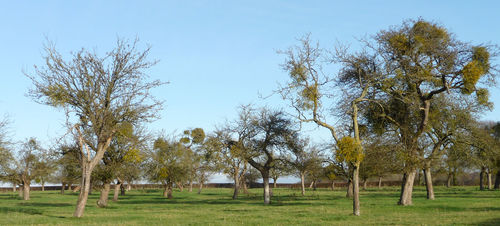
01. Traditional apple orchard with mistletoe. Harry Green

02. Ixapion variegatum, the Mistletoe Weevil. Jonathan Briggs
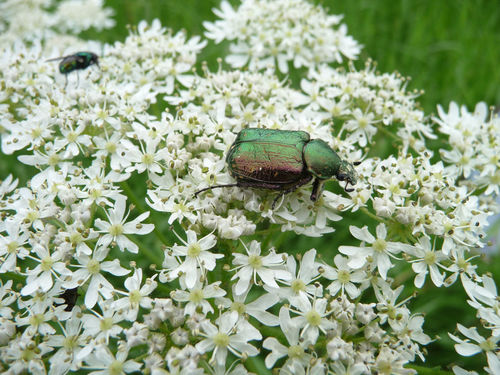
03. Noble chafer Gnorimus nobilis on Hogweed flower. Harry Green
Worcestershire Record | 35 (November 2013) page: 54-55 | Worcestershire Biological Records Centre & Worcestershire Recorders
Border Bryologists 2014
Mark Lawley
Meetings January to March 2014.
Our meetings are to help beginners learn their mosses and liverworts, rather than high-powered recording sessions. All are on Sundays, and start at 10.30 a.m unless stated otherwise. Please bring sandwiches.
You may wish to bring with you a copy of the British Bryological Society’sMosses and Liverworts of Britain and Ireland: a Field-guide (2010), files for which are also on-line at http://www.bbsfieldguide.org.uk/ (or click on the book cover of the Field-guide on the left-hand side of the BBS web-site’s home page at http://britishbryologicalsociety.org.uk/ and follow the links).
You are very welcome to suggest venues for future outdoor meetings; please include grid references and details for parking.
January 19th
Jonathan Sleath will lead us at Cherry Hill Camp (an Iron-age hill-fort) and Fownhope Park Wood, Fownhope, Herefordshire, where ancient semi-natural woodland overlies calcareous Silurian rocks. Park in the village of Fownhope, and meet at SO 577347 by the side of the road that leads to Woolhope.
February 14-16th
This weekend bridges the gap between our one-day meetings for local bryologists and the BBS’s traditional week-long field meetings, and offers an opportunity for local naturalists who may find it difficult to commit the time taken up by the Society’s longer meetings to meet experienced bryologists from further afield, and to improve their bryological skills in the company of BBS members. In turn, bryologists visiting Shropshire from other parts of the country will enjoy the opportunity to see uncommon species that may not occur on their home patches. The meeting is open to beginners and experts alike. Please let me know in advance if you intend coming to this meeting, and note that each day’s adventures start at 10 a.m. (not 10.30 a.m.).
The meeting will be based in Ludlow, and details of various types of accommodation available locally can be obtained from Ludlow Tourist Information Centre (email: ludlow.tourism@shropshire-cc.gov.uk or Tel: 01584 875053). I can offer bed and breakfast without charge at my home for up to two people who would like to come on the meeting but cannot easily afford serviced accommodation away from home (e.g. students or unemployed).
Ordnance Survey Landranger 137 covers Titterstone Clee Hill and the Long Mynd. Explorer map 203 covers Titterstone Clee Hill, and 217 covers the Long Mynd.
We will follow the programme outlined below if the weather is clement, but may need to divert to more sheltered, low-lying venues if the weather is poor.
Friday February 14th
I will be at The Nelson Inn from 8 p.m. until about 10 p.m. We can firm up the weekend’s programme in light of the forecast, and perhaps also rationalise transport for driving to the Long Mynd on the following day.
The Nelson is a traditional beer-house that serves excellent draught beer, and a limited menu of hot food in the evenings. It offers B&B, and lies on the outskirts of Ludlow, but within walking distance of the town at SO 524757 on the Kidderminster/Clee Hill road (A4117), about 100 yards east of the A49 bypass.
Saturday February 15th
Meet at 10 a.m. in the car park (SO 456955) at the bottom of The Batch just west of All Stretton. From there we will walk up Nover’s Hill to see Jamesoniella undulifolia Barbilophozia kunzeana, and possibly Scapania paludicola in the little mire near the top of the hill. Grimmia montana also grows in small quantity on rock nearby, and we may see Schistostega pennata lurking in disused rabbit burrows.
In the afternoon, we will explore a flushed valley on another part of the Mynd. If enough experienced members attend the meeting, I’d like to see what expert bryologists can discover by closely examining one or two selected flushes. Jamesoniella undulifolia Barbilophozia kunzeana, and Scapania paludicola are all known from other flushes on the Mynd, along with other notable species such as Cephalozia pleniceps, Leiocolea bantriensis, Sphagnum platyphyllum and S. subsecundum. Can we find new sites for these and/or other as yet undiscovered species?
Sunday February 16th
Meet at 10 a.m. in the car park near the top of Titterstone Clee Hill (SO 593776). Block scree on the western side of the hill (to the north of the car park) holds prodigious quantities of Grimmia incurva, along with more modest amounts of Rhabdoweisia crispata and Tetraplodon mnioides.Circling clockwise round the hill and down on to the hill’s eastern flank we may find Gymnomitrion obtusum, and one or two flushes may also repay inspection.
March 16th meeting with Worcestershire Moss Group
Meet with the Worcestershire Moss Group at Hollybed Farm, Chandler’s Cross near Welland, between Castlemorton Common and Hollybed Common. The farm is a nature reserve of the Worcestershire Wildlife Trust: damp, shady valley with a stream and marshy patches, SSSI grassland, old orchard and hedges. Park on the roadside verge by a gate into a field at SO 779382.
For more information contact
Mark Lawley, 12A Castleview Terrace, Ludlow SY8 2NG. Email: m.lawley@virgin.net
Now available:
The mosses and liverworts of Shropshire
by Mark Lawley (2013)
133 pages, illustrated, including:
a bryological travelogue of good localities
changes to the county’s bryoflora
annotated checklist of species
Shropshire’s bygone bryologists
Available @ £19.95 including P&P from
Mark Lawley, 12A Castleview Terrace, Ludlow SY8 2NG
Please make your cheque payable to ‘Mark Lawley’.
Worcestershire Record | 35 (November 2013) page: 54-55 | Worcestershire Biological Records Centre & Worcestershire Recorders
Worcestershire Record | 35 (November 2013) page: 17 | Worcestershire Biological Records Centre & Worcestershire Recorders
Hornets’ Nest
Garth Lowe
For many years a queen hornet has appeared in late spring around our house at Old Storridge, but this year (2013) after the cold start it was not until 28th June that one first appeared. It is possible that the same hornet took over a bird box nearby in the nature reserve, as it is only a short distance away. It was first noticed in July, while I was doing the weekly butterfly transect walk, when workers were filing in and out of the entrance hole. The previous bird occupants would have left the box by then, making it a home again for another species.
It is hard to believe they constructed the nest shown in the picture (01) over about four months! At first it was all inside the box, but from previous similar old reports it was obvious they would not stop there. The original hole was at the front, but it was a surprise when they built a basement with no access, unless they had chewed another hole in the bottom. It will be interesting to see if they have, when they all die off, probably after the first frosts. The new parts of this nest were observed to provide at least three entrances, but whether they all went to the original entrance we shall have to wait and see. Assuming the queen is still alive she could be a year old by now as new queens and males usually emerge late summer or early autumn. By the 8th November 2013, on a cool damp morning, there were still workers going in and out of the nest.
The nest probably went un-noticed by most visitors even though they passed within a few feet of it, showing how tolerant the hornets are. It was just a couple of kids that got stung on a school visit, and they might have been messing about there. The leaders should have been told, because the chap in charge knew about the nest as soon as it was spotted.
Images

01 Hornet nest on bird nest box, Garth Lowe.
Worcestershire Record | 35 (November 2013) page: 54 | Worcestershire Biological Records Centre & Worcestershire Recorders
Winter Robins in a garden
Garth Lowe
The interest in feeding and watching birds in the garden sometimes raises questions, especially when we have a cold winter as as happened in the last two winters. There seemed to be quite a number of Robins appearing in my garden at Old Storridge in the winter of 2011-2012; more than the usual couple of birds holding territories either side of the feeders. As a small experiment a manually operated trap was set up and the Robins were targeted, caught and ringed. The first bird was caught in the middle of December and the last one at the start of February.
Just two birds were caught in the first month, seven in January, and eleven in February, giving a total of twenty different birds! This was quite a surprise considering individuals normally have winter territories, which they supposed to hold quite vigorously.
During the next winter 2012-2013 the study was continued and with a longer cold winter Robins were caught from the middle of November until right into March, when the last one was caught on 20th. Monthly totals were November just one, none in December. seven in January, seventeen in February, which was a cold month, and eight in March, when the winter dragged on. This gave a grand total of 33 birds, of which eight had been previously ringed in the garden. This does show that we may be underestimating just how many Robins are taking advantage of extra feeding in gardens in a cold winter. This study was prompted by the fact that in the first winter sometimes five robins could be viewed at once, which seemed unusual.
This species is migratory but only a few ringed birds from Britain have been recovered in the Low Countries, France and Spain in the winter. In autumn some birds arrive here from the Continent on their way south, with peak numbers arriving in October. This seems to indicate that these garden birds were not foreign, but ones that were present in the countryside around the garden, shown by the 25% already ringed robins that found their way back for a second winter. One odd ringing recovery of a wintering bird was of a juvenile caught in July in Surrey and three years later found in Switzerland in April! Another of a young bird ringed in Montgomeryshire and subsequently found dead the next winter 1600 km away in southwest Spain (Wernham et al 2002.
Coming more up to date, a solitary robin that appeared to have claimed the garden as its territory, caught in November 2013, was shown to be a bird from the year (2013). It does appear that it may have ousted the previous holder even though it was a young bird!
Reference
Wernham, C.V., Toms, M.P,. Marchant, J.H., Clark, J.A., Siriwardena, G.M.,& Baillie, S.R. (Eds) 2002. The Migration Atlas: movements of the birds of Britain & Ireland. T & AD Poyser, London.
Worcestershire Record | 35 (November 2013) page: 54 | Worcestershire Biological Records Centre & Worcestershire Recorders
Worcestershire Record | 35 (November 2013) page: 3-5 | Worcestershire Biological Records Centre & Worcestershire Recorders
The flora of Worcestershire
Roger Maskew
The forthcoming Flora of Worcestershire is the first comprehensive account of the flora of the county since The Botany of Worcestershire by Amphlett and Rea in 1909 which is now hopelessly out of date. Since then land use has greatly altered and the rate of change has accelerated in the past fifty years with a revolution in farming practices. Consequently there has been a need to re-assess the numbers and distributions of the species remaining in the countryside. It is essential that naturalists in other fields and conservationists have information on the status and distribution of the flora, especially with regard to rare and endangered species.
With this in mind the Worcestershire Flora Project was set up in 1987 and between then and 2005 a small group of amateur but experienced botanists systematically surveyed the county. Recording has been within the old Watsonian vice-county 37, plus additional areas which are part of the current administrative county. It was decided that the recording unit would be a tetrad (2×2 km square) of which there are 596 in Worcestershire. Each hectad (10×10 km square) was controlled by a co-ordinator responsible for organising the field recording, coverage and record keeping for each for their squares. A specific Worcestershire recording card was designed to include some 900 of the species likely to be encountered, with provision for the details of any additional species. With regards to scarce and critical species, the recorder was required to give full details that included a six-figure grid reference, locality and habitat and, where it was responsible to do so, a specimen was collected to support the record.
One important aspect of the recording has been the extensive coverage of difficult plant groups, especially the very critical genera, Rubus (Brambles), Taraxacum (Dandelions), Rosa (Roses) and Salix (Willows). Well known as presenting formidable obstacles to identification these groups have been circumvented in many other county Floras. In some cases, where there has been insufficient local expertise, specimens have been sent to the appropriate national experts for correct determination and, on several occasions, these experts have visited the county.
General recording was concluded at the end of 2005 since when information has been continuously updated on important species while the Flora was being written. At present the Flora database holds over 700,000 individual records and information on at least 2,500 species that are known to occur or have previously occurred in the county. This includes all the native species and alien species which have become either naturalised in the wild or are of casual occurrence.
The first part of the Flora includes introductory chapters on post-war land use, the history of recording in the county, geology and soils, habitats and changes in plant status. The second and most important part of the Flora covers the species accounts. Many of these are accompanied by distribution dot maps and throughout this section there are over 400 coloured photographs of plants in their typical habitats (01, 02 & 03).
Fully detailed accounts are given for the less common, declining and critical species and include information on local variation and infraspecific taxa (sub-species, varieties etc.) and details of habitat, frequency and distribution, temporal changes etc. Much previously unknown historical information is included. This has only been discovered after searching all the known literature and, in particular, the examination of herbaria, especially the Worcester Museum Herbarium which includes many thousands of plants collected by several of the early botanists from the 1820s onwards and the major collections of William Mathews and Richard Towndrow.
It was soon realised that it would be necessary to raise funds for publication. With this in mind the Worcestershire Flora Project became a registered charity (no. 1040495) in 1995. Recently the charity has received financial support from a number of supporters, including generous donations from Worcestershire County Council, Worcestershire Wildlife Trust and The Helen Rachael Mackaness Charitable Trust.
It is proposed to publish the Flora privately during the early part of 2014. The publication will be the most thorough and extensive undertaken by any natural history, conservation or closely associated body in Worcestershire and will provide important details of its flora for botanists, students and town and country planners alike.
Two near final draft pages from the Flora follow to give a taste of the contents of the book (04 & 05).
Images
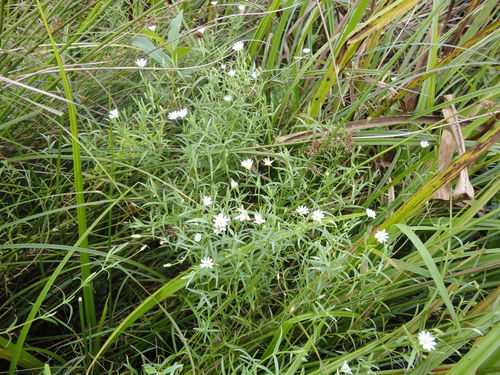
01. Stellaria palustris (Marsh Stitchwort), a rare Worcestershire species.
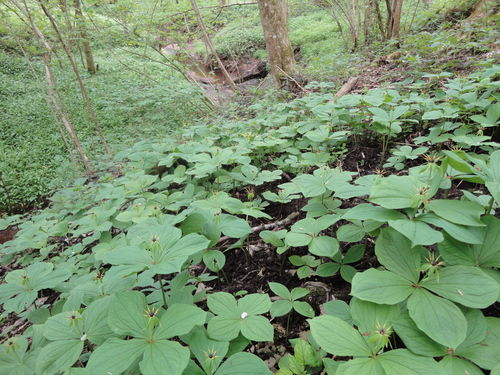
02. Paris quadrifolia (Herb Paris) a local plant of ancient woodland.
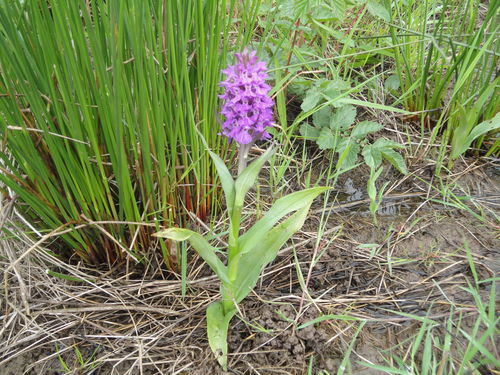
03. Dactylorhiza praetermissa (Southern Marsh Orchid), locally frequent in the north of the county.
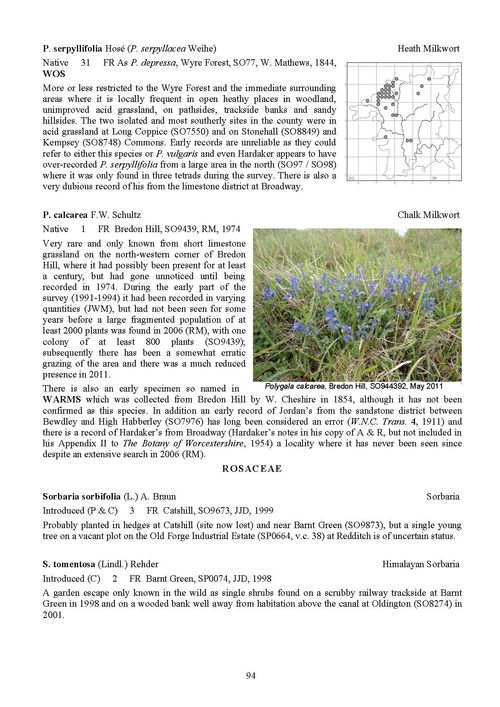
04. a sample page.

05. a sample page.
Worcestershire Record | 35 (November 2013) page: 38 | Worcestershire Biological Records Centre & Worcestershire Recorders
Elephant Hawkmoth and Bogbean
Bert Reid
In Worcestershire Record Number 27 (November 2009) Wendy Johnson reported that an Elephant Hawkmoth Larva Deilephila elpenor was feeding on Bogbean Menyanthes trifoliata in her garden pond. I read this at the time, and probably thought it odd and unusual, but then promptly forgot all about it.
I was therefore surprised when my wife called me out to the garden to look at a large caterpillar that was feeding on the Bogbean in the pond. It was clearly a late stage larva of Elephant Hawkmoth, so I took a couple of photographs, and showed them to a few naturalist colleagues. It was only then that I was reminded of the 2009 article.
The earlier article showed that my experience was not unique, but still left many questions unanswered. None of my books suggested Menyanthes as a food plant and I had never found the larva in wet vegetation. We looked to see what the caterpillar did for several days, but every morning and evening it was sitting in the same spot on the same leaf although some other leaves seemed to have more eaten overnight. And where and how would it pupate. Then one morning it had disappeared.
I asked Harry Green for advice, and he pointed me to Sphingidae of the Western Palaeartic. This website (http://tpittaway.tripod.com/sphinx/d_elp.htm) was very useful and answered some of my questions. Menyanthes does get a mention as a “Minor Host-plant”. The first habitat mentioned under Adult Biology is “Frequents the flood-plains of streams and rivers”, so maybe I just haven’t looked hard enough for the larva in wet vegetation. The pupation question is more difficult. The website says “Pupation takes place very close to the host-plant in a strongish mesh cocoon amongst debris on the ground”, although there is some suggestion that aspects of pupal behaviour “may be an adaptation to avoid drowning during flooding of the habitat” I find it hard to believe that our larva could have climbed out of the pond, so I am unsure what did happen to it.
References
Johnson, Wendy. 2009. Elephant Hawkmoth larvae eating Bogbean in garden pond. Worcestershire Record 27:17-18. http://www.wbrc.org.uk/WORCRECD/Issue%2027/elephant_hawkmoth_eating_bog_bean.htm
Pittaway, A.R. 1993. The hawkmoths of the western Palaearctic. Harley Books, Colchester.
Sphingidae of the Western Palaeartic. Website http://tpittaway.tripod.com/sphinx/d_elp.htm.
Images
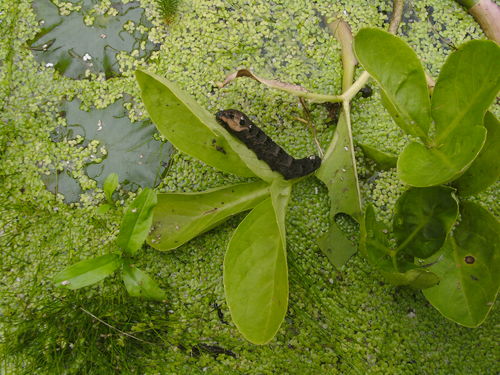
01. Elephant Hawkmoth larva on Bogbean. Bert Reid
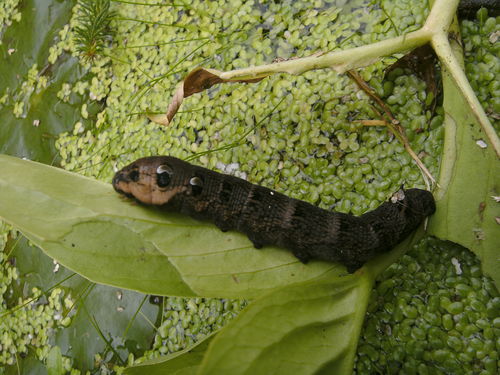
02. Elephant Hawkmoth larva on Bogbean. Bert Reid
Worcestershire Record | 35 (November 2013) page: 55-56 | Worcestershire Biological Records Centre & Worcestershire Recorders
Should we record that plant? Some questions raised in 2013
Bert Reid
It is often a difficult decision whether or not record some plants or not. Native plants and long-established introductions in the wild are obviously worth publishing, but what should we do with casuals, and just what qualifies as “in the wild”? 2013 has provided several examples that raise these questions, in particular with garden plants, planted street trees and arable introductions planted as conservation field margins or game bird feed. I need to reach some conclusions before I publish a full report on this year’s plant records. Horticultural escapes raise most difficult questions.
I have mainly recorded in SO93 this year, adding many new records for the hectad. Very few of these additions are native plants. What should I do about the following?
Brachyglottis x jubar (Shrub Ragwort) – Pigeon Lane Overbury – SO9637
Calendula officinalis (Pot Marigold) – Conderton Village – SO9637
Campanula medium (Canterbury-bell) – Overbury Village – SO9637
Campanula persicifolia (Peach-leaved Bellflower) – Bredon Parish – SO9336
Campanula poscharskyana (Trailing Bellflower) – Teddington Village – SO9633
Centaurea montana (Perennial Cornflower) – Teddington Village – SO9633
Corydalis solida (Bird-in-a-bush) – Bredon Village Off B4079 – SO9236
Eryngium giganteum (Tall Eryngo) – Mitton north of Tewkesbury Mitton Way – SO9033
Gilia tricolor (Bird’s-eyes) – Bredon Village Off Queensmead – SO9336
Iberis amara (Wild Candytuft) – Bredon Village Queensmead – SO9336
Iris sibirica (Siberian Iris) – Crashmore Lane – SO9634
Malva x clementii (Clements Tree-mallow) – Overbury Village – SO953
Portulaca grandiflora (Rose-moss) – Overbury Village – SO9637
Silene coeli-rosa (Rose-of-heaven) – Overbury Village – SO9637
Tradescantia virginiana (Spiderwort) – Bredon Village Blenheim Drive – SO9336
Zauschneria californica (Californian Fuschia) – Mitton north of Tewkesbury Mitton Way – SO9033
Or these records passed to me by Keith Barnett?
Cerinthe major (Honeywort) – Chance Lane Hall Green – SO8045
Geranium x magnificum (Purple Crane’s-bill) – Barnards Green area – SO7946
Hemerocallis fulva (Orange Day-lily) – Barnards Green to Guarlford road – SO7945
Heuchera x brizoides (Coral-bells hybrids) – Hanley Swan – SO8142
Kniphofia praecox (Greater Red-hot-poker) – Great Malvern Elgar Avenue – SO7946
Weigela florida (Weigelia) – Malvern Wells St Wulstans NR – SO7841
All these records are believed to be correctly identified so the main question is about whether they are sufficiently away from gardens to rule them out or not. The other question is are they clearly planted and unlikely to become naturalised. Some records clearly meet these criteria. The Shrub Ragwort is on a roadside away from houses, where it has been known for over 10 years. Pot Marigold, Trailing Bellflower, Perennial Cornflower, Bird-in-a-bush, Clements Tree-mallow and several others are well known plants locally, that often escape the garden confines and are traditionally counted as recordable. Some of the others are locally rare or in some cases previously unknown in our area. These need greater care, especially new county records (Tall Eryngo, Bird’s-eyes, Wild Candytuft, Rose-of-heaven, Californian Fuschia, Coral-bells hybrids and Weigelia).
An important consideration is what to do about deliberate planting on road verges, as is often seen at the entrance of villages. In Overbury where the main village road joins Pigeon Lane, there is a grassy bank by a seat. This appears to have been originally planted up with garden plants and the records for Rose-of-heaven and Canterbury-bell are from this bank, although other plants here are normal natives. Other road verge plants in Overbury such as Rose-moss are clearly accidental casuals from road works.
More difficult questions arise when garden plants are only just out of the garden. I have no hesitation in accepting the Tall Eryngo on Mitton Way, since this is not in any nearby garden, but the Californian Fuschia from within a few metres of the same spot is more of a worry. This is a very rare casual in Britain, and is only sold by a very few specialist dealers. But it was growing in the nearest garden (with several normal Fuchsias) and a single plant had jumped over or burrowed under a tall garden fence. It is not clear whether the plant had appeared from seed or vegetative growth, but either way it disappeared a couple of months later and is a casual at best. The Bird’s-eyes were in a lock-up garage area where unofficial track enters from a footpath. The plants are not planted and well away the gardens, but the Wild Candytuft grows on the vehicle entrance by the houses and must be a garden escape. It seems unlikely that the Wild Candytuft would be grown in a garden, but the plants were carefully checked and were not the usual garden species. I think this record needs confirmation in 2014. Keith Barnett’s Coral-bells hybrids and Weigelia are both acceptable records although the first is a single plant only just outside the garden and the second is a single relic shrub in a nature reserve.
The questions about arable introductions planted as conservation field margins or game bird feed are different but simpler. I have selected a few of my own records as examples, but could have produced a much longer list.
Anisantha diandra (Great Brome) – Overbury Parish – SO9638
Camelina sativa (Gold-of-pleasure) – Westmancote – SO9338
Capsicum annuum (Sweet Pepper) – Bredons Norton Parish – SO9339
Chenopodium quinoa (Quinoa) – Westmancote – SO9338
Bromus secalinus (Rye Brome) – Westmancote – SO9338
Chaenorhinum minus (Small Toadflax) – Kinsham Footpath to gravel pit – SO9335
Cichorium intybus (Chicory) – Westmancote – SO9338
Fagopyrum esculentum (Buckwheat) – Westmancote – SO9338
Helianthus annuus (Sunflower) – Bredons Norton Parish – SO9339
Panicum miliaceum (Common Millet) – Westmancote – SO9338
Phacelia tanacetifolia (Phacelia) – Crashmore Lane – SO9535
Raphanus raphanistrum (Wild Radish) – Crashmore Lane – SO9634
Setaria viridis (Green Bristle-grass) – Overbury Park – SO953
Trifolium incarnatum (Crimson Clover) – Lower Smite Farm – SO8952
Trifolium resupinatum (Reversed Clover) – Lower Smite Farm – SO8952
Zea mays (Maize) – Bredon Hill – SO9737
These examples show a number of issues that need policy decisions. The Great Brome is growing on what was a conservation arable strip but now the other characteristic plants of this habitat have all disappeared. Gold-of-pleasure is a rare and declining archeophyte from a conservation strip on Adrian Darby’s land. He found some more on another of his fields well away from this one. Quinoa, Buckwheat, Chicory, Sunflower, Common Millet, Green Bristle Grass, together with Crimson Clover and Reversed Clover (from Lower Smite Farm) all tell the same story. Rye Brome and Small Toadflax are natives or archeophytes that will always be recorded. The Phacelia and Wild Radish from Crashmore Lane are rather different. Here we see large arable field planted up with the two species, giving a colourful display. Is this planning for soil improvement? Maize adds a rather different problem. The plant is grown on field scale as food for humans and farm animals as well as pheasant feed, often on a smaller scale. Is this appropriate for recording, or should we make decisions based on scale and purpose? The final plant to consider is the Sweet Pepper or in this case the alternative name of Sweet Chilli. The details here were about 20 plants of Chilli Peppers growing on disturbed soil about 10m into rape field. Other edges of field, but not this edge, have been planted with Phacelia, Buckwheat, and White Mustard. There were a few empty seed packages with the disturbed soil (not Chilli) and it was clear the species had not been planted in situ. The source is a mystery but my guess is rubbish cleared from a greenhouse.
I will say little about other records here, just mentioning four plants.
Acer cappadocicum (C hopeappadocian Maple) – Pigeon Lane Overbury – SO9637
Acer saccharinum (Silver Maple) – Conderton – SO9636
Phytolacca acinosa (Indian Pokeweed) – Pershore Town – SO9445
Taxodium distichum (Swamp Cypress) – Conderton – SO9636
The Cappadocian Maple is a large planted tree on a lane side verge with many suckers, known here since 2003. The Silver Maple is a single small tree by a roadside ditch. This is less obviously naturalised, but the species often survives well and has the potential to naturalise in future years. The Swamp Cypress is more like the Cappadocian Maple. Again this has been known here since 2003, but this is growing in the corner of a field near the road.
The last record I will mention is Indian Pokeweed. This was recorded by my wife and daughter in my home town, and needed them to point me to the site. There was one tall plant in flower at base of a hedge between footpath and cricket field. At least I identified it!
I hope that this report has given you some understanding of what is needed to record non-native plants. I have almost certainly made you think that only experts with years of experience can record unfamiliar plants. THIS IS NOT THE CASE. Just remember a few simple rules. All records are useful if they are passed to someone who may understand more than you. Everyone from beginner to expert (and anywhere between) will get things right and things wrong, There is help out there: a reasonable photo sent to me or another local “expert” can often save you hours of work. And finally, ENJOY YOUR BOTANY. Plant hunting and recording is fun and ALL RECORDS ARE USEFUL.
Worcestershire Record | 35 (November 2013) page: 55-56 | Worcestershire Biological Records Centre & Worcestershire Recorders
Worcestershire Record | 35 (November 2013) page: 44 | Worcestershire Biological Records Centre & Worcestershire Recorders
Damage to Ash leaves by feeding moth larvae
Tony Simpson
As we are all looking anxiously at Ash trees at present for signs of Ash Die-back fungal disease I thought it might be of interest to draw attention to another cause of visible damage to Ash foliage.
The micromoth Caloptilia syringella (Fabricius) is a common insect of the Gracillariidae family, which as the name implies feeds on Lilac Syringa vulgaris, but more commonly on Privet Ligustrum spp. and Ash Fraxinus excelsior.
The feeding larvae first mine the leaves, often communally, causing discoloured brown blotches which often eventually become raised and inflated. In the final instar it rolls the leaves feeding within before leaving to pupate in a cocoon. Although damage from larval feeding can lead to dried up brown leaves it does not cause wilting of foliage nor dead twigs and branches. This autumn (2013) the feeding signs of this insect have been very common on Ash across Worcestershire.
In May feeding larvae of the micromoth Prays fraxinella (Bjerkander) in the shoots causes transient wilting and drooping of the leaves of Ash but the leaves are not discoloured and most seem to recover when the larvae finish feeding.
Images

01. Caloptilia syringella damage to ash leaves
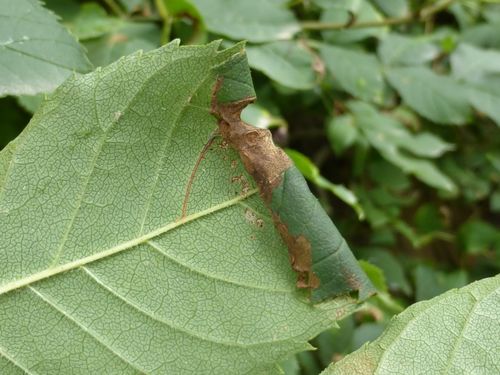
02. Caloptilia syringella damage to ash leaves.
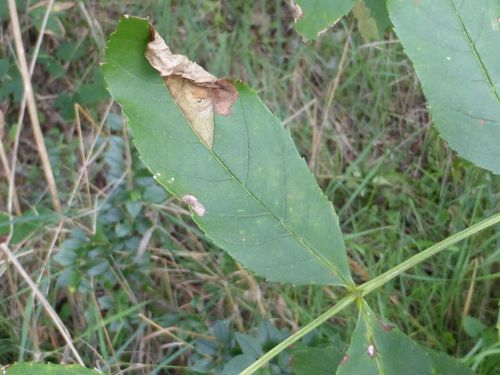
03. Caloptilia syringella damage to ash leaves
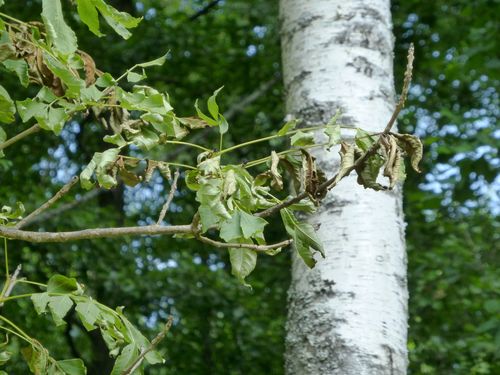
04. True Ash die-back in Estonia. Tony Simpson
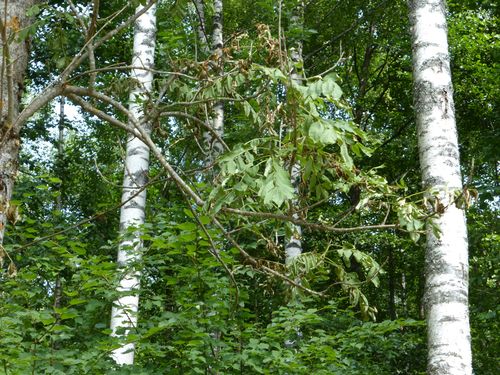
05. True Ash die-back in Estonia. Tony Simpson
Worcestershire Record | 35 (November 2013) page: 45 | Worcestershire Biological Records Centre & Worcestershire Recorders
Ramshorn Gall Andricus aries found in Worcestershire.
Tony Simpson and Brett Westwood
Tiny Simpson wrote “I noticed an unusual gall on an oak at the new Worcestershire Wildlife Trust reserve at Hollybed Farm on 30 August 2013 (01). I sent a photo to Rosemary Winnall who identified it as a Ramshorn Gall caused by the gall wasp Andricus aries. This was confirmed by Peter Shirley who thinks it is probably the first record for the West Midlands of a species which has been spreading rapidly in the U.K. in the past few years.”
On seeing Tony Simpson’s picture Brett Westwood wrote “Here is a picture (02) of a mangled Andricus aries Ramshorn gall taken in early October 2013 at Blakeshall in the extreme north of Worcestershire at grid reference SO833815 . Normally they are long and flattened but this one had been damaged by a hedge flailer. First record for northern Worcestershire”.
These two records from north and south Worcestershire call for a determined search between the two points to help record the progress of two new galls. In 2002 John Meiklejohn illustrated this gall and other new arrivals and encouraged recorders to look out for them in Worcestershire. He wrote “Another gall not yet found in Worcestershire was first recorded in Britain in 1997 near Maidenhead and has begun to spread further afield. This is the Rams-horn gall, Andricus aries. It is not an acorn gall but develops in a variety of noticeable forms on a bud on a twig. The differing forms are due to the activities of parasites and inquilines. Its sexual stage is found on the catkins of Evergreen Oak”.
Reference
Meiklejohn, J. 2009. New oak galls in Worcestershire. Worcestershire Record. 26:14-15
Images
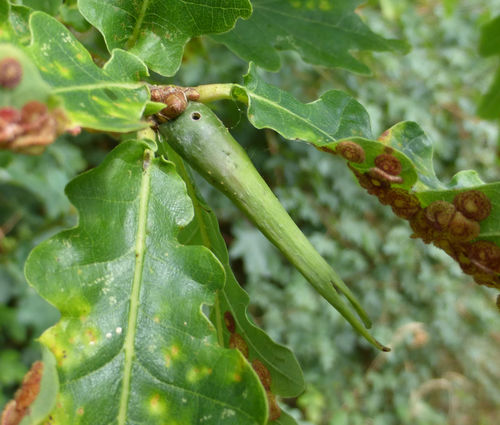
01. Ramshorn gall Andricus aries at Hollybed Farm. Tony Simpson

02. Ramshorn gall Andricus aries at Blakeshall. Brett Westwood
Worcestershire Record | 35 (November 2013) page: 39-42 | Worcestershire Biological Records Centre & Worcestershire Recorders
Aculeate hymenoptera of the Devil’s Spittleful and Rifle Range Reserves at Kidderminster
Geoff Trevis and Rosemary Winnall
The aculeate hymenoptera (bees, wasps and ants) may be found in almost any habitat but they reach maximum diversity and numbers on areas of sandy soils, particularly those associated with heaths, which provide rich sources of nectar and pollen and ideal soils for nesting. Most, though not all, also prefer a warm climate and hence their abundance is highest in the south east of Britain and lowest in the north and north west of Scotland. The most important sites occur on the Surrey heaths which have been thoroughly surveyed. There appears to be some degree of recorder bias in the national distributions, i.e. hot-spots occur where competent hymenopterists are active but sufficient data have been accumulated through the work of the Bees, Wasps and Ants Recording Society to make the currently accepted distributions generally reliable.
Whilst not having the range of species found in the south of England, Worcestershire is fortunate in lying at the north-west limit of the southern species and on the southern limit of several northern species. For this reason it is key in monitoring any changes in distribution resulting from climate change.
Generally the most important hymenoptera sites are found on the north west heaths in the county at the Devil’s Spittleful reserve, Rifle Range reserve, Hartlebury Common, Burlish Top, Habberley Valley etc. though some hot spots are also found in the south west around Bredon Hill e.g. at Kemerton Lake reserve and Beckford gravel pit. The current study was undertaken at the request of Wyre Forest District Council and Worcestershire Wildlife Trust to provide an up to date species list for the Devil’s Spittleful Reserve (Worcestershire Wildlife Trust) and the Rifle Range Reserve (Wyre Forest District Council). . Pictures 01 and 02 are of the reserves.
The importance of the Devil’s Spittleful and Rifle Range reserves and Hartlebury Common in a national context was recognised in the 1990’s by Dr. Michael Archer and Colin Plant, both national experts, when they conducted surveys at different seasons between 1991 and 1997. Since then the reserves have undergone changes as a result of management, ecological succession and, probably, climate change. Unfortunately, since 1997 there has been little recording at any of these sites so the 2013 survey provided the opportunity to assess changes in hymenoptera occupying the Devil’s Spittleful and Rifle Range, using the Dr. Archer’s and Colin Plant’s data as the baseline. The results are shown in the table with other records since 2000 included in the third column. It is immediately obvious how little recording was undertaken between 1997 and 2013. It should be noted that the data presented are from author GHT’s database and there may be a few more records held by Worcestershire Biological Records Centre (WBRC.
The bald fact is that between 1991 and 1997 Michael Archer and Colin Plant recorded 136 species whilst the 2013 survey yielded a total of only 65 species. The question is, does the finding of half the number of species in 2013 compared to 1991 to 1997 represent a genuine loss of numbers and diversity? This is a difficult question to answer and, indeed, it is not possible to reach a definitive conclusion. The most obvious difference is that the 1991-1997 survey was conducted over seven years, with some species being recorded only once, whilst the current survey involved a few days over a somewhat atypical year. Atypical in that it started reasonably warm, followed by a cold snap with snow in April which delayed the appearance of many species and may have seriously compromised the breeding success of others. Meaningful answers will only be derived from more recording over several years.
We may, however, speculate. A great deal of publicity has been given to the decline in honey bees, mainly because of their commercial importance, but wild bees and wasps have also been in decline, though perhaps not so dramatically as honey bees (Biesmeijer 2006, Carvalheiro 2013). It is likely, therefore, that populations on the reserves will have shown a similar decline with some rare species becoming extinct. We may also ask if it is likely that half the species present on a site would be missed by recording only over a single year. Whilst it is certain that some species will be missed it would be unfortunate indeed if half remained unrecorded, hence the probability is that there has been a decline in hymenopteran diversity. Further support for this view is that in 2013 some very common species e.g. Cerceris rybyensis, Lasioglossum morio and Andrena dorsata appeared absent, pointing to a general decline in species abundance.
In the coming years further survey is needed to establish whether or not the decline indicated is genuine or only a temporary blip caused by unusual weather. If a decline is demonstrated then we need to try to elucidate the cause and introduce appropriate site management to reverse it, provided this does not conflict seriously with other priorities. It would also be interesting to compare results at these sites with national data to see whether our experience is a reflection of national trends or whether site specific factors are involved in the changes noted. We look forward to some interesting years ahead.
Three species are illustrated in pictures 03, 04 and 05.
03. Colletes succinctus: common, heather specialist species found almost exclusively on heaths. Only occasionally is it found foraging on other plants though has been seen on ragwort.
04. Mellinus arvensis – a common species found widely but particularly on heaths where it may be abundant on heather or ivy blossom in late summer. It catches small flies to stock its nests.
05. Lasius fuliginosus – a relatively uncommon ant making carton nests under old tree roots or in rotting wood. The queens parasitise nests of Lasius umbratus and L. meridonalis which themselves parasitise L. nigernests.
Acknowledgements
We are indebted to Denise and John Bingham, Harry Green, Andy Jukes, Kevin McGee, Jane and Dave Scott and Brett Westwood for records and many other entomologists who have provided specimens for identification.
References
Archer, M. E. 2004. The wasps and bees (Hym. Aculeata) of the Devils Spittleful nature reserve in Watsonian Worcestershire. Entomologist’s Monthly Magazine. 140:39-49.
Biesmeijer, J.C., Roberts, S.P.M., Reemer, M., Ohlemuller, R., Edwards, M., Peeters, T., Schaffers, A.P., Potts, S.G., Kleukers, R., Thomas, C.D., Settele, J.,Kunin, W.E. 2006, Parallel declines in pollinators and insect-pollinated plants in Britain and the Netherlands. Science 313: 351-354, Issue: 5785. DOI: 10.1126/science.1127863.
Carvalheiro, L.G., Kunin, W.E., Keil, P., Aguirre-Gutierrez, J., Ellis, W.N., Fox, R., Groom, Q., Hennekens, S., Van Landuyt, W., Maes, D., Van de Meutter, F., Michez, D., Rasmont, P., Ode, B., Potts, S.G., Reemer, M., Roberts, S.P.M., Schaminee, J., WallisDeVries, M.F., Biesmeijer, J.C. 2013. Species richness declines and biotic homogenisation have slowed down for NW-European pollinators and plants. Ecology Letters 16: 870-878. Issue:7. DOI: 10.1111/ele.12121.
Plant. C. Records mainly from the 1990s held on Worcestershire Biological Records Centre database and extracted from an unpublished report.
Table
The following table shows Devil’s Spittleful and Rifle Range aculeate hymenoptera. Dr. Archer’s and Colin Plant’s data as the baseline compared with the results of the 2013 survey and with other records since 2000.
| Taxon |
Archer & Plant records |
2013 survey records |
Years of other records
|
| Social bees: |
|
|
|
| Apis mellifera |
● |
● |
|
| Bombus bohemicus |
● |
|
|
| Bombus campestris |
● |
|
|
| Bombus hortorum |
● |
|
|
| Bombus hypnorum |
|
● |
|
| Bombus lapidarius |
● |
● |
2012 |
| Bombus lucorum |
● |
● |
|
| Bombus pascuorum |
● |
● |
2010 |
| Bombus pratorum |
● |
|
|
| Bombus sylvestris |
● |
|
|
| Bombus terrestris |
● |
● |
2012 |
| Bombus vestalis |
● |
|
|
|
|
|
|
|
| Solitary bees: |
|
|
|
| Andrena angustior |
● |
● |
2008 |
| Andrena argentata |
● |
● |
|
| Andrena apicata |
|
|
2012 |
| Andrena barbilabris |
● |
● |
2008 |
| Andrena bicolor |
● |
|
|
| Andrena bimaculata |
● |
|
|
| Andrena bucephala |
● |
|
|
| Andrena cineraria |
● |
● |
|
| Andrena clarkella |
● |
|
|
| Andrena denticulate |
● |
|
|
| Andrena dorsata |
● |
|
|
| Andrena flavipes |
|
● |
|
| Andrena fucata |
● |
|
|
| Andrena fulva |
|
● |
|
| Andrena fuscipes |
● |
● |
|
| Andrena haemorrhoa |
● |
|
|
| Andrena humilis |
● |
● |
|
| Andrena minutula |
● |
|
|
| Andrena nigriceps |
● |
|
|
| Andrena nigroaenea |
● |
|
|
| Andrena ovatula |
● |
● |
|
| Andrena semilaevis |
● |
|
|
| Andrena scotica |
● |
● |
|
| Andrena similis |
|
● |
|
| Andrena subopaca |
● |
● |
|
| Andrena synadelpha |
● |
● |
|
| Andrena trimmerana |
● |
|
|
| Andrena wilkella |
|
● |
|
| Anthidium manicatum |
● |
|
|
| Chelostoma campanularum |
● |
|
|
| Colletes daviesanus |
● |
|
|
| Colletes fodiens |
● |
● |
|
| Colletes similis |
● |
● |
|
| Colletes succinctus |
● |
● |
2001 |
| Dasypoda hirtipes |
● |
● |
|
| Epeolus cruciger |
● |
● |
|
| Epeolus variegatus |
● |
|
2001 |
| Halictus rubicundus |
● |
|
|
| Halictus tumulorum |
● |
● |
|
| Hoplitis claviventris |
● |
|
|
| Hylaeus brevicornis |
● |
|
|
| Hylaeus communis |
● |
|
|
| Hylaeus hyalinatus |
● |
|
|
| Lasioglossum albipes |
● |
● |
|
| Lasioglossum calceatum |
● |
|
|
| Lasioglossum cupromicans |
● |
|
|
| Lasioglossum laevigatum |
|
|
2009 |
| Lasioglossum lativentre |
|
|
2002 |
| Lasioglossum leucopus |
● |
|
|
| Lasioglossum leucozonium |
● |
|
|
| Lasioglossum malachurum |
|
● |
|
| Lasioglossum minutissimum |
● |
● |
|
| Lasioglossum morio |
● |
|
|
| Lasioglossum parvulum |
● |
|
|
| Lasioglossum pauxillum |
|
● |
|
| Lasioglossum punctatissimum |
● |
|
|
| Lasioglossum quadrinotatum |
● |
|
|
| Lasioglossum rufitarsi |
● |
|
|
| Lasioglossum smeathmanellum |
● |
|
|
| Lasioglossum villosulum |
● |
● |
|
| Megachile ligniseca |
● |
● |
|
| Megachile maritima |
● |
|
|
| Megachile versicola |
● |
|
|
| Megachile willughbiella |
● |
|
|
| Nomada flava |
● |
● |
|
| Nomada flavopicta |
● |
|
|
| Nomada fucata |
|
● |
2001 |
| Nomada fulvicornis |
|
● |
|
| Nomada goodeniana |
● |
● |
2012 |
| Nomada lathburiana |
● |
|
|
| Nomada leucophthalma |
|
● |
2012 |
| Nomada marshamella |
● |
|
|
| Nomada panzeri |
● |
|
|
| Nomada ruficornis |
● |
|
|
| Nomada rufipes |
● |
|
2001 & 2012 |
| Osmia bicornis (rufa) |
● |
|
|
| Osmia leaiana |
|
● |
|
| Sphecodes ephippius |
|
● |
|
| Sphecodes fasciatus |
● |
|
|
| Sphecodes ferruginatus |
● |
● |
|
| Sphecodes geoffrellus |
● |
|
|
| Sphecodes monilicornis |
● |
|
|
| Sphecodes niger |
|
● |
|
| Sphecodes pellucidus |
● |
● |
|
| Sphecodes puncticeps |
● |
● |
|
|
|
|
|
|
| Social Wasps |
|
|
|
| Dolichovespula sylvestris |
● |
|
|
| Vespa crabro |
● |
● |
2011 |
| Vespula germanica |
● |
|
|
| Vespula vulgaris |
● |
● |
|
|
|
|
|
|
| Solitary Wasps |
|
|
|
| Agenioideus cinctellus |
● |
|
|
| Ammophila pubescens |
● |
● |
2008 |
| Ammophila sabulosa |
● |
● |
2010, 2011 & 2012 |
| Ancistrocerus nigricornis |
● |
|
|
| Arachnospila anceps |
● |
|
|
| Arachnospila spissa |
● |
|
|
| Astata pinguis |
● |
|
|
| Argogorytes mystaceus |
● |
|
|
| Cerceris arenaria |
● |
● |
2008 & 2010 |
| Cerceris rybyensis |
● |
|
2007, 2008 &2010 |
| Chrysis angustula |
● |
|
|
| Crabro cribrarius |
● |
|
|
| Crabro peltarius |
● |
|
|
| Crossocerus elongatulus |
|
● |
|
| Crossocerus megacephalus |
● |
|
|
| Crossocerus ovalis |
● |
● |
|
| Crossocerus pusillus |
● |
|
|
| Crossocerus quadrimaculatus |
● |
|
|
| Crossocerus wesmaeli |
● |
● |
|
| Diodontus minutus |
● |
|
|
| Diodontus tristis |
● |
|
|
| Dipogon subintermedius |
● |
|
|
| Ectemnius cavifrons |
● |
|
|
| Ectemnius continuus |
|
● |
|
| Ectemnius dives |
|
● |
|
| Episyron rufipes |
● |
|
|
| Evagetes crassicornis |
● |
|
|
| Harpactus tumidus |
● |
|
|
| Hedichyrdium ardens |
● |
|
|
| Hedychridium cupreum |
● |
|
|
| Lindenius albilabris |
● |
● |
|
| Mellinus arvensis |
● |
● |
2001, 2010 & 2011 |
| Mimesa equestris |
● |
|
|
| Mimesa lutaria |
● |
|
|
| Oxybelus argentatus |
● |
● |
|
| Oxybelus uniglumis |
● |
● |
|
| Passaloecus corniger |
● |
|
|
| Pemphredon lethifer |
● |
|
|
| Pemphredon lugubris |
● |
|
|
| Pemphredon morio |
● |
|
|
| Philanthus triangulum |
● |
● |
|
| Podalonia affinis |
● |
|
|
| Priocnemis exaltata |
|
● |
|
| Priocnemis parvula |
● |
|
|
| Priocnemis perturbator |
● |
|
|
| Psenulus pallipes |
● |
|
|
| Rhopalum clavipes |
● |
|
|
| Tachysphex pompiliformis |
● |
|
2008 |
| Trichrysis cyanea |
● |
|
|
| Trypoxylon attenuatum |
● |
|
|
| Trypoxylon clavicerum |
● |
|
|
|
|
|
|
|
| Ants |
|
|
|
| Formica fusca |
|
● |
2001 |
| Formica rufa |
● |
|
|
| Lasius alienus |
|
● |
|
| Lasius brunneus |
|
● |
2001 |
| Lasius flavus |
● |
● |
|
| Lasius fuliginosus |
|
● |
|
| Lasius niger |
● |
● |
|
| Myrmica ruginodis |
● |
|
|
Table 1. Aculeate hymenoptera recorded at the Devil’s Spittleful and Rifle Range reserves by Dr. M.Archer and C.Plant (1990-1997), G.H. Trevis and R.Winnall (2013) and other casual records since 2000.
Images
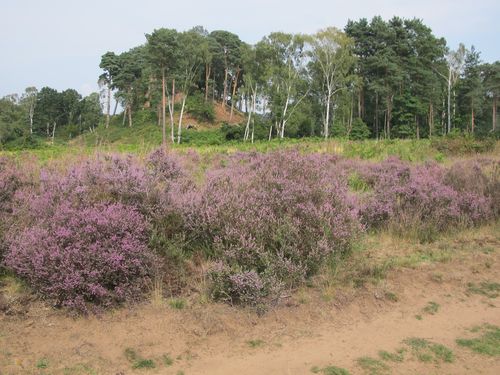
01. Heather in flower Devil’s Spittleful 27 August 2013. Rosemary Winnall
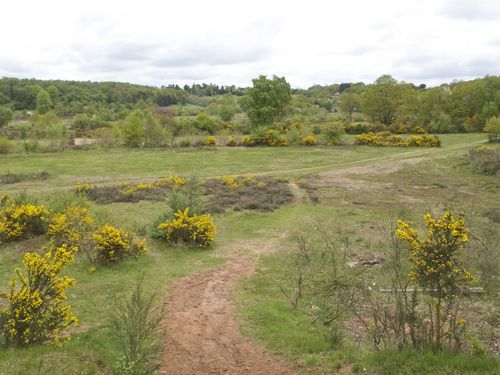
02. The Rifle Range, 18 May 2013. Rosemary Winnall

03. Colletes succinctus, Devils Spittlefull.Rosemary Winnall
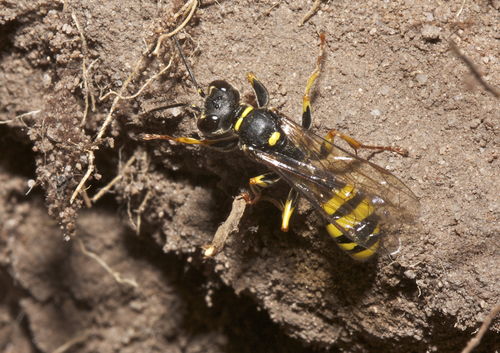
04. Mellinus arvensis, Devil’s Spittleful. Rosemary Winnall
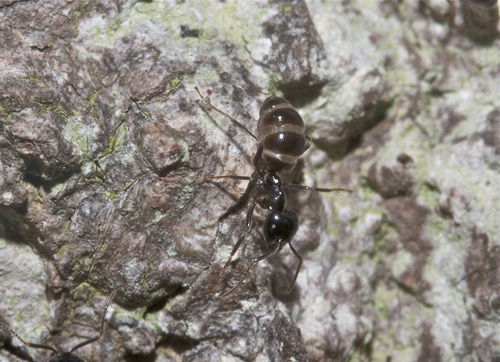
05. Lasius fuliginosus, Devil’s Spittleful. Rosemary Winnall
Worcestershire Record | 35 (November 2013) page: 52 | Worcestershire Biological Records Centre & Worcestershire Recorders
Raptor revelations in Broadway, Worcestershire
Mark E Turner
Red Kites
The Red Kite is happily nowadays a national treasure amongst our native fauna, representing a phenomenally successful reintroduction scheme and featured in countless television programmes. It has become recognisable to even non-bird-watching members of the general public and this is becoming increasingly the case year on year in our locality of Broadway, Worcestershire.
Once again 2013 was no exception, we received a flurry of reports of the ‘Great fork-tailed One’ this summer from Broadway residents beginning 8thJune and finishing 21st July. Except for the last sighting which I will come to, I believe it was the same individual that followed the same west to east route each time, coming from the Cheltenham Road side of the village, which was also significant in the last sighting, and headed off over the escarpment via Fish Hill.
The bird consistently patrolled low and slow over housing estates presenting a surreal experience for those of us lucky enough to be in the right place at the right time. More than once I was in a position to scrutinise through binoculars revealing synchronous moulting of mid-wing remiges and no wing-tags fitted. It begs the question was this bird bred locally and dispersed as a juvenile from its natal home? Red Kites have been resident in the North Cotswolds now for a good twenty years to my knowledge and I believe it is one of the regions best kept secrets regarding roosting/breeding haunts.
Now, that last sighting of the summer was made by a retired couple living in the Cheltenham Road area of the village who are seasoned Kite-watchers of many years. This time however, one Kite had become two and sadly that remains as I write (September) the curtain call to another Milvus mystery.
Hobby
There has been another similar raptor visitation this summer also to the residential estates of Broadway, albeit less obvious to the average passer-by. A handful of us were blessed with visions of the striking Hobby, often hawking resident breeding House Martins around the avenues. Sometimes seen as a pair, sightings were mostly of a marauding individual breaking into dramatic, breathtaking chases down roads and into gardens. We were aware of their presence from 22nd June through August, but have shown to be at large here as late as 15th October, a record from 2007 and an extreme early arrival date was 7th April 2000. They are truly another success story for sure.
Sparrowhawks
During the 2013 breeding season a pair of Sparrowhawks (01) was the subject of a nest monitoring exercise by the wardening team at Broadway Gravel Pit LNR (SP087379). It proved to be a rollercoaster of great entertainment mixed with deep anxiety experienced by the team whilst the hen bird built her eyrie on top of an old Wood Pigeon nest and sat tight through all weathers for 42 days. From that not so old Wood Pigeon nest during the hawks’ rebuild a former tenants egg was dislodged and came to rest amongst the tree’s twiggy branches inches below the nest and miraculously remained there for several weeks. The male hawk meanwhile, kept his mate supplied with regular meals which were always consumed away from the nest.
We learned a lot about hawk behaviour during this period, but sadly the outcome was not what we’d hoped for. The male went missing presumed dead and the female we believe, abandoned the nest in order to feed herself.
Ironically, although we continued to keep watch hoping some miraculous outcome would evolve, we knew it was all over when Wood Pigeons returned to inspect the site.
A more detailed rundown of Sparrowhawk home life will be published in the 2013 Broadway Gravel Pit logbook due out in spring 2014 which will be held at Worcestershire Wildlife Trust HQ and available on request from Helen Woodman for perusing in-house.
Acknowledgement
Photograph by kind permission © Bob Cooper
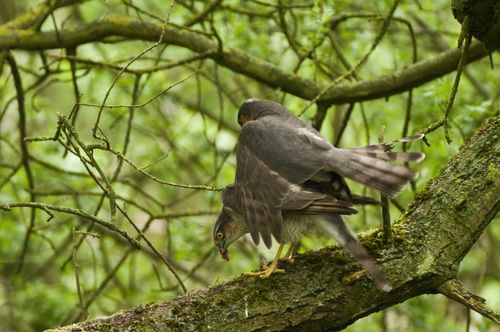
01. Sparrowhawk pair mating. Bob Cooper.
Worcestershire Record | 35 (November 2013) page: 33 | Worcestershire Biological Records Centre & Worcestershire Recorders
Emperor Dragonfly Anax imperator eating butterfly
Roger Umpelby
20 August 2013, warm (25oC-ish) sunny day with little wind. On the western edge of Bredon Hill I was walking across an open grass field and could hear a whirring noise what I assumed to be a dragonfly to my right, nothing unusual, so I carried on walking and then there was a ‘thwack’ sound which I turned to watch and saw a dragonfly labouring across in front of me flying to the left of the path, gradually loosing height grasping something large and white. I watched where it landed 20m or so away on the open grass area so rushed over and 30 seconds later started taking photographs. In probably less than two minutes from the initial catch, the meal was completed and off the Emperor Dragonfly went. I never found the wings so which species of white butterfly it was I cannot confirm, but the size and the difficulty the dragonfly had in remaining air-borne suggests it was a Large White butterfly – ‘circumstantial evidence and not admissible as proof!’.
Images

01. Emperor dragonfly eating white butterfly. Roger Umpelby

02. Emperor dragonfly eating white butterfly. Roger Umpelby
Worcestershire Record | 35 (November 2013) page: 19 | Worcestershire Biological Records Centre & Worcestershire Recorders
Pear Rust Gymnosporangium sabinae
Roger Umpelby
Following the articles in the Worcestershire Record numbers 21 and 22, I was interested to read Harry Green and James Wade’s article on page 18 of Worcestershire Record Number 34, in which they requested pictures of pear rust lesions on pear fruit. The evidence is attached! (01, 02 & 03).
Having seen pear rust on pear foliage in numerous private gardens, commercial dessert and perry pear orchards, and on hedgerow pear trees in the west of England and in Wales, I can confirm lesions on the fruit are extremely rare. The single fruit in the photographs of the variety Doyenne du Comice is the only time I have seen it, and yes it was in my garden in Ashton-under-Hill in 2011! Regarding galls on the alternative host,Juniperus spp., these are much more difficult to find and are probably far less widespread than those on pears, probably because there are far more pear trees than junipers.
Although the pear rust spores produced on pear foliage cannot re-infect pears, the disease can establish on the pear wood as a cancerous perennial growth. With some other diseases the normal air-borne transmission can sometimes be by-passed by a systemic infection developing within the plant and manifesting itself on the new foliage each year. I wonder if this may be happening with pear rust?
Green, H. 2007. Pear leaf gall caused by the rust fungus Gymnosporangium sabinae. Worcestershire Record. 21:49
Green, H. 2007. Pear leaf gall caused by the rust fungus Gymnosporangium sabinae. Worcestershire Record. 22:33
Green, H. & Wade, J. 2013. Pear leaf gall Gymnosporangium sabinae on juniper. Worcestershire Record. 34:18
Umpelby, R. 2007. Pear Rust. Worcestershire Record. 22:34.
Footnote (Ed.).
Pictures 04 & 05 show Pear Leaf Gall on a leaf of Worcester Black Pear renowned for its long-keeping, rock-hard fruit and of course as an emblem of Worcestershire County (the tree) and Cricket Club (three black pears).
Images
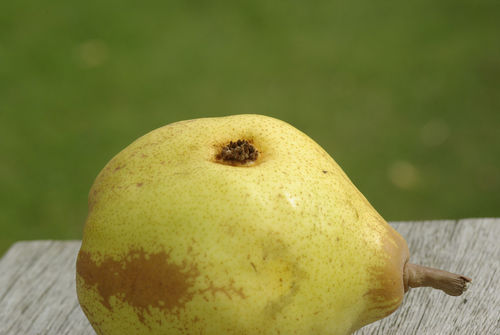
01.Pear rust on Comice fruit. Roger Umpelby
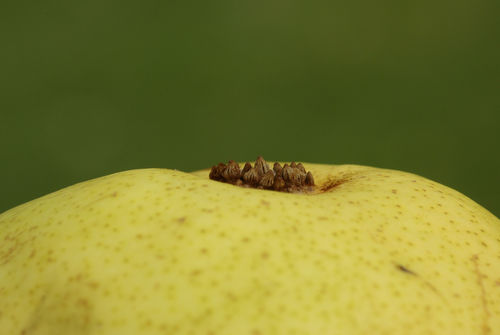
02.Pear rust on Comice fruit. Roger Umpelby
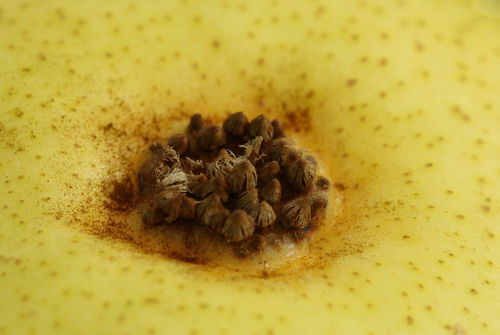
03.Pear rust on Comice fruit. Roger Umpelby
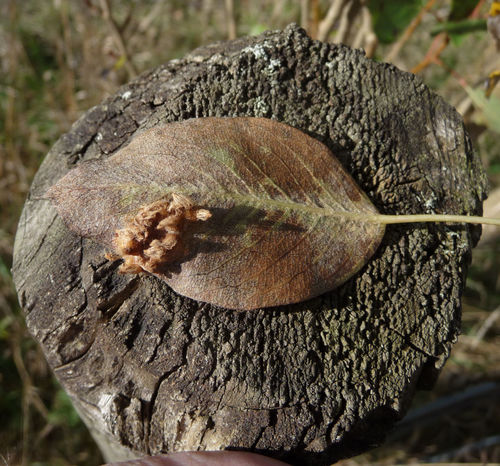
04. Pear leaf gall on Worcester Black Pear. Harry Green
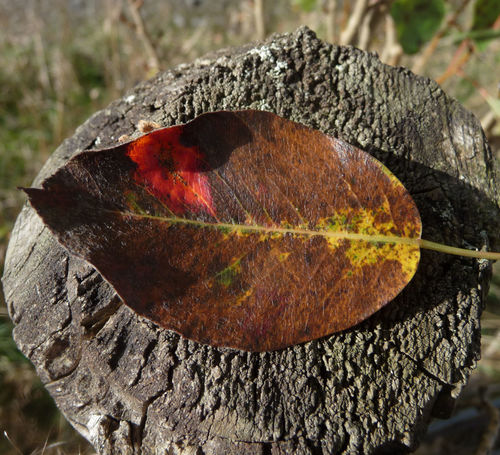
05. Pear leaf gall on Worcester Black Pear. Harry Green
Worcestershire Record | 35 (November 2013) page: 51 | Worcestershire Biological Records Centre & Worcestershire Recorders
Red kites on Bredon Hill
Roger Umpelby
Red kites have been regularly seen in recent years on the main Cotswold scarp from Broadway down towards Winchcombe, and are believed to be nesting above Broadway. One-off sitings of Red Kites have been reported over Bredon Hill for many years, particularly in the last 10-15 years. It seems these sitings over Bredon were of birds ‘passing through’ (or over) as there were no regular sitings.
Things changed in May 2013 when two birds were seen repeatedly above Elmley Castle on the northern slopes of the hill circling over the edge of woodland and over adjacent grass fields. These birds remained there for several weeks, but from late June only one was seen regularly and in late July and through August there were only irregular sitings. In the third week of September two birds re-appeared at the same site, with an unconfirmed report in the last week of September that three birds were present. All of the early reports were from a reliable nature-loving land-owner who periodically had been leaving rabbit and pheasant carcasses out for the birds, but plenty of other Elmley Castle and Comberton residents saw the birds too.
Apart from the Elmley sitings this year, Red Kites have regularly been seen around the east and south of the hill by a number of people. Specific reliable records include:
7 June 2013 – single bird over Teddington Hands (3km south of the hill)
10 June 2013 – single bird over Ashton-under-Hill being mobbed by rooks
11 June 2013 – single bird over Overbury village, again being mobbed
19 September 2013 – single bird over Beckford
19 September 2013 – two birds above Ashton-under-Hill
20 September 2013 – single bird over Ashton-under-Hill.
Hopefully this means that perhaps they bred here this year, and that the skies over Bredon Hill will be graced more regularly by these magnificent birds.
Images

01. Red kite over Ashton-under-Hill. Roger Umpelby
Worcestershire Record | 35 (November 2013) page: 29-33 | Worcestershire Biological Records Centre & Worcestershire Recorders
Glow-worms Lampyris noctiluca near Droitwich Spa: A Semi-quantitative assessment of their distribution and numbers in 2013
D. R. E. Walker
Whilst taking an evening stroll on the evening of 11thJuly 2013, I noticed a small pale green light emanating from the grass beneath a Sweet Chestnut tree in Droitwich Community Woods. On further inspection, I realised that the source of the light was a female Glow-worm Lampyris noctiluca – something I had not seen in the area for over 20 years (last seen near Porters Mill c. 1989). Repeated visits to this and nearby sites over the next month revealed several more glowing females and the presence of at least two small but potentially locally-important colonies of this species. This brief report is an attempt to provide some information as to the size and distribution of the colony at Droitwich Community Woods as well as drawing attention to another relict colony at Harford Hill near Ladywood. It is hoped that this information will help to ensure, where possible, that future management is geared towards their continued survival at these sites.
01. Female Glow-worm, Droitwich Community Woods, 23rd July 2013. D Walker
Temporal Distribution of Sightings and Abundance
02. The bar-chart gives the daily totals of glowing females on each evening visited:
Between 11 July 2013 and 08 August 2013, a total of twelve visits were made to Droitwich Community Woods. Every evening visit between these dates returned positive sightings. The highest daily total of eight glowing females was on the 14th July, followed by five on the 16th July, six on the 18th July and seven on the 23rd July. Between one and three were seen on all other dates.
Harford Hill, near Ladywood, was only visited on one occasion (17th July) when two glowing females were seen along the grass verges of a farm-access track.
Spatial Distribution of Sightings in Droitwich Community Woods
In order to illustrate the distribution of sightings, I have plotted the positions of observed Glow-worms on the following Google Earth maps.
The following icon is used to indicate the location of individual glowing females on the maps below
03. Detailed distribution of Glow-worm sightings, Gorsey Bank (adjacent to Chawson Lane):
04. Detailed distribution of Glow-worm sightings, Chawson Lane Allotments Area:
05. Overall distribution of Glow-worm sightings in Droitwich Community Woods:
06. Chawson Lane Allotments as the ‘glowing season’ progressed. The bar chart (06) shows how the centre of distribution of sightings appeared to shift from the ‘Gorsey Bank’ area to the area around
07. Cumulative Totals for Droitwich Community Woods
Below is an assessment of the total number of glowing females observed in Droitwich Community Woods during the period 11th July – 08th August, 2013:
The above (07) is based on the position of each glowing female and the date that it was seen. Obviously, if an individual was seen in the same area (or within a couple of yards) on subsequent evenings, then it is only counted as one female. In actuality, several individual females were seen in exactly the same place over successive evenings and didn’t appear to change their ‘glowing position’ greatly.
From the above, it is estimated that the Droitwich Community Woods population consisted of at least twenty glowing females in 2013. This is probably an underestimate due to the following factors:
To my knowledge, the presence of the Glow-worms was only ‘discovered’ in this area on 11th July this year. No data for June or earlier in July (when Glow-worms can also be active) is, therefore, available. It is, however, assumed that peak activity probably occurs in July.
Not all areas were surveyed on all evenings, especially the areas between the Roman Way and Chawson Lane Allotments, where chance discoveries prompted more methodical searching on later dates.
Some apparently suitable habitat, such as along the railway line, was not surveyed at all (due to access restrictions). The grassland along the railway could, indeed, provide the main Glow-worm habitat and the ones observed in the Community Woods are merely ‘overspill’ from this ‘reservoir’. It is interesting to note how the distribution is clustered either side of the railway track. Railway embankments could provide corridors of suitable habitat, allowing Glow-worms to colonise new areas.
Specific Habitat Characteristics
The Glow-worms at Droitwich Community Woods appear to be quite catholic in their choice of specific habitat type. However, habitat characteristics in which the Glow-worms were found in order of frequency are given below (figures in brackets refer to the approximate number of individuals):
Open areas of long grass containing herbaceous vegetation, such as Yarrow, Wild Carrot, Meadow Vetchling, Knapweed and Ragwort (7+).
In grass under the canopy of trees such as Ash, Sweet Chestnut, Larch and Cherry (5).
In Bramble / scrub patches (3).
Areas of shorter grass with bare patches and flowering plants such as Lady’s Bedstraw, Birdsfoot Trefoil and Musk Mallow (2). Note: The grasslands of Gorsey Bank, especially, are grazed in patches by Rabbits. Muntjac Deer are also seen regularly in the area.
On short grass verge along busy main road (1) and on verge along quieter access lane (2).
In short-cropped, recently mown grassy areas (0).
For the future conservation of Glow-worms at this site, management regimes should probably aim to maintain the mosaic of these habitats, in order of apparent importance.
The Harford Hill Colony
08 Two glowing females were seen in the locations shown on the 17th July, 2013:
09 The Harford Hill colony is 1.5km due west of the colony at Droitwich Community Woods. The two colonies are likely to be isolated from each other as and they are separated by the Droitwich Canal and the River Salwarpe (as well as intensively-cultivated farmland) and the female Glow-worms are unable to fly.
Further Comments and Discussion
Glow-worms Lampyris noctiluca are generally thought to have declined in the United Kingdom over recent decades, although quantitative data on relative abundance is often scarce and presumptions regarding population trends are often based on anecdotal accounts. In Worcestershire, VC 37, the known distribution of this species is quite sparse and scattered:
10 & 11 Glow-worm Known Distribution in VC 37
Red squares: records 1975 – 2012: Orange Squares: records prior to 1975: Yellow squares: older records
Glow-worms not only have great appeal to naturalists, they also tend to be popular amongst the general public and can be successfully used to champion the cause of the conservationist. The sympathy of the wider public towards such species is likely to be an important positive component of insect conservation. Indeed, local Glow-worm ‘hunts’ have been arranged by bodies such as Malvern Hills Conservators in order to further this aim. Below is a recent newspaper cutting outlining this year’s Malvern Glow-worm event:
12 Extract from Worcester News, July 2013
The central location (within Worcestershire) of the Glow-worm colony in Droitwich Community Woods and its proximity to the inhabitants of both Droitwich Spa and Worcester city would seem to offer an ideal opportunity for similar public events in future years, assuming that the population thrives and that future management of the site encourages their survival.
Glow-worm Conservation
The following are taken from various sources:
“A decline is evident over the entire range of L. noctiluca in Britain. This decline is not restricted to one particular habitat type. A fall in numbers has been observed equally in grassland, fenland, woodland and coastal sand dune habitats. Little empirical data is available as to the actual causes of glow-worm population decline in Britain. A number of theories have been present and one which has been to be investigated is the impact of light pollution. However, much more work needs to be conducted in order to appraise the situation fully.
Habitat destruction is similarly talked about as a potential cause of population decline. Alexander (1992) emphasises that the main objective of management for L. noctiluca should be to maintain vegetation structure and snail populations. Wherever possible, the available L. noctiluca habitat should be extended in an effort to link it to other favourable areas. Patches of scrub and dead wood should be retained within open grassland areas to provide cover for larvae and snails (Alexander 1992).
In some reserves wooden boards have been laid out on the ground to provide additional shelter for glow-worm larvae.
Although there is no clear strategy at present for the conservation of glow-worms, landscape/ habitat management seems to be the principle factor that can practicably be applied to this problem.”
Management of sites (extract from R. Scagell survey website)
“We still do not know why some colonies die out even though there are no obvious factors such as destruction of habitat, use of pesticides or herbicides, or strong artificial lighting of the site. Glow-worms need a supply of small snails as food and therefore a patch of vegetation where they can find the snails. They also need a comparatively open area where the females can display to attract a male in June, July and August. As they retire into the ground during the day, high mowing does not appear to affect them unduly and very long grass may actually not be very suitable.
However, my feeling (in discussion with a keen observer, Linda Worrall of Barrowden, Rutland) is that the best cutting regime is not to cut at all during the glowing season from the beginning of June till the middle or end of August. If cuts are vital they should be restricted to high cutting, so as not to get down to the insects which will be down in the understorey. A certain amount of hay lying on the top is preferable to raking it up, which would probably disturb the Glow-worms, but what you have to avoid is cutting in wet weather which will produce a thick mat of clippings that even the most determined Glow-worm will find it difficult to climb through at night. The females may appear on footpaths and there is therefore a danger period during summer if the path is heavily used in the late evening while they are emerging to glow. There is not much that can be done about this other than getting people to walk in single file. ”
Notes on recent management of Droitwich Community Woods
There must be some aspects of the habitat and conditions in the currently occupied parts of Droitwich Community Woods that Glow-worms find to their liking. It is currently unknown how long they have been present at this site or when they colonised the site. It is hoped that future conservation efforts will ensure their continued survival and, hopefully, their spread. However, some concern has been expressed by me and fellow Glow-worm watchers this year over the management that was carried out around the 1st August, 2013. This removed areas of both bramble scrub and mowed the grassland that held glowing female Glow-worms only a few days before. The mowing carried out was very low and caused damage to the underlying ground, exposing areas of bare soil in several places. It is unknown whether or not this has destroyed any adult Glow-worms, eggs or larvae or whether this will have a detrimental impact on their numbers in following years. However, it is greatly hoped that the impacts of such management regimes are minimised in future, in accordance with guidelines suggested in the previous section, entitled Glow-worm Conservation. The following photographs show the areas affected by the management that was carried out.
13 & 14 Area of removed bramble scrub opposite reserve interpretation board (Photos : M and T Owens). This area was cleared on 1st August 2013. This scrub held glowing female Glow-worms only a few days before. No Glow-worms were seen in this area after the management was carried out.
15 Mown grassland area of Droitwich Community Woods (Photo: M and T Owens). This area held female Glow-worms a few days before the mowing was carried out on 1st August. No Glow-worms were seen in the area after it was mown.
It is probable that delaying mowing of the site until late August or even September would be more beneficial to the Glow-worms present at this site.
Conclusions and Recommendations
In 2013, Droitwich Community Woods supported a colony of Glow-worms which may be of considerable local significance. Frequent visits to this area during July and August allowed a rudimentary assessment of the size and extent of the colony to be made. It is estimated that a minimum population of 20 females was present at this site.
A further extant colony was found to be present near Ladywood at Harford Hill (SO8665661954), although only one visit was made to this site so it is not possible to provide much detail regarding the size or extent of this population. Two females were present here on 17th July, 2013.
The data is provided in order to aid the preservation of this species in this area of Worcestershire.
Glow-worms are attractive insects, they tend to appeal to the general public and can be used as a ‘showcase’ species in order to further the aims of nature conservation in general.
Based on current literature, recommendations regarding the management of these sites (especially the main site at Droitwich Community woods)are as follows:
Maintain the current vegetation structure – a mosaic of open grassy areas interspersed with (bramble) scrub and trees.
Patches of dead wood and scrub retained to provide cover for larvae and snails.
Consider laying out wooden boards in a few places to provide additional shelter for larvae. (Note: A couple of females near the allotments were found adjacent to a discarded wooden pallet).
If possible, delay mowing until after the main glowing season has finished (towards the end of August).
Encourage the spread of Glow-worms to other nearby sites, if possible. Further potentially-suitable grassland exists on the other side of the Droitwich Canal (e.g. Coney Meadow Reserve plus other parts of Droitwich Community Woods). Female Glow-worms have been found on the grass verge of the Roman Way this year and this could provide a literal bridge to these sites if the current population was encouraged to thrive via suitable management of ‘Gorsey Bank’.
Where possible, protect these areas from encroachment of artificial lighting. This may be a factor in future if proposed developments go ahead between Chawson Lane allotments and Copcut Lane.
16 Glowing Abdominal Segments of a Female Glow-worm, Droitwich Community Woods,
References
Alexander, K N A 1992 The Glow-worm, Lampyris noctiluca (L.), in Gloucestershire and its conservation. The Gloucestershire Naturalist. 5: 1-5.
Scagell, Robin. The UK Glow worm Survey http://www.glowworms.org.uk/,
Essex Glow-worm survey www.glowworms.org.uk/glowrep.doc
Conservation of Fireflies and Glow–worms www.firefliesandglow-worms.co.uk/conservation.htm
This paper in another format can be seen at the link below or by searching the internet on Glow-worms and Droitwich. http://www.google.co.uk/url?sa=t&rct=j&q=&esrc=s&source=web&cd=5&ved=0CEIQFjAE&url=http%3A%2F%2Fwww.birdforum.net%2Fattachment.php%3Fattachmentid%3D458167%26d%3D1376648579&ei=Fo6tUowX8p3uBuLfgWA&usg=AFQjCNGIzQ0AiVa2XkFKv7KJ66F7uiC49Q&bvm=bv.57967247,d.ZGU
Two local studies of Glow-worms of interest (Ed):
Clarke, J, & Chandler, S. 2007 Pilot study of Glow-worms lampyris noctilucaon Bredon Hill. Worcestershire Record 23:50-51
Knight, Terry. 2002. Glow-worms at Windmill Hill reserve, North Littleton 1982-2002. Worcestershire Record 13:32.
Images
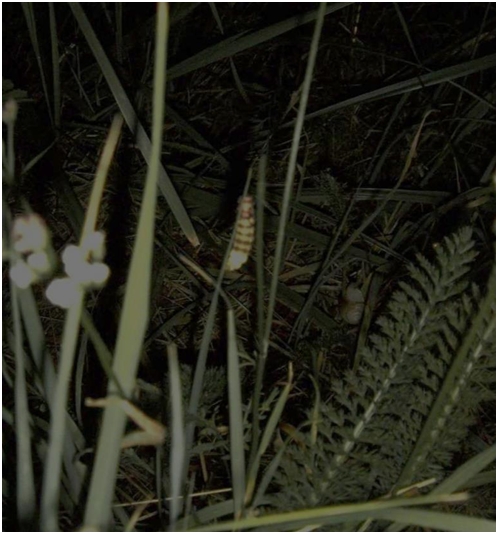
01. Female Glow-worm Droitwich Community Woods 23rd July 2013 Photo D Walker
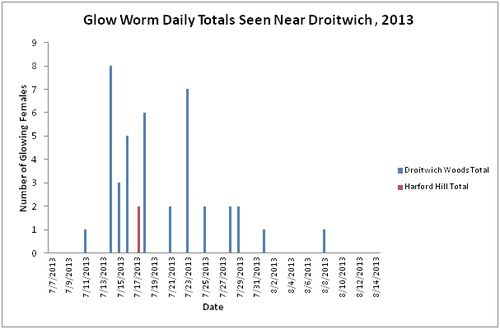
02. Bar-chart below gives the daily totals of glowing females on each evening visited.
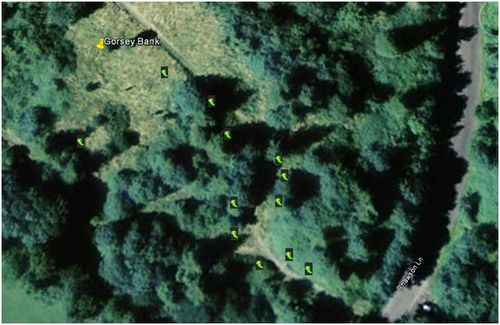
Icon indicates location of individual glowing females.
03. Detailed Distribution of Glow-worm Sightings, Gorsey Bank (adjacent to Chawson Lane
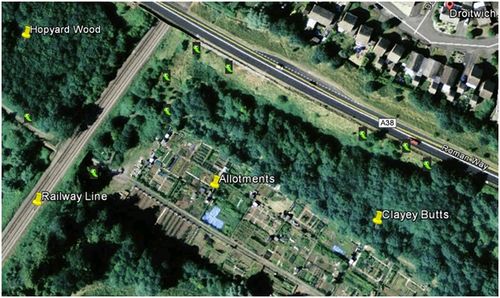
04. Detailed Distribution of Glow-worm Sightings, Chawson Lane Allotments Area.
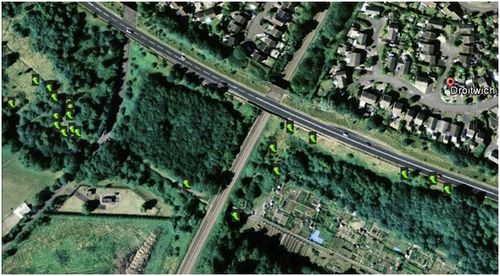
05. Overall Distribution of Glow-worm sightings in Droitwich Community Woods.
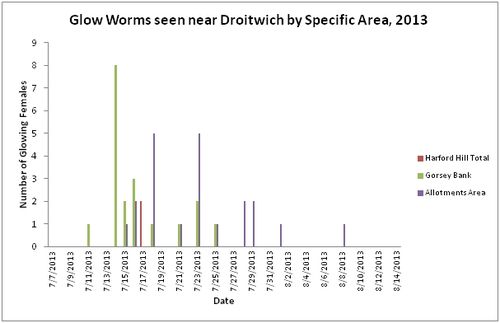
06. Chawson Lane Allotments as the ‘glowing season’ progressed.
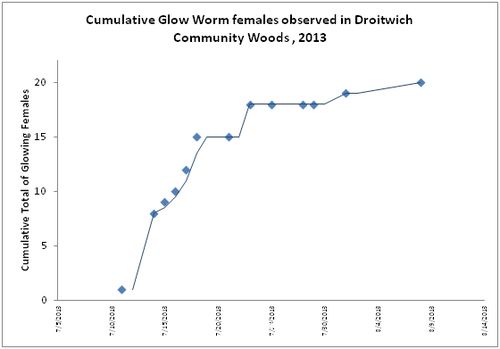
07. An assessment of the total number of glowing females.
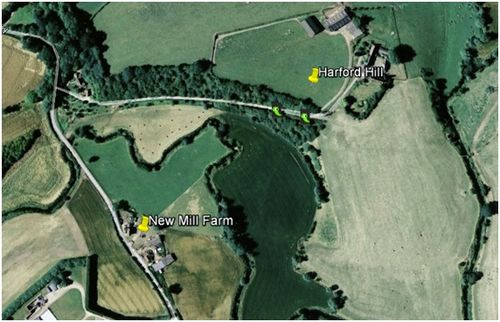
08. The Harford Hill colony two glowing females were seen.
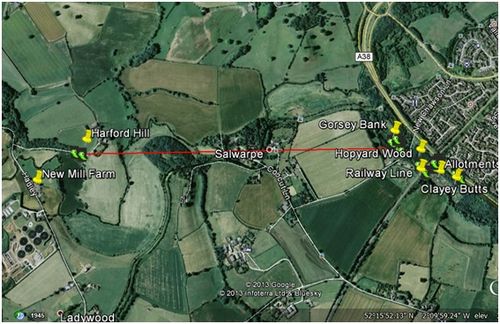
09. The Harford Hill colony is 1.5km due west of the colony at Droitwich Community Woods.

10. Glow-worm Known Distribution in VC 37.
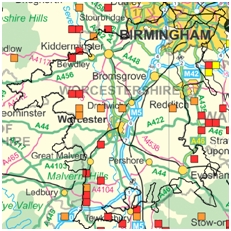
11. Glow-worm Known Distribution in VC 37.
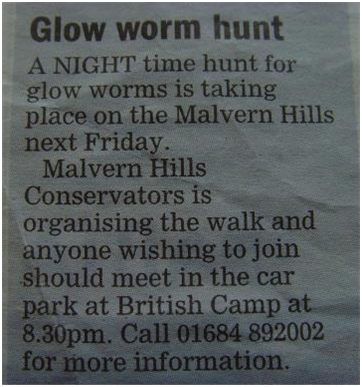
12. Extract from Worcester News, July 2013.
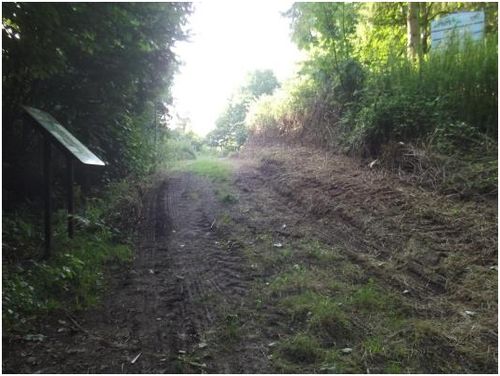
13. Area of removed bramble scrub. M &T Owens
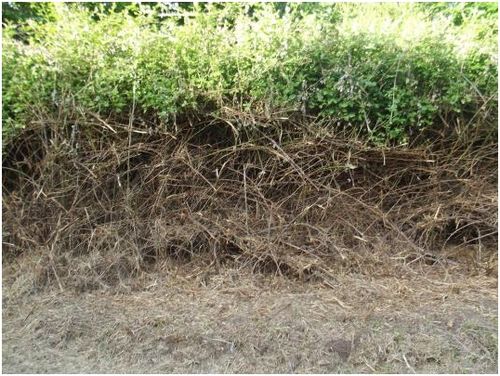
14. Area of removed bramble scrub. M &T Owens
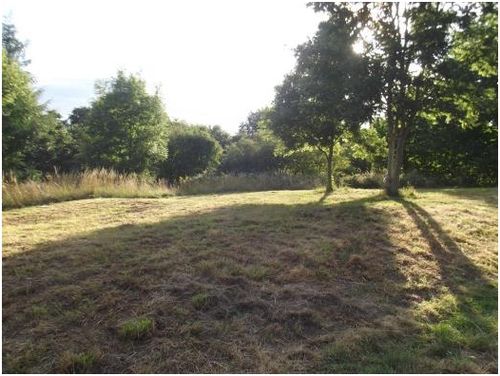
15. Mown grassland area of Droitwich Community Woods. M & T Owens
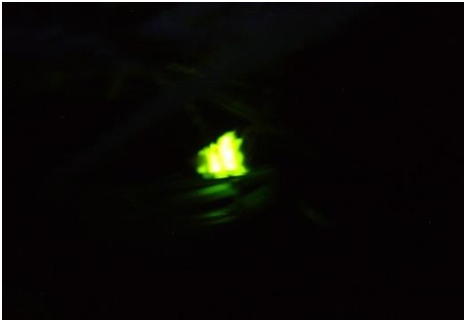
16. Glowing abdominal segments of a female Glow-worm. D. Walker.
Worcestershire Record | 35 (November 2013) page: 43 | Worcestershire Biological Records Centre & Worcestershire Recorders
Ivy Bee Colletes hederae in Worcestershire
Brett Westwood
The ivy bee Colletes hederae is a solitary mining bee, described as new to science in 1993, and it has been spreading northwards through the United Kingdom since it was first seen in Dorset in 2001. By autumn 2012 the most northerly records were from Cheltenham in Gloucestershire. It is the last solitary bee to emerge, appearing in late summer between late August and early November..
On 21 September 2013 I was examining a clump of flowering ivy at Iverley, only 300m north of the Worcestershire boundary in Staffordshire, when I noticed a bee with a pale-banded abdomen and furry ginger thorax feeding on the flowers about 3m above ground. It was clearly a Colletes, and though I couldn’t obtain a photograph , it looked remarkably like the photographs I’d seen of ivy bee, being much larger than other Colletes such as C. succinctus. I contacted entomologist Andy Jukes whose searches in the following week revealed male and female C.hederae about 3km further north at Stourton, also in Staffordshire. Stuart Roberts of The Bees Wasps & Ants Recording
Society (BWARS) later confirmed that Andy’s photographs were of ivy bees and that the presence of males suggested breeding.
At that date as far as we knew these were the only records north of Cheltenham, so the bee seemed to have skipped over Worcestershire. An appeal on the Worcestershire Wildlife Trust website failed to produce further records for the county, so on 28 September I examined flowering ivy in Wolverley churchyard in north Worcestershire. Although it was buzzing with drone flies and other insects, there was no sign of C. hederae. Then I struck lucky in a garden on the edge of the village and found a single female nectaring on ivy growing on a sunlit garden wall. In spite of further searches in the area, I found no others, so this could have been a pioneering female.
This excitement was eclipsed a week or so later by Nigel Jones’ reports of C. hederae in Shrewsbury, an astonishing leap to the north-west. Next autumn, we should keep an eye out for this bee as it’s likely to consolidate its range in Worcestershire, continuing the northward expansion. Colonies are usually very obvious with tumbling balls of males competing for the favours of emerging females. Some colonies have over a thousand nest-holes. Adults fly up to a kilometre in search of flowering ivy, so once seen, it’s worth looking between mid –September and late October on areas of sandy or friable soil, especially if south-facing and on a slight gradient.
Further information can be found on the BWARS website under species accounts or the following .pdf:
Images
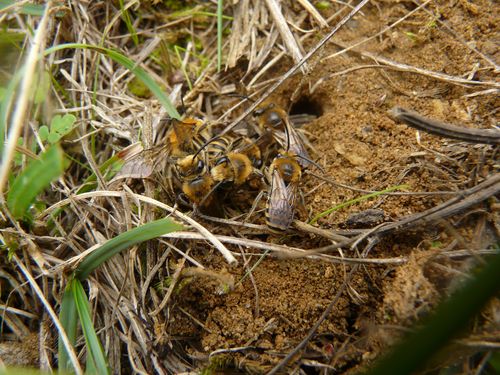
01 Colletes hederae mating cluster. B. Westwood.
Worcestershire Record | 35 (November 2013) page: 47 | Worcestershire Biological Records Centre & Worcestershire Recorders
Further observations on Athous campyloides Newman, 1833 (Col., Elateridae) in Worcestershire
P.F. Whitehead, Moor Leys, Little Comberton, Pershore, Worcestershire WR10 3EH Email: paul@thewhiteheads.eu
Introduction
The Nationally Scarce click beetle Athous campyloides Newman is one of the more enigmatic British terrestrial elaterids and it is only relatively recently that progress has been made in understanding its autecology. Like some of its congeners adult A. campyloides are generally crepuscular with the implication that it may be under-recorded. Mendel & Clarke (1996) indicated that this is a dominantly south-eastern species in England. It was first recorded in the midlands from Worcestershire during 1993 when a dead adult was dissected from the oesophagus of a recently expired Robin (Erithacus rubecula (L., 1758)) at Little Comberton (SO94 30 m a.s.l.) (Whitehead, 1995). That site went on to reveal a breeding population which was markedly synanthropic and also hygrophilous; larvae of A. campyloideswere later found in large volumes of peat-based compost in regularly watered plant containers and in a pile of old damp bonfire ashes (Whitehead, 1998).
In describing A. campyloides new to Wales, Mann (1998) cited records from woodland in or close to Cardiff and from a vegetated shingle bank at Llandaff. Two years later Alexander (2000) provided habitat data for the outlying south Cornish population backed up by reference to the British National Vegetation Classification. Such details can be especially useful when trying to unravel geographic affinities and here A. campyloides was found on cattle-grazed pasture on brown earth. Given this diversity of habitat one may enquire: why is this species apparently so diffusely scattered along its north-western British range-edge?
The autecology of Athous campyloides in the light of recent additional Worcestershire records
Until 2003 A. campyloides was known in Worcestershire only from Little Comberton settlement, then on 14 April 2003, the author found a larva 12 cms deep in clayey alluvium in the valley of the River Avon at North and Middle Littleton (SP04 20 m a.s.l.) only about 40 m from the bankside. This interesting record is the first find of larval A. campyloides in Worcestershire’s open countryside. Although sharing some of the affinities cited by Mann (1998), the habitat is quite dissimilar to that described by Alexander (2000). However he goes on to say that the Cornish site is situated in a valley where the sediments are likely to be both compacted and enriched by cattle which may possibly be to the advantage of A. campyloides.
The rather singular larval tolerances of A. campyloides were confirmed again in Little Comberton (SO94 30 m a.s.l.) on 8 August 2013 (20 years after the first record there and 350 m distant from it) when a mature larva was found 75 cms deep at the contact of a large heap of commercially-produced compost and a sheet of film plastic underlying it. From this, and from the other lines of evidence it seems likely that A. campyloides might be adapted to tolerate significant variations in subterranean air: water ratios and occasional saturation. On 7 March 1996 larvae were found from 20-66 cms deep at Little Comberton in what was mostly clay.
The final recent record of A. campyloides in Worcestershire presently known to me is of an adult male that flew to light at Little Comberton (SO94 30 m a.s.l.) at 2350 hrs on 23 June 2005 in an ambient temperature of 16oC.
As is often stated A. campyloides may well eat the roots of grasses but it is certainly a larval predator of worms (Whitehead, 1998) and doubtless other soft-bodied invertebrates; the larva from the compost bed on 8 August 2013 was in the company of some small worms of the genera Eisenia and Lumbricus. Perhaps A. campyloides selects sediments or sites where the predation of worms, known to respond rapidly to changes in water levels, is made somewhat simpler.
The European range of Athous campyloides
Athous campyloides is a demonstrably west European species found in Belgium, France and Spain and not occurring south-east of Germany although in that country it is believed to be introduced (Cate, 2007). It cannot presently be regarded as Lusitanian because it is scarcely known in Ireland. What does seem clear is that this is a species on which the last word has certainly not been written.
References
Alexander, K.N.A., 2000. The Cornish records for Athous campyloidesNewman (Elateridae). The Coleopterist 9:41-42.
Cate, P.C. 2007. Elateridae pp. 89-209 In: Löbl, I. & Smetana, A. (eds), Catalogue of Palaearctic Coleoptera 4. Apollo Books.
Mann, D.J., 1998. Athous campyloides Newman, 1833 (Elateridae) in Wales, and other species of interest. The Coleopterist 7:18-19.
Mendel, H. & Clarke, R.E., 1996. Provisional atlas of the click beetles (Coleoptera:Elateroidea) of Britain and Ireland. pp. i-ix, 1-73. Ipswich Borough Council Museums.
Whitehead, P.F., 1995. Observations on the British population of Athous campyloides Newman, 1833 (Elateridae) new to the English west midlands. Entomologist’s Monthly Magazine 131:138.
Whitehead, P.F., 1998. Observations on the British population of Athous campyloides Newman, 1833 (Elateridae). The Coleopterist 7:94-95.
Worcestershire Record | 35 (November 2013) page: 47 | Worcestershire Biological Records Centre & Worcestershire Recorders
Worcestershire Record | 35 (November 2013) page: 53 | Worcestershire Biological Records Centre & Worcestershire Recorders
Changes in the behaviour of large gulls Laridae in south Worcestershire during the summer of 2013
P.F. Whitehead, Moor Leys, Little Comberton, Pershore, Worcestershire WR10 3EH Email: paul@thewhiteheads.eu
The purpose of this note is to outline some changes observed by the author in the aerial behaviour of large gulls Larus fuscus graellsii Brehm, 1857 and Larus argentatus Pontoppidan, 1763 during the summer of 2013. They are changes only in the sense that I cannot precisely recall observing them during the past 50 or so years neither can I find references for them.
Towards the end of July 2013, especially in the Pershore/Bredon Hill area of south Worcestershire, large numbers of gulls were observed planing across the wider agricultural landscape moving from one location to another. Typically these groups would number up to about 400 birds forming low level flights calling continuously to such an extent that it became a loud often more or less continuous cacophony of sound over consecutive days. The birds were commented on as seeming noticeably bold. The flight lines covered a considerable area and the birds tended to be dispersed somewhat equidistantly in them so that the arrangement of the birds in flight and their behaviour appeared to be highly organised; they swept back and forth at a height of some 30 metres or so. These movements of birds appeared to be in response to agricultural activity, in some cases grass cutting. The attraction that this has for larger gulls is well-known and nesting birds will travel some distance for the opportunity to catch small dispersing rodents. What was different about 2013 was the scale of the attraction and the duration of these assemblages which persisted into August for more than three weeks in total.
A second feature of these assemblages was the use made by the gulls from time to time of thermal air currents. Flocks of gulls would not only utilise thermals (in itself not unusual and sometimes observed where gulls congregate inland), but completely fill them thus enabling the physical dimensions of the upwelling air masses to be observed and calculated. The gulls were found to be using thermals with a diameter varying from c110 metres to c140 metres (01) and with a height up to 350 metres. Large numbers of gulls would elevate to these heights eventually achieving significant lateral movement from the collapsing tops of the actively deforming masses of warm air. Seemingly they were using these thermals to leave the area and thus may have been roving the landscape; wherever these mostly adult birds originated from it seemed that on some days they were travelling widely. I discussed this matter with a number of people from which it appeared that this behaviour extended over a wider area. An observer in south Wales some 100 kms distant thought that more gulls than usual had ‘moved inland’ at this time possibly as a response to grass cutting for silage. Explanations for this behaviour might lie with developing changes in agricultural technology or in the ability of gulls to capitalise on food resources.
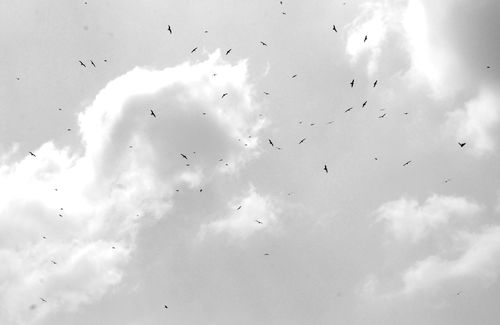
(C)PFWHITEHEAD
01. Large gulls Larus spp, rotating in and filling an upwelling thermal c110 m wide moving east and using it to vacate the area. Little Comberton, Worcestershire, 26 August 2013. P. F. Whitehead
Worcestershire Record | 35 (November 2013) page: 50 | Worcestershire Biological Records Centre & Worcestershire Recorders
Conservationist oblivious to attention of Red Kite Milvus milvus L., 1758
P.F. Whitehead, Moor Leys, Little Comberton, Pershore, Worcestershire WR10 3EH Email: paul@thewhiteheads.eu
During 2013 Red Kites Milvus milvus L., 1758 attempted to nest on Bredon Hill, Worcestershire, the outcome of which is maligned. Birds were seen from January but left the area by July after the nest ‘failed’. The two birds evidently came from an area where they had received some ‘positive human intervention’ and were relatively tame. Many people enjoyed watching them especially along the eastern flank of Bredon Hill.
These kites demonstrated their opportunism in a variety of ways. On 26 January 2013 one approached us closely whilst searching a strandline in the valley of the River Avon at Nafford. Particularly notable was their interest in domestic rubbish containers commonly known as wheelie bins.
On 5 June 2013 Pershore Road in Little Comberton, Worcestershire (SO94), was decorated with its weekly display of these bins. Driving along this road at 11.51 hours my wife and I were confronted by a sight which is certain to remain unique for all time. A certain George Henry Green was observed to be peering intently into his wheelie bin apparently pleading communion with an invertebrate characteristic of this little-studied habitat. He was wholly unaware that he was in the good company, a mere nine metres above him, of a stalled buoyant Red Kite also looking downward into the bin but with slightly different intent (01).
Having been totally ignored by George Henry Green the Red Kite proceeded towards its nest site following and inspecting the roadside line of wheelie bins en route.
Images
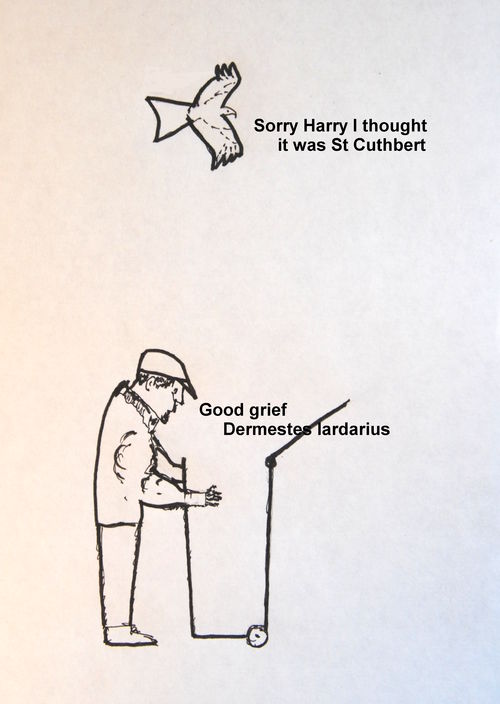
(C)PFWHITEHEAD
01. Conservationist oblivious to overhead Red Kite Milvus milvus, Little Comberton, Worcestershire, 5 June 2013. © P.F. Whitehead.
Worcestershire Record | 35 (November 2013) page: 34 | Worcestershire Biological Records Centre & Worcestershire Recorders
Emperor Dragonfly Anax imperatorLeach, 1815 (Odonata, Aeshnidae) taking Peacock Butterfly Inachis io (L., 1758) (Lep., Nymphalidae) in flight
P.F. Whitehead, Moor Leys, Little Comberton, Pershore, Worcestershire WR10 3EH Email: paul@thewhiteheads.eu
It is well-known that dragonflies of the genus Anax are able to capture larger insects in flight, including other dragonflies (Longfield, 1937) and some relatively large insects (Askew, 1988) although this is perhaps seldom observed.
On a warm 26 July 2013 at Wick Worcestershire (SO94 23 m O.D.) I observed two Emperor Dragonflies coursing across a weedy field. Without any reduction in speed one of these caught a Peacock butterfly flying at a height of some three metres which was later consumed in low herbage (01).
References
Askew, R.R., 1988. The dragonflies of Europe. pp. 1-291. Harley Books, Colchester.
Longfield, C., 1937. The dragonflies of the British Isles. pp. 1-220. Frederick Warne & Co. Ltd, London and New York.
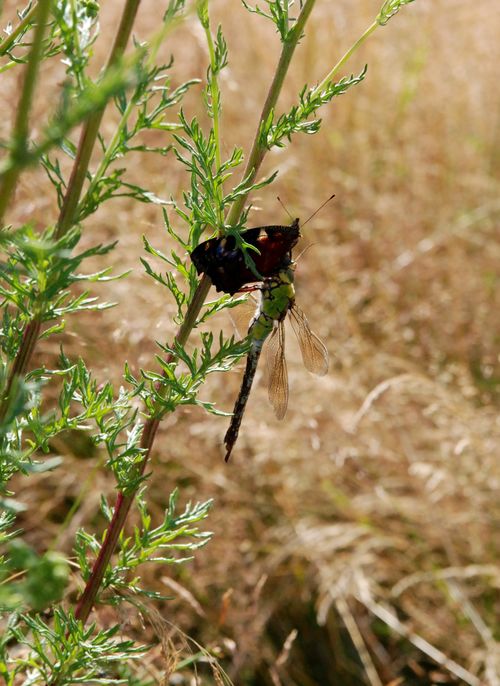
(C)PFWHITEHEAD
01. Female Emperor Dragonfly Anax imperator consuming Peacock Butterfly Inachis io Wick Worcestershire 26 July 2013. P.F. Whitehead.
Worcestershire Record | 35 (November 2013) page: 47-48 | Worcestershire Biological Records Centre & Worcestershire Recorders
Notable invertebrates including Rhizophagus oblongicollis Blatch & Horner, 1892 from the Grafton Wood area of Worcestershire during 2013
P.F. Whitehead, Moor Leys, Little Comberton, Pershore, Worcestershire WR10 3EH Email: paul@thewhiteheads.eu
Grafton Wood at Grafton Flyford, a nature reserve jointly owned by Worcestershire Wildlife Trust and Butterfly Conservation, hosted a ‘Brown Hairstreak Open Day’ on 25 August 2013. Since this is a site I seldom visit I used the opportunity to overview one or two other habitats in the vicinity which revealed a number of interesting invertebrates on that day. The 10 km Ordnance Survey map square is SO95 throughout and the altitude is in the area of 39 m a.s.l.
Senile open-grown veteran trees in the Church Farm area
Rhizophagus oblongicollis Blatch & Horner, 1892 (Col., Monotomidae) RDB1 AW1 (sensu Alexander, 2004)
Some findings from these open-grown trees in this area have already been published (Goddard, 1998) and their fauna aligns with regional knowledge of the entomology of such trees. Their fungal interest is also significant. Somewhat unexpected was a single example of the rare monotomid Rhizophagus oblongicollis Blatch & Horner amongst fallen heartwood fragments at the base of an oak tree (Quercus robur L.). This Red Data Book-listed beetle, whilst is almost certainly under-recorded has one previous Worcestershire record when an example taken by Mr D.M. Green at Piper’s Hill, Bromsgrove (SO96 155 m a.s.l.) was sent to me for identification. This was found in an ‘Owen Trap’ set during 2001 (trapping protocols and some results can be found in Owen 1999, 2000). Some regional context for R. oblongicollis was provided by Whitehead (1993) describing a specimen from Toddington in Gloucestershire. A further record is of one at the base of a mature open-grown oak on the floodplain of the River Severn near Tewkesbury, Gloucestershire SO83 16 m a.s.l. on 2 February 2006 (Whitehead, unpublished). Rhizophagus oblongicollis is one of the rarer British Rhizophagus with a scattered distribution in England where it is usually, but not invariably (Owen, 2000) found singly. It has not been found on Bredon Hill but is almost certain to occur there.
Prionychus melanarius (Germar, 1813) (Col., Tenebrionidae) RDB2 AW1
A single larva of Prionychus melanarius was found amongst comminuted heartwood fragments by the base of a senile open-grown oak tree (Quercus robur L.). This is the rarer of the two British Prionychus and is significantly less anthropocentric than Prionychus ater (F., 1775).
Grafton Wood
Corizus hyscyami (L., 1758) (Hem., Rhopalidae)
A single adult was observed feeding on a developing seed-head of Saw-wort Serratula tinctoria L. Post-breeding adults have a predilection for seeds heads of Asteraceae (Whitehead, 2008) and this was no exception.
Sepedophilus testaceus (F., 1792) (Col., Staphylinidae) Nationally Scarce Nb
A single example of this widespread localised subcortical mycetophilous staphylinid was under the loose decaying bark of a felled larch (Larix sp.). Rarely on conifers although there is some evidence to suggest that larch is favoured.
Prionychus melanarius (Germar, 1813) (Col., Tenebrionidae)
A single larva of Prionychus melanarius (Germar) was found under the bark of a long-felled larch Larix sp. This appears to be an exceptionally rare finding; of the 138 certain British entries for this species on my database this represents the only breeding record on Coniferae. The same comment applies slightly less so to Prionychus ater (F.); in continental Europe I have records of P. ater breeding on Grecian Fir Abies cephalonica Loudon and on Scots Pine Pinus sylvestris L. in Latvia.
Ancistrocerus oviventris (Wesmael, 1836) (Hym., Vespidae)
A single example of this species which is rather rare in the midlands was found resting on a large pile of old oak logs which is sometimes employed as a nest site.
Grafton Wood orchard
It was pleasing to observe a suite of stenotopic mistletoe invertebrates including Hypseloecus visci (Puton, 1888), Pinalitus viscicola (Puton, 1888), Cacopsylla visci (Curtis, 1835) and Ixapion variegatum (Wencker, 1864) and encouraging to see the egg-wintering mirids. In some parts of Britain populations of P. viscicola appear to have been badly affected by the long cold spring of 2013.
References
Alexander, K. N. A., 2004. Revision of the Index of Ecological Continuity as used for saproxylic beetles. English Nature Research Report 574. English Nature Peterborough
Briggs, J. 2011. Mistletoe and mistletoe insects, overview and observations from 2010. Worcestershire Record 30:9-15.
Goddard, D.G., 1998. Coleoptera in: Grafton Wood recording day. Worcestershire Record 5:27-30.
Owen, J. A., 1999. Beetles occurring underground at the roots of old trees on Ashtead Common, Surrey, Great Britain. Entomologist’s Gazette 50:59-67.
Owen, J. A., 2000. Coleoptera occurring underground at the roots of old trees. Entomologist’s Gazette 51:239-256.
Whitehead, P.F., 1993. A recent British record of Rhizophagus oblongicollisBlatch & Horner 1892 Entomologist’s Gazette 44:20.
Whitehead, P.F., 2008. Observations on the ecology of Corizus hyoscyami(L., 1758) (Hemiptera, Rhopalidae) and the British influx of 2006. Entomologist’s Monthly Magazine 144:163-176.
Worcestershire Record | 35 (November 2013) page: 47-48 | Worcestershire Biological Records Centre & Worcestershire Recorders
Worcestershire Record | 35 (November 2013) page: 48-49 | Worcestershire Biological Records Centre & Worcestershire Recorders
Notes on Ctesias serra (F., 1792) (Col., Dermestidae) including a breeding record on Wellingtonia Sequoiadendron giganteum (Lindley) Buchholz in Worcestershire
P.F. Whitehead, Moor Leys, Little Comberton, Pershore, Worcestershire WR10 3EH. Email: paul@thewhiteheads.eu
The Dermestidae is an interesting family of beetles, not only for the distinctive ‘woolly bear’ morphology of many of its larvae but for their ability to consume dry organic matter including keratin and chitin in natural history collections. Neglected collections of Victorian butterflies and moths were sometimes totally destroyed when populations of Anthrenus spp. became infestations. One group of dermestids, the Megatominae, occur most usually only in the wild where they are mostly associated with trees. Ctesias serra(F., 1792) is one such example whose larvae have conspicuous tufts of long spear-tipped setae on the posterior third of the abdomen so that in life they appear to be hauling small bundles; they live most usually under or in bark and like most dermestids prefer dry niches. A comprehensive highly commended guide to dermestids is that of Peacock (1993).
On 19 October 2013 I found larvae of C. serra in the thick soft bark of a Wellingtonia Sequoiadendron giganteum (Lindley) Buchholz in my garden in Little Comberton, Worcestershire (SO93).. The tree was grown from a seed sown during 1975 and is now a significant landscape feature with a trunk circumference of 2.6m measured 1.8m from the ground. Ctesias serrararely occurs on conifers but Peacock (1993) includes a citation for the related Redwood Sequoia sempervirens (D.Don) Endl. Other potential coniferous host trees are intimated by my records of adults on fir Abies sp. (also cited by Peacock, 1993) at Spetchley Park, Worcester (SO85) on 30 June 1985 and at resin on a recently felled Douglas Fir Pseudotsuga menziesii (Mirbel) Franco at Toddington, Gloucestershire (SP03) on 23 June 1987. I know of no other breeding records on Wellingtonia.
Larvae of C. serra are generally subcortical although on Wellingtonia and Sycamore they occur in dry fissured and exfoliated bark; wherever they occur they are usually scavengers on the remains of invertebrates in and around the webs of bark-dwelling spiders. Such fragments on the Little Comberton Wellingtonia included those of the conifer-associated weevil Pachyrhinus lethierryi (Desbrochers, 1875) bringing with it the implication that this relatively recent admission to the British fauna (Plant, Morris & Heal, 2006) is now associated with this Nearctic tree.
In Britain I have records of larvae of C. serra throughout the year and adults throughout May, June and July with eclosed adults in situ during late April. C. serra evidently has no documented Quaternary history in Britain although prior to Alexander (2004) it was regarded as a weak indicator of historical continuity through ancient woodland. Although populations may burgeon on large veteran trees in ancient pasture woodlands due to the high surface area of the pabulum and the range of niches available on a single tree, C. serra is an example of the many woodland beetles that have become culture-favoured through their acceptance of cultivated trees in orchards, civic parks and arboreta.
British host trees known to the writer include cultivated plum (rarely and then most usually on veteran trees), apple and pear, wild hedgerow pear, Pedunculate and Sessile Oak (on veteran trees especially), ash Fraxinus excelsior L. (especially), Sweet Chestnut, Horse Chestnut, Sycamore, Field Maple, White Willow, Crack Willow and cultivated hybrid Poplar although not all my data is mechanised. Interactive groups of >10 larvae have been observed on Field Maple and White Willow.
Ctesias serra is dominantly a lowland species in England and Wales and rare in Scotland. It is remarkable that dermestids are up to now unrepresented amongst Irish saproxylic Coleoptera (Alexander & Anderson, 2012). My experience is that larvae descend almost to sea level; the highest breeding record in Worcestershire is at 170 m a.s.l but in the extreme south of France I have found larvae at 745 m a.s.l. although the species was not cited for its saproxylic interest there by Brustel (2004). Ctesias serra is widespread in Europe.
References
Alexander, K. N. A., 2004. Revision of the Index of Ecological Continuity as used for saproxylic beetles. English Nature Research Report 574. English Nature Peterborough.
Alexander, K. N. A. & Anderson, R., 2012. The beetles of decaying wood in Ireland: a provisional annotated checklist of saproxylic Coleoptera. Irish Wildlife Manual 65. National Parks and Wildlife Service, Department of the Arts, Heritage and the Gaeltacht, Dublin, Ireland.
Brustel, H., 2004, Coléoptères saproxyliques et valeur biologique des fôrets françaises. Collection dossiers forestiers 13. Office National de Fôrets, Paris. 297pp. (Doctoral thesis, Institut National Polytechnique de Toulouse).
Peacock, E.R., 1993. Adults and larvae of hide, larder and carpet beetles (Coleoptera:Dermestidae) and of derodontid beetles (Coleoptera:Derodontidae). Handbooks for the identification of British insects 5(3). Royal Entomological Society of London.
Plant, C.W., Morris, M.G. & Heal, N.F. 2006. Pachyrhinus lethierryi (Desbrochers, 1875) (Curculionidae) new to Britain and evidently established in south-east England. The Coleopterist 15: 59-65.
Images
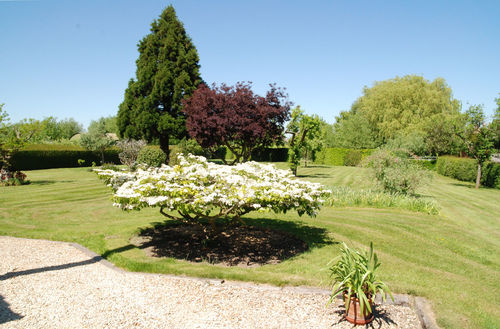
01. Ctesias serra larvae on horse chestnut. G. H. Green.

02. Garden with Wellingtonia utilised by Ctesias serra. P. F. Whitehead.
Worcestershire Record | 35 (November 2013) page: 15 | Worcestershire Biological Records Centre & Worcestershire Recorders
A New species of Waxcap Gliophorus reginae in Worcestershire.
Rosemary Winnall
In 1998 our family moved into Willow Bank, a cottage at Bliss Gate about 3 miles west of Bewdley. Three acres of land came with the cottage, two of which are an interesting mix of unimproved meadow, bluebell copse, gorse scrub with heather, and a small stream.
It soon became apparent that the grassland was good for waxcap fungi and I started to document what appeared where and when. Over the next few years, 21 species of waxcap, several Fairy Clubs and Earth Tongues, and a range of other associated grassland fungi had been identified with the help of several mycologist friends.
But there was one particular waxcap that I could not identify. It had a viscid pinkish/purple cap and flexuose stipe flushed orange/pink (01 & 02). It looked to me like a variety of the Pink Waxcap Hygrocybe calyptriformis. I sent dried specimens off to the mycological department at Kew in 2000 (K(M)156265), and the reply came back that it was a variety of the Parrot Waxcap Hygrocybe psittacina.
However, 2011 saw the start of the three-year DERFA-funded ‘Project Waxtongue’ involving mycologists at Kew and Aberystwyth University researching the taxonomy of species of waxcaps Hygrocybes and earth tongues Geoglossums in the United Kingdom and their feeding mechanisms. As part of this project, I submitted more dried collections of this unusual fungus that were received with interest and a request to see it in situ if it fruited again.
A single toadstool appeared unusually early in October 2012, but was unfortunately broken off by the time I found it. Then we had to wait until January 2013 until the main flush of toadstools came up. To protect them from rabbit damage and frost, I caged them and covered them in bubble wrap until Dr. Martyn Ainsworth from Kew could visit (03).
As a result of this DNA research project, the Willow Bank 2008 collection (K(M)156265) has become the holotype for a brand new species! It has been named Gliophorus reginae to commemorate the diamond jubilee of Her Majesty Queen Elizabeth II in 2012 and the 60th anniversary of her coronation in 2013.
The published account of this work (in Issue seven of MycoKeys) is titled -“DNA barcoding and morphological studies reveal two new species of waxcap mushrooms (Hygrophoraceae) in Britain” A. Martyn Ainsworth, Paul F. Cannon, Bryn T. M. Dentiger. It can be found by following this link: http://www.pensoft.net/journals/mycokeys/article/5860/abstract/dna-barcoding-and-morphological-studies-reveal-two-new-species-of-waxcap-mushrooms-hygrophoraceae-in-britain, doi: 10.3897/mycokeys.7.5860. http://www.pensoft.net/asearch_list.php?ttar=da&search=Gliophorus+reginae&IN=Journals&TIP=&Image100.x=21&Image100.y=10
This species has appeared at Willow Bank in the following years: 2000, 2001, 2002, 2004, 2005, 2006, 2007, 2008, 2010, 2012, 2013. It seems to fruit later than other waxcaps and I have recorded it in November, December and January, with only one record of a single cap in October. The lateness of the fruiting period may mean that it has been overlooked in other waxcap-rich areas. In addition to this single record in Worcestershire, it has been recorded from a cemetery in Pembrokeshire and fields in Staffordshire and Derbyshire. So it is worth checking likely places during the winter, and it might be found elsewhere in Worcestershire!
Images
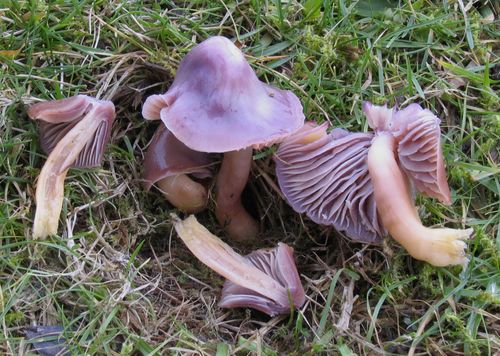
01. Gliophorus reginae, Willow Bank, Bliss Gate, 10 November 2004. Rosemary Winnall
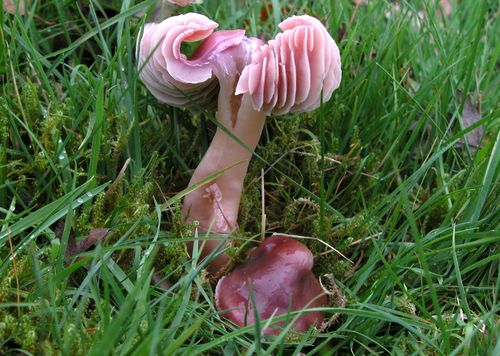
02. Gliophorus reginae, Willow Bank, Bliss Gate, 23 January 2008. Rosemary Winnall
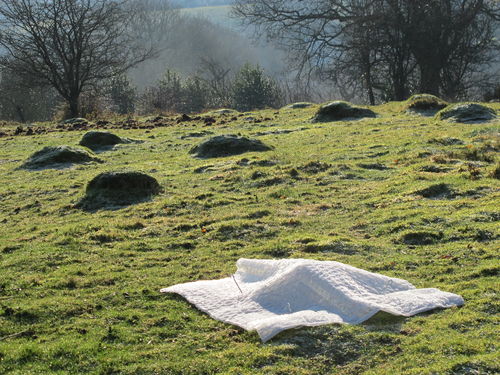
03. Covered Gliophorus reginae to show location, Willow Bank, Bliss Gate, 15 January 2013. Rosemary Winnall
Worcestershire Record | 35 (November 2013) page: 16-17 | Worcestershire Biological Records Centre & Worcestershire Recorders
A new Harvestman in the Wyre Forest. Sabacon viscayanum subsp. ramblaianum Martens, 1983
Rosemary Winnall with Nicki Farmer
On 12th October 2013 the Wyre Forest Study Group, in conjunction with the Conchological Society of Great Britain and Ireland, ran a field meeting at Hawkbatch, one of Wyre’s Forestry Commission woodlands. Although this ancient, semi-natural woodland is located in modern Worcestershire just north of Bewdley, the vice county is actually VC 39 Staffordshire.
The event was titled Slugs and Land Caddis and we aimed to increase our knowledge of the distribution within Wyre of the Lemon Slug Malacolimax tenellus and the Land Caddis Enoicyla pusilla, the male of the latter is on the wing at this time of the year. 15 participants attended and we had experts with us in mycology, hymenoptera, diptera, coleoptera and orthoptera as well as molluscs, so we were recording fungi and several different groups of invertebrates as we moved slowly through the trees in this mixed woodland.
I started identifying and recording harvestmen about three years ago and one of our participants – Nicki Farmer – kindly brought me specimens during our walk. Some I could identify with a hand lens and others I collected for a closer look under the microscope. As soon as I saw this individual, I knew it was a special find, but did not realise at the time just how restricted its distribution was. Its body was about 4mm long, but it was the large and unusual pedipalps that were immediately conspicuous. They were longer than the body, swollen, and covered in many spines and hairs. They give the harvestman a rather front-heavy appearance and make the identification unmistakable (01, 02, 03 & 04).
The habitat in which this female Sabacon viscayanum subsp. ramblaianumwas discovered at grid reference SO765776, is a narrow belt of oak/birch/holly trees along the side of a forestry track on the edge of a conifer plantation of mature Western Hemlock Tsuga heterophylla and Douglas Fir Pseudotsuga menziesii (05 & 06). Conifer had been removed from this 20m strip during the winter of 2011/12. As a result there are areas of open ground, mossy conifer stumps and leaf litter. Some plants of disturbed soil such as Foxglove Digitalis purpurea, Common Hemp Nettle Galeopsis tetrahit and Wood Avens Geum urbanum have seeded in, and Western Hemlock saplings proliferate in some places. Soft Rush Juncus effusus indicates the presence of a few damp areas along the extraction route, and on less disturbed ground there are occasional patches of Bilberry Vaccinum myrtillus, Wood Melick Melica uniflora and Creeping Soft Grass Holcus mollis, with Bramble Rubus fruticosus agg. and Bracken Pteridium aquilinum growing alongside the forest track.
When Nicki found this harvestman it was on some low-growing vegetation, although we could not relocate the exact spot to collect more precise details. Whether we had disturbed it from the leaf litter as we walked through or not, we do not know.
This species was first found in Great Britain in September 1980 in woodland at Parkmill, Gower, Glamorgan (Abbot 1981). By 1999 it had been found from 22 sites in South Wales, including one near Presteigne that is actually just across the border into England (Hillyard 1999). So the Wyre Forest record is not the first English record! There is some discussion about whether this species is native to the UK or an introduction. Although some of the sites are close to industrial workings, it has also been found in old damp woodland, which is its usual habitat elsewhere in its range.
I remember there was some felling work in Hawkbatch a few years ago when the Forestry Commission’s warning signs were in both Welsh and English, which provided some comment from the locals at the time. With the movements of forestry vehicles and contractors, could this little harvestman have been introduced in the soil on a forest vehicle? Or has it been here all the time? We must look at more sites across the Wyre Forest and see if we can find it in more remote locations!
References:
Abbot, R.H.R. 1981. A new opilionid to Great Britain. Newsletter British Arachnological Society 30:4.
Hillyard, P.D. 2005. Harvestmen. Synopses of the British Fauna No. 4. (Third Edition). Field Studies Council, Preston Montford.
Morgan, I.K. 1990. Notes on the Ecology and British Status of the Opilionid Sabacon viscayanum subsp. Ramblaianum. Dyfed Invertebrate Group Newsletter 19: 15-18
Ocularium, Newsletter of the Opiliones Recording Scheme No 2 November 1999. Ed. Paul Hillyard
Images
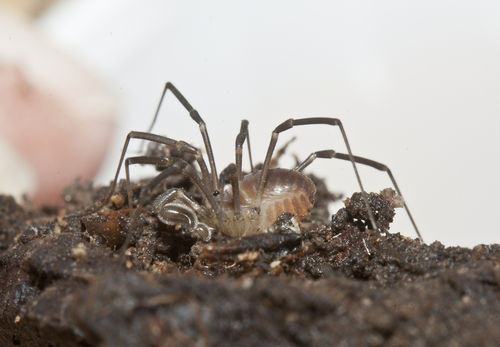
01. Sabacon viscayanum ramblaianum Wyre Forest. Rosemary Winnall.
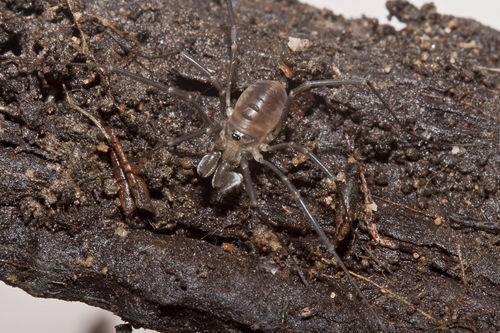
02. Sabacon viscayanum ramblaianum Wyre Forest. Rosemary Winnall
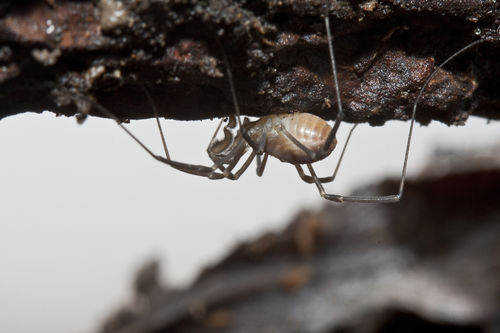
03. Sabacon viscayanum ramblaianum Wyre Forest. Rosemary Winnall
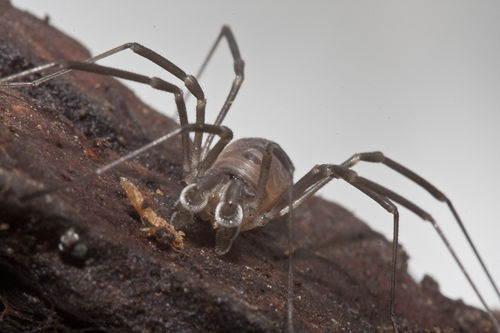
04. Sabacon viscayanum ramblaianum Wyre Forest. Rosemary Winnall
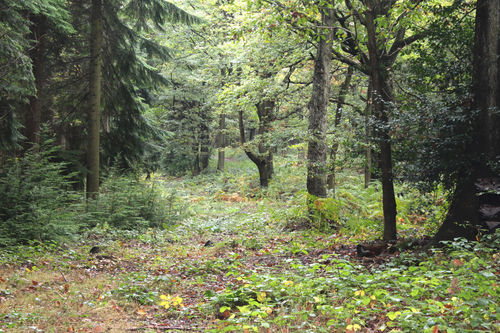
05. The habitat of Sabacon viscayanum in Wyre Forest. Rosemary Winnall

06. The habitat of Sabacon viscayanum in Wyre Forest. Rosemary Winnall
